

TWENTIETH CENTURY .ENGLISH
.BIBLES
for
AVID. COLLECTORS
ALL reviews are the copyrighted property of
Mr. Gary S. Dykes © 2006, 2023
Value suggestions - by Mr. Dykes
collecting Bibles Bible version rare collection
or simply scroll down. Very large reviews are in a separate PDF file.
This is a work in progress. I have about 135 Bible
editions yet to review, I will upload, regularly new reviews.
Send comments, corrections et cetera to: galeandgary2000ATgmail.com
I designed these pages on a 20" monitor, using Blue Griffon, Sea
Monkey, Kompozer as well as Dreamweaver.
I did not design these pages for small hand-held monitors.(smart phones et
al)
|
BOOK TITLE, or Editions |
|
1881-----------1881(ERV) English Revised Version
1901-----------(ASV) American Standard
Version
1901-----------Modern
American Bible -
Frank Schell Ballentine (Revised in 1909) 1901-----------Letters of St. Paul - A. S. Way
(see 1950 entry) 1901-----------Messages of the Bible - Sanders and Kent (editors) 1902-----------W. B. Godbey’s translation 1902-----------The Emphasized New Testament - Joseph Bryant Rotherham 1902-----------Twentieth Century New Testament 1902-----------Reference Passage Bible - I. N. Johns 1903-----------The New Testament in Modern Speech - R. F. Weymouth
1904-----------Worrell's New Testament - A.
S. Worrel 1904------------Twenty-Four
Books of the Holy Scripture - Leeser 1905------------The
Corrected English New Testament - Lloyd 1906------------Holy
Bible in Modern English - Ferrar Fenton
1907-----------Moulton's
Modern Reader's Bible - Richard C. Moulton 1907-----------New Testament - Kurt Stage (German only) 1908-----------Genders
- Holy Bible for Daily Reading
1909-----------Weaver's New Testament - S.
Townsend Weaver 1909------------Scofield
Reference Bible 1910------------Monser's
Cross Reference Bible 1912------------Bible
Union, Improved Edition 1913------------Authorized Version, Corrected - Clarke
1914-----------Numeric
New Testament - Ivan Panin
1914-----------Cunnington's
New Testament - E. E. Cunnington 1916-----------Twenty-Four
Books of the Old Testament - Harkavy
1917-----------The
Holy Scriptures According to the Masoretic Text -
Jewish Publication Society 1918-----------New
Testament from the Sinaitic Manuscript - H. T.
Anderson 1922-----------A
New Translation - James Moffatt (including 1913
edition) 1923-----------The Riverside New Testament - William G. Ballentine 1924-----------The Everyday Bible - Charles Sheldon
1924-----------The
New Testament in Modern English - Helen Barrett
Montgomery 1924-----------Czarnomska
- The Authentic Literature of Israel
1926-----------Concordant
Version - Adolph Ernst Knoch 1928-----------The Living Bible - Bolton Hall 1929-----------The Christian's Bible - George LeFevre
1933-----------Lamsa Bible - George Lamsa 1934-----------The Documents of the New Testament - Wade
1935-----------An
American Translation - J.M. Smith and Goodspeed 1935-----------Westminster Version of the
Sacred Scriptures (Lattey, et al) 1937-----------Greber's New Testament - Johannes Greber
1937-----------Spencer's New Testament -
Francis Spencer 1938------------The Book of Books - R. Mercer Wilson 1938-----------Clementson's New Testament - Edgar Lewis Clementson 1941-----------New Testament...Translated from The Latin Vulgate - Confraternity Version 1945-----------Stringfellow's New Testament - Erwin Edward Stringfellow 1946-----------Revised Standard Version - NT -
also 1952 RSV Bible 1947-----------Swann's New Testament - George Swann 1949-----------The Basic Bible in Basic English - S. H. Hooke, Editor 1950-----------The Sacred Name New Testament - Angelo Traina
1950-----------New World Translation (NWT) 1950-----------Letters of St. Paul - A. S. Way 1950-----------The Dartmouth Bible
1952-----------(RSV) Revised Standard Version
Bible 1952-----------The New Testament in Plain
English - Charles Kingsley Williams 1953-----------The Good News - New Testament
with over 500 Illustrations and Maps - American Bible
Society 1956-----------Kleist-Lilly New Testament 1957----------- Young's Literal Translation
(revised edition, reprint of a 1887 edition) 1957-----------The Lamsa Translation - Translated from the Peshitta - George M. Lamsa 1957----------- The Holy Bible Clarified
Edition - large KJV, with ASV and RSV Readings
1958-----------The Amplified New Testament and
Bible 1958-----------Tomanek New Testament - James L. Tomanek 1958-----------Phillips New Testament in Modern English - J. B. Phillips 1961-----------One Way, Jesus People New
Testament - Olaf Norie editor 1962-----------Modem King James Version - Jay Green
1963-----------Beck's New Testament - William
F. Beck 1963-----------New American Standard NT (and
Bible) - NASB 1963-----------Holy Name Bible - A. B. Traina 1963-----------The New Testament: A New Translation in Plain English - Charles Williams 1966-----------Today's English Version (Good News for Modern Man) - Robert Bratcher
1966-----------Jerusalem Bible - Alexander
Jones (and 1985 edition) 1966-----------The Living Scriptures - Jay Green 1967-----------The Living New Testament -
Paraphrased (also The Living Bible) 1968-----------The Cotton Patch Version, Paul’s Epistles - Clarence Jordan 1969-----------Barclay's New Testament - William Barclay 1969-----------The New Life Testament (a.k.a. Children's New Testament) - Gleason H. Ledyard 1970-----------King James II New Testament by Jay Green 1972-----------J. B. Phillips Translation 1972-----------The Bible in Living English - Steven Byington
1973-----------(NIV) New International Version
New Testament (and NIV Bible) 1973-----------The Better Version of the New Testament by Chester Estes 1974-----------Klingensmith New Testament - Don J. Klingensmith 1976-----------The Holy Bible in the Language of Today - William F. Beck 1976-----------Good News Bible - both OT and NT - Robert Bratcher 1978-----------The New Testament for the Deaf 1978-----------Holy Name Bible - Scripture Research Association
1978-----------(NIV) New International Version
Bible 1978-----------Simple English Bible (NT)
1979-----------(NKJV) New King James Version NT
and OT 1979-----------The New Testament in Everyday English - Jay Adams 1980-----------The Distilled Bible: New Testament - Roy Greenhill 1981----------- Simple English Bible (New
Testament - International Bible Publishing Co. 1981------------Ernest Campbell's Pauline
Epistles (11 Volumes, 1981 - 1999) 1982-----------The New Testament - Richard Lattimore 1983-----------New Century Version (NT) 1984-----------The New Accurate Translation (NT) - Julian Anderson 1985-----------Tanakh: The Holy Scriptures (OT) 1985-----------Original New Testament - Hugh Schonfield. 1987-----------English Version for Deaf
1988-----------McCord's New Testament
Translation of the Everlasting Gospel 1988-----------God's Word to the Nations -
Geissler 1989-----------(NRSV) New Revised Standard Version 1989-----------Jewish New Testament - David H. Stern 1989-----------God's New Covenant (NT) - Heinz Cassirer 1991-----------21st Century King James Version
(NT) - Deuel Enterprises 1994-----------The Clear Word Bible (Jack J. Blanco) 1995 ----------New American Standard Version Update
1995-----------Contemporary English Version 1995-----------International Standard Version NT - editor Dr. George Giacumakis 1996-----------The New Testament - Richard Lattimore 1996-----------New Living Translation 1996-----------New English Translation (NET Bible, New Testament) 1999-----------Recovery Version 1999-----------(HCSB) Holman Christian Standard Bible (NT) 2000-----------King James 2000 Version - Robert A. Couric 2001-----------English Standard Version
EXTRAS
2004-----------Holman Christian Standard Bible (OT and NT) 2005-----------The
New Testament in the Original Greek: Byzantine Textform
- Maurice Robinson 2007-----------Orthodox Study Bible 2011-----------Mounce Reverse Interlinear
2012-----------The Voice 2015-----------The Greek New Testament:
According to Family 35 - Wilbur Pickering
|
 --- CLICK TO RETURN TO HOME/MAIN
PAGE
--- CLICK TO RETURN TO HOME/MAIN
PAGE |
Grading scales of the English Bibles reviewed below are as follows: 1 through 10, with 10 being the best or
most accurate, that is how accurately does it render its BASE TEXT. The "base text" are that/those
which the editor/translator claim(s) to follow.
Value "to Christian faith", for delivering truth and Spiritual nourishment, is also 1 through 10, 10 being most accurate.
Value as a collectible book: also 1 -10, with 10 being very valuable or RARE.
(Certain values also estimated in US
dollars.)
Sizes in MM are of the printed pages.
If spine measurements are given, they will be indicated as such.
 ENJOY
ENJOY
ERV
- English Revised Version 1881 Base Text - - -
- - - - - - - - - - - - Westcott/Hort (WH) Accuracy of
translation - - - - 8 Value to
Christian faith - - - - - 6 Value as a collectible book - - 8 (first British editions) Affiliation - -
- - - - - - - - - - - - - mostly Reformed Publisher - - - - - - - - - - - - - - - Oxford at the University Press
Table below, per the Dodd, Mead edition: New Testament
NOTE: the letters ERV are used in the post 2012 era for the new "Easy to Read Version".
|
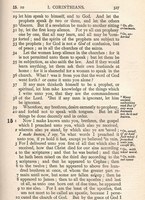 ICor 14, Dodd Mead
ICor 14, Dodd Mead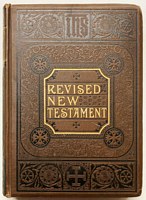 Hoyt_Hills #1957
Hoyt_Hills #1957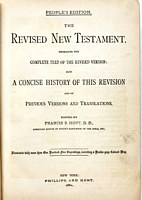 Hoyt_title
Hoyt_title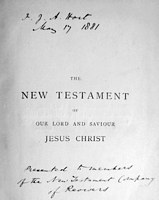 Signed Hort to ERV committee -
in an Oxford publication Signed Hort to ERV committee -
in an Oxford publication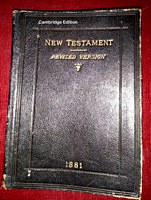 Cambridge, 1881
Cambridge, 1881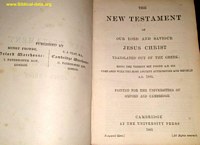 title page for above, Cambridge
title page for above, Cambridge |
|||||||||||||||||||||||||||||||||||||||||||||||||||||||||||||||||||||||||||||||||||||||||||||||||||||||||||||||||||||||||||||||||||||||||||||||||||||||||||||||||||||||||||||||||
|
ASV American
Standard Version 1901 Base Text - - - -
- - - - - - - - - - - basically WH, with Tischendorf and
Tregelles Accuracy of
translation - - - - 8 Value to
Christian faith - - - - - 9 Value as a
collectible book - - 9 (first edition) Publisher - - - - - - - - - - - - - - - Thomas Nelson, Gideons - various
First editions of 1901
are difficult to ascertain, as the copyright
pages and the address of Thomas Nelson are the only
hints. The address when shown would be: ( for all
"first" editions) Thomas Nelson & Sons The early NT copyright pages
appear as per the thumbnail to the right, labelled
"Early edition"; this indicates that that copy was
printed anywhere from 1901 -1910 per Hills [#2124].
From 1910 to 1930 it was Fourth Avenue or the Fourth
Avenue Building, 27th street 381 Fourth Avenue. In
1951 it is 19 East 47th Street. The older editions
prior to 1910 are quite collectible, and when in
fine condition are expensive. This "early edition"
sample is a two column format, with notes but no
references. Several editions stand out:
-- as the 1929 "Teacher's Edition" a very nice
leather Bible, with color images, a dictionary,
concordance, questions and answers, maps and many
cross references; it tops out at over 1400 pages,
and has a full yapp, and of course smyth-sewn. The
paper is thick enough at .0021 so that no
bleed/ghosting is apparent. Also Monser's gigantic Cross Reference Bible utilizes the ASV which enhances its value and usage; Monser's edition is reviewed farther down. Below [referring to the thumbnails] the 1929 Teacher's Edition is a nice
small size 1912 ASV, Teacher's Testament - With Notes
and Helps; it is a smyth-sewn hardcover, having at the
foot of each page nice helpful notes. Each book
has an introduction. it also is of a two column
format. Printed on off-white paper, .0028" thick!
A handy volume. The fourth thumbnail
down, is the cover of the Logos Paperback edition,
copyright 1972, with a two column format. Mention needs to be
made of the Gideon's editions, most were copies of
the standard format, with center column
references. Each was smyth-sewn, hardcover.
The thumb shows a pile (5000 copies!) of new
Gideon's ASV's about to be distributed
to hotels in Washington DC. This image is
copyrighted by Almy. Though said to be very
literal and accurate, (and it is) it is not a
perfect English translation. I would like to have
seen "...the faith Jesus
Christ" rather than the "...faith in Jesus
Christ"
at Galatians 2:16 and elsewhere. [however a
note showing "of" is seen in some editions]. But such is a
rendering issue, not a translation issue.
Yes an
argument can be made for various
renditions of the
genitive phrases herein. But even the
venerable
NASB follows the ERV and ASV here; the
Geneva
Bible has the correct phrase, IMHO.
Of course, faith IN Jesus Christ is true in many
passages where salvation is mentioned, but
the
imputation passages all should have "faith
OF" -
not "in". It is the faith of Jesus Christ
which is imputed into each Christian. He is the
Author! copies of the ASV and
ERV are available for viewing and downloading at:
www.archive.org. Taliaferro's encyclopedia, it is #7640.
Table below is
per a small first edition, leather bound, s.v. New
Testament, thumbnail - "Early edition"
BINDING NUMBER of PAGES PAGE SIZE PAPER INFO
|
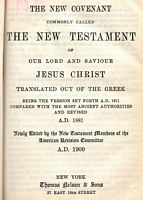 Early_edition
1901-1910 (111 x 85 mm) 2 columns Early_edition
1901-1910 (111 x 85 mm) 2 columns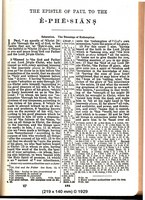 standard format, Teachers
Edition 1929+ w/references standard format, Teachers
Edition 1929+ w/references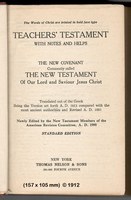 Small "Teacher's Testament"
with helps Small "Teacher's Testament"
with helps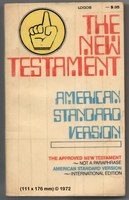 Logos paperback
Logos paperback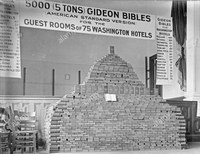 ASV
Gideon's to be distributed to Washington DC hotels ASV
Gideon's to be distributed to Washington DC hotels © Almy |
|||||||||||||||||||||||||||||||||||||||||||||||||||||||||||||||||||||||||||||||||||||||||||||||||||||||||||||||||||||||||||||||||||||||||||||||||||||||||||||||||||||||||||||||||
|
Translation
of the New Testament: From the Original Greek Base Text - - - - -
- - - - - - - - - - Tischendorf's transcription of
Codex 01 Accuracy of
translation - - - - 6 Value to Christian
faith - - - - - 4 Value as a collectible book - - 7 Affiliation - - - - - - - - - - - - - - - Holiness/charismatic associations Publisher - - - - - - - - - - - - - - -Office of God's Revivalist
William B. Godbey (1833-1920) was one of the most significant evangelists in the early stages of the Wesleyan-holiness movement. He was born in Pulaski, Kentucky, and raised in the Methodist Church. In 1868, he experienced "entire sanctification", a doctrine he fervently espoused in his pastoral and evangelistic career. He also taught in public schools and assumed the presidency of Harmonia College in Perryville, Kentucky for a time. He was a prodigious author publishing more than 200 books and pamphlets on topics including doctrine, new religious movements, the Second Coming, and divine healing. (in a thumbnail on the right is a cover of one his pamphlets -"Immersionism"!, he is against most water baptisms as a means of salvation, a rather rare pamphlet!). He traveled extensively across the country and the world preaching the holiness message. He appeared to be quite a successful debater, especially against the Campbellites. He taught at God's Bible School in Cincinnati. In his prologue, he claims this effort (his NT translation) as the the summit of his labors. His New Testament is
translated entirely from Codex Sinaiticus (01). This early
codex (circa A.D. 350) was a sensational discovery at the
time (1859), by the famed scholar, Tischendorf.
Naturally it attracted folks like Godbey, who really
believed it to be totally inspired! Godbey in many
respects was a diehard Holiness or Pentacostalist. He did
not believe in eternal security, nor in any water
immersion/baptism. Hence, this NT may be tainted via his
strong beliefs. We shall briefly examine several passages
of his and see if he inserted any of his doctrinal
beliefs. John 10:27,28 (per Godbey's
translation, page 84) 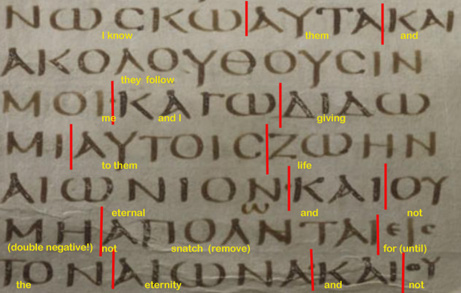 In the above snippet of codex 01, we note that
Godbey does a fine job of translating this passage,
which is one of many which suggest eternal security; which is contrary to Godbey's
beliefs (he believed that a second experience was needed
after admission of faith!). He did not corrupt the
English rendering of this passage. Hence it also
suggests that Godbey was not prone to altering the
manuscript's message. He appears to be quite objective
as a translator. (Modified image courtesy
of: www.sinaiticus.org).
However, he does alter in some instances: for example he adds the words "the (or your) love" which is NOT in the original text of codex 01. A "corrector" later added it a the bottom of the leaf. Godbey also adds it in his work, without notice. 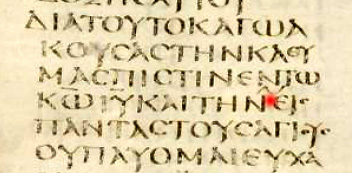 Below, is Godbey's rendition: (pages 261f.) "Therefore
I also, having heard of the faith among you in the
Lord Jesus, and YOUR LOVE which is toward all
the saints,"
Again thanks to www.Sinaiticus.org - for the sample of 01. The red dot marks where he added the words. But note that an apparent later hand added a mark linking it to a footnote (also in a later hand) a the bottom of the page - "agaphn thn". The words are also omitted in most Latin and Bohairic MSS as well as 03 (Vaticanus) and the ancient Papyrus P46. It is not part of the original 01 text. At Colossians 1:12, Codex 01 has "...the Father God" or ..."God the Father", Godbey omits "God". Apparently most of his "errors" are those which revolve around how the translation is made into clear English, hence Godbey simply has ..."to the Father". s.v. page 274. At Mark 7:4, Sinaiticus omits "couches" Godbey wrongly inserts it. At I Corinthians 2:2, Godbey prints "testimony" whereas the original hand of 01 has "mystery". In light of these samples, Godbey's translation is not a perfectly accurate translation of codex 01 (Sinaiticus), nevertheless it is a nice readable translation, just not a highly accurate copy of 01. In his original (1902?) hardcover (bottom thumbnail), he has a 3 page prologue, followed by his "Synopsis of the Harmony". This is followed by his Harmony of the Four Gospels, written in parallel paragraphs. Hence his gospels portion is in a harmony format, which is useful. All in all he does a pretty good job of rendering this manuscript (Codex Sinaiticus) into English. A very collectible volume! Also shown at right is one of his many pamphlets, this particular one quite rare, it is an anti-immersion tract. Beginning with Acts, on page 149, he presents us with a single column format. In the many footnotes he has added references and some translation notes. Each chapter has a brief heading. Lastly he ends with a 2 page apologue. The volume is nicely printed on an off-white paper, the paper is either highly calendared--as it is smooth, somewhat glossy--or it has some fillers; it slightly fluoresces at 380nm.. This original edition is well made, is smyth-sewn. I have seen NO publication dates in any of the original printings, 1902 suggested by Hills #2142. On some title pages of the original editions, the publishers name (M. W. Knapp) is omitted (are these the earliest copies?). M.W. Knapp was an ardent holiness advocate also, and was a friend of Godbey's. Knapp also owned a publishing firm, which published many of Godbey's works as well as other Holiness authors. Per Wikipedia: Martin Wells Knapp (1853-1901) was an American Methodist minister who founded several institutions including the magazine God’s Revivalist in 1888, the International Holiness Union and Prayer League (which became the Pilgrim Holiness Church) in 1897, and God's Bible School, later known as God's Bible School and College. He was a central figure of the more radical wing of the Holiness movement." Full of zeal and energy, he died young at 48. [end
quote]
The "new reprint" (see thumbnail) was printed by Schmul of Salem, Ohio. Recent reprints are available today. One notable rendering is at Galatians 2:16, wherein Godbey has "...the faith OF Jesus Christ", well done! The volume was popular with Holiness folks and had been reprinted a number of times, as seen in the thumbnails. In 1861, H.T. Anderson also made an English translation of Codex Sinaiticus: Henry T.
Anderson (1812 - 1872),
studied the New
Testament in the original Greek as well
as in the English. He became as familiar
with the Greek text of the New Testament
as he was with the English text. He
never ceased to study the New Testament
in Greek.
Many
scholars have pronounced this
translation the best in the English
language.
He was about
three and a half years making this
translation.
It
was based solely upon Codex 01 (Sinaiticus). A
revision of his NT is currently available today.
A review of Andersons' work is seen below
(1918).
The
NT and other works by Godbey are available for
viewing or downloading at: www.archive.org VALUE
SUGGESTIONS:
Table below
is per first edition
|
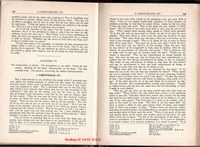 First ed. (1902?) First ed. (1902?)I Cor 14/15 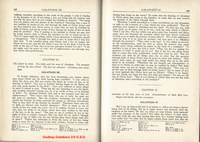 First ed.(1902?)
First ed.(1902?)Galatians2/3 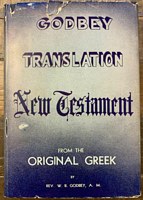 Third ed. dust jacket
Third ed. dust jacket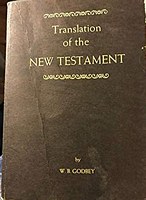 cover 1973 paperback
cover 1973 paperback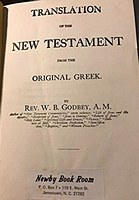 title page, paperback - 1973 title page, paperback - 1973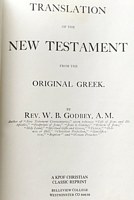 new reprint, title page new reprint, title page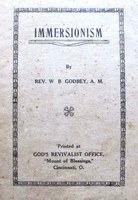 rare anti-immersion pamphlet -
Godbey rare anti-immersion pamphlet -
Godbey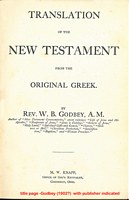 1902? Title page, this one
showing publisher 1902? Title page, this one
showing publisher |
|||||||||||||||||||||||||||||||||||||||||||||||||||||||||||||||||||||||||||||||||||||||||||||||||||||||||||||||||||||||||||||||||||||||||||||||||||||||||||||||||||||||||||||||||
| The
Reference Passage Bible - New Testament I.N. Johns - 1902 Base
Text - - - - - - - - - - - - - - - KJV Accuracy
of translation - - - - NA Value
to Christian faith - - - - - 10 Value
as a collectible book - - 7 Affiliation
- - - - - - - - - - - - - - - -
unknown Publisher - - - - - - - - - - - - - - - - Alpha Publishing Co.
He
did not produce a new translation,
he used the ASV. However his
additions and tools made the work
useful, and hence I examined it. I
also will review several other
"reference" editions which do not
present another translation, but
rather so enhance an existing one
that it itself becomes quite
valuable for its additions. The
Reference Passage NT, by Johns, in
fact adds a few references seen in
no other work! Hence this is
another asset. For example at Acts
20:28 a reference is made to
Psalms 74:2, a rather important
reference; but NOT seen in
Scofield, Monser, Bullinger,
Berry, NIV or any other reference
Bible to my knowledge. The
work has been reprinted by Moody
(1953), Logos and Baker Books
(1959), thus it is not rare. It is
a useful study tool, as one does
not need to flip through various
books to look up the reference, as
it is printed in full, parallel to
the lemma text, see thumbnails. It
is listed in Hills as #'s 2214 and
2188. In which one can see the
change of address for the
publisher. Alpha Publishing. [From
Sunbury Pennsylvania to Lincoln
Nebraska]. The 1902 first edition
is not easy to locate, but can be
found. My copy is thumb-indexed. The
text is printed in four columns,
and usually encompasses the entire
folio view (both sides of the open
page). Very little ghosting is
present, and the text is cleanly
printed. Some interesting and
useful maps are at the end of the
work. There seems to be no
doctrinal assertions made or
injected, - for example at
Romans 6, none of the references
contain the word "water", which is
correct. Overall
I really enjoyed using this work,
with the relevant references
printed "right there" on the same
or facing page, is really a useful
asset. Thus I give it a 10 rating
for "Value to Christian faith".
Several editions of the Reference
Passage Bible (NT) are freely
available at www.archive.org Of the early pre-1930
editions, the 1913 copyright page
states that it is of 95,000 in print.
Data below refers to a 1912 edition, of Lincoln Nebraska, Alpha Publishing Company.
|
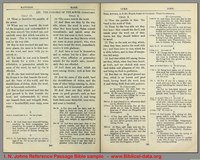 note full page use - 1907 edition 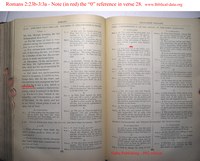 1912, full page, showing a marked "c" reference in Ro. 2:28 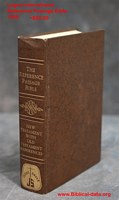 cover of 1998
cover of 1998Logos edition 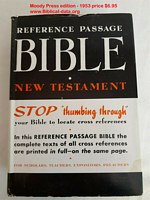 cover of 1953
cover of 1953Moody press edition 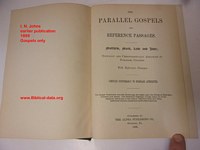 earlier 1896 edition - title page |
|||||||||||||||||||||||||||||||||||||||||||||||||||||||||||||||||||||||||||||||||||||||||||||||||||||||||||||||||||||||||||||||||||||||||||||||||||||||||||||||||||||||||||||||||
|
The New Testament in
Modern Speech (1903, 1943) Base Text - - - - - - - - - - -
- - - - a "consensus" of prior editions
(see below) Accuracy of translation - - -
- 8 Value to Christian faith - - - -
- 5 Value as a collectible book - -
6 Affiliation -
- - - - - - - - - - - - - - Baptist Publisher - - - - - - - - - - - - - - - James Clarke and Co.
Eberhard Nestle used
Weymouth's Greek NT for his first two editions
of his Greek NT, but in his third of
1901, be switched to Weiss's edition, hence no
Byzantine influences are noted. Sadly.
Eberhard's son however, produced a nice
apparatus for many subsequent editions up
until 1955 or so, when Aland invaded the team.
It
is from his Resultant Greek Testament,
that Weymouth's English translation was made
(as mentioned). It was published in
England for a number of decades, and was first
printed in America in 1943 by Pilgrim Press of
Boston [s.v. Hills #2418]. Hill states that
the early editions (see first thumbnail at
right) which seem to be printed in America, i.e.
The Baker and Taylor Company
1903, are actually printed in England. [s.v.
Hills, page 394]. Weymouth died in 1902,
and his friend Ernest Hampden-Cook - per a
prior arrangement with Weymouth - saw the work
published in 1903. Hampden-Cook added a few
more notes, and added the paragraph
titles. Hampden-Cook was also a translator for
the Twentieth Century New Testament. Weymouth
though working on his own translation, did not
seem to "borrow" from the the efforts of those
working on the Twentieth Century NT.
Occasionally one will see an interesting
coincidence - such as both reading "mass" for
"lump" at Romans 11:16! Many
publishers later produced various editions
some bound in leather (Pilgrim's Press 1943,
also James Clarke produced a red Morocco
leather edition in 1924!) , many in softcover
(print on demand), and various hardcover
editions. Some of the publishers are/were: Here
is an EBAY ad for a Lutterworth publication!
Lutterworth Press, makes very fine volumes, so
the high price may be justified. 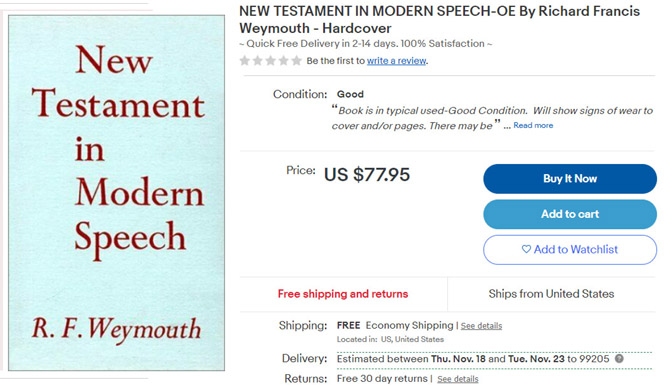 The
original publication, by James Clarke and
Company was in 1903, in England. The first
printing can be identified by noting in
Philemon verse 2, the spelling of "Appia"
which was later corrected to "Apphia".
An interesting publication note seen on the
title page of a 1903, second edition; read
21,000 number printed, and indicated the
publishers as jointly Baker and Taylor (New
York) and James Clarke, it was
actually printed in England, and also issued
(sold) in America by Baker and Taylor. In a
book review on Amazon's website Kohtaro
Hayashi provided the following comparisons as
concerning the differences in I Timothy 3:16,
amongst
the
various editions of Weymouth's NT:
1st (1903) and 2nd
ed. (1908) ed. by E. Hampden-Cook As one can see much of Weymouth's original wording is eventually lost. So in order to evaluate his work, it is suggested that students access the First Edition of 1903, in which the NT text itself is rarely corrected or altered by Hampden-Cook; however Hampden-Cook did alter or "improve" some readings in the third edition, but to what extent we may never know. Various free downloads are available at: www.archive.org. Intentional changes in the latter appearing editions reflect a poor knowledge of the underlying Greek. Compare Weymouth's work in 1903 with the work of Robertson: (click to enlarge) The Greek verb (exomen)
is clearly "we have", first-person plural, and
there is no variation within the Greek
manuscripts here. Again, try to use the first or
second editions of Weymouth's work in order to
correctly view Weymouth's work!
Finally,
keep in mind that Weymouth originally designed
this effort to be used along side of literal
texts, somewhat like a running commentary. In
this respect - the work is a real gem, and
recommended. VALUE SUGGESTIONS:
|
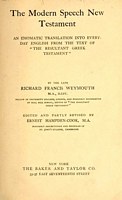 Baker
Taylor Baker
Taylor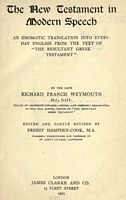 1st printing, 1903
1st printing, 1903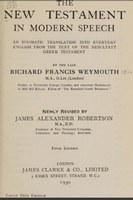 revised by Robertson, 1930 revised by Robertson, 1930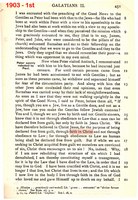 1903
first edition, Galatians 2:16 1903
first edition, Galatians 2:16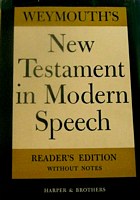 Harper and
Brothers, 1937, dust jacket. Harper and
Brothers, 1937, dust jacket. |
|||||||||||||||||||||||||||||||||||||||||||||||||||||||||||||||||||||||||||||||||||||||||||||||||||||||||||||||||||||||||||||||||||||||||||||||||||||||||||||||||||||||||||||||||
| Twenty-Four
Books of the Holy Scriptures 1904 - Isaac Leeser Base Text - - - - - - - - - -
- - - - - Hebrew (Masoretic, 2nd
Rabbinic, Jacob Ben Chayyim) Accuracy of translation - - -
- 8 Value to Christian faith - - -
- - 6 Value as a collectible book -
- 7 (for the 1904 publication - an 8) Affiliation
- - - - - - - - - - - - - - - - Jewish
(Sephardic) Publisher - - - - - - - - - - - - - - - - Bloch Publishing Co. When I began research upon this editor, I was struck by his attitude towards the New Testament, and towards the Christian scriptures in general. In his 1922 Preface, he seems distraught that the "KJV" reflected an "assail" against Israel's hope and faith. He refers to the Christian scriptures as translated in the KJV, as perverted and erroneous. He seems to view with favor the German translators of the Scriptures (Mendelssohn, Herz Wesel, Hartog Wessely and Solomon of Dubno), these are "some of the most eminent minds" he declares! Well what a beginning! He then states that proper Biblical criticism can only be carried out by "a Jew" - (apparently as concerns the OT only). He seems upset. Similar but toned-down lamentations are also stated in the prefaces of the 1917 Jewish Publication Society's effort (1917) as well as Hugh Schonfield's Authentic New Testament, 1955, and Harkavy's effort The Twenty-Four Books of the Old Testament, 1916. Each of these seek to purge all Christian interpretations from the Old Testament (note Schonfield's omission of Matthew 1:22, 23!, and his obvious corrupt "translation" of Ephesians). [For a few other comments upon Leeser's translation effort, see Harkavy's section below.] He translates the Masoretic Hebrew, so we shall inspect this, but briefly a note on the man. Born in Germany in 1806, he died an American in 1868. As to his education, he was first encouraged by the Jewish Rabbi Abraham Sutro, who instilled into young Leeser a dislike for the reform movement amongst American Jewry. Shortly later Isaac Seixas saturated him with the Sephardic rite, which Leeser thoroughly ingested. Lesser was an important figure in American Jewry in the 1800s. He tried to form numerous Jewish societies, synagogues, schools, newspapers, but most of all to unite in one, the various Jewish ideologies. Many of these attempts failed during his lifetime, but eventually such aspirations became a reality in America! He was ahead of his time, and all Jews today in America are deeply indebted to him. It was Leeser who first preached in his synagogue a "sermon" in English rather than in Hebrew. In 1934 he published his The Jews and the Mosaic Law, later he published a bi-lingual edition of the Pentateuch titled: The Law of God. In 1853 he published his famous OT - The Twenty-Four Books of the Old Testament, Carefully Translated According to the Massoretic Text, After the Best Jewish Authorities. It has been reprinted a number of times, and I now refer to the 1922 publication. I have no hard copy so this is based upon the digital PDF available at www.archive.org. [as a side note; as a child Leeser and his brother both contracted small-pox, only Isaac survived. Note the scars in the image to the right. He never married.] First the 1922 edition differs from his earlier 1845 bilingual text. However when the 1853 edition was published the differences betwixt it and the 1922 text were very minor. Below is the RSV text of Deuteronomy 1:3 compared with Leeser (1922):
Oddly enough many English versions add the words "And it came to pass...", which words are not in the Hebrew, several English versions have it correct such as the ESV, Moffatt, New Berkeley Version, et al. Additionally Moses spoke unto the "sons of Israel" per the Hebrew, whereas most versions have "children" or "people". A small point, I admit. All in all after much reading and comparing, I have found Leeser to be very very accurate to the underlying Hebrew. He is quite literal. The big fuss about purging "Christian interpretations" from the text, is a vapor lost in the expanse, the air of reality. Interpretations do not belong in the actual text, in notes yes, in the text NO. If the Jewish editors make this an orotund point, or major purpose for their translation efforts (to purge these interpretations) then they are presenting a straw-man. Most Bible scholars and readers, recognize when they are reading/using an annotated Bible, or a reference Bible with copious notes, and when they are reading just the unadorned text. I know of no English Bibles which inject interpretations into the text knowingly. In Leeser's case, I of course, examined many of the passages central to Christian beliefs such as: Isaiah 7:14, Genesis 3:15, Psalms 22 et cetera, and compared them to the passages in the RSV, ASV, KJV and the NASB. There was nothing for Leeser to delete or complain about. In the end, if someone wants a fine English translation of the Tanakh, then Leeser's effort is worth using, it is quite accurate, and I recommend it regardless of your religion. Leeser is the editor of numerous works of some value, hard to find today, if in fine condition, very expensive as this EBAY ad of 2022 demonstrates:
|
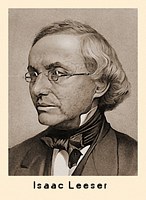 note scars via small-pox, still distinguished 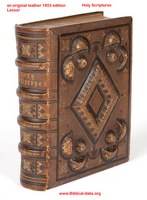 nice 1853 - 24 books of the Bible 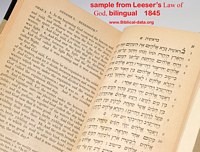 1845 masterpiece Hebrew/English Torah 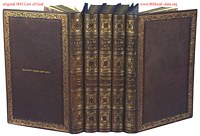 1845 Law of God complete set 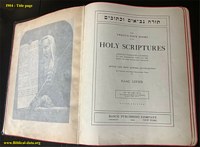 1904 - Twenty-Four Books, title page 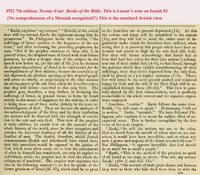 Leeser's note for Isaiah 53 _suffering Servant text - 1922 edition |
|||||||||||||||||||||||||||||||||||||||||||||||||||||||||||||||||||||||||||||||||||||||||||||||||||||||||||||||||||||||||||||||||||||||||||||||||||||||||||||||||||||||||||||||||
|
edition examined 1904 - the final all-in-one volume BASE text - - - - -
- - - - - - - - - - - basically WH Accuracy of
translation - - - - - 7 Value to Christian
faith - - - - - 6 Value as a
collectible book - - 7 (first edition) Publisher - - - - - - - - - - - - - - - Fleming H. Revell This is a translation which began
in multiple portions, beginning in 1898 (per Kubo and
Specht*). The four parts were combined in a final
publication in 1904, in which it was somewhat revised.
The bottom thumbnail show a cover of part III, circa
1900. The underlying Greek text is that of Westcott and
Hort's. The translation was undertaken by about 35 individuals,
folks, who did not meet - but rather collaborated
entirely via mail! Their names were not made public,
that is until a report on the translation/translators
was found in the John Ryland's library in 1954 by
Kenneth W. Clark. In it we note the names and some
biographical information of more than a dozen
translators. Clark writes:
After the initial stage of the work, twelve
more workers were enlisted but unfortunately their biographies
were never requested, perhaps because personal conferences had
to some extent replaced correspondence. Altogether,
thirty-five persons were associated with the translation,
including as advisers three prominent scholars : G. G. Findlay
of Headingley College, J. R. Harris of Cambridge, and R. F.
Weymouth, retired Headmaster of Mill Hill School.
A few of the translators were: Henry Bazett,
T. Sibley Boulton, W. Tucker Broad, John A.
Barrow Clough, W. Copland, E. Bruce Cornford,
William M. Crook, Peter William Darnford,
George G. Findlay, Edward Deacon Girdlestone,
Mary Higgs, J.K. Homer, A. Ingram, Ernest de
Merindol Malan, Sarah Elizabeth Mee, and
R.O.P. Taylor K.
W. Clark's article (in PDF format) can be
read here, 24 pages. Just click on this
line. Those translators which we do know about are a simple cross-section of society in 1890s England. Housewives, as well as 14 clergymen. Among them are many Socialists, some self-styled Radicals, and almost all have engaged in numerous social services toward reform and uplift. They hold in common a sympathy for the mass of workers. A number of them have written articles on social and religious reforms, and some have previously engaged in translating, or at least in re-phrasing, the English New Testament. It was an era of social change, which as Clark declares does not impinge upon the text of this work, only it does sit in the cultural background. Clark further elaborates: The Greek used by the New Testament writers was not the Classical Greek of some centuries earlier, but the form of the language spoken in their own day. Today this is a commonplace, but Girdlestone's insight anticipated Adolf Deissmann by many years. Grenfell and Hunt were still young scholars, still digging up papyri in Egypt. It was therefore an "advanced" conception as to the nature of the Greek, which enabled these translators to set a precedent for the treatment of the New Testament text. This Girdlestone, was a scholar who was adept at classical Greek, his full name being Edward Deacon Girdlestone; he was the oldest member, at 63, (born in 1814, in Sedgeley, Staffordshire, England) and a stalwart associate. He and his father were Anglican clergymen. After college and teaching, he was ordained at 23 ( Waldham College, Oxford) but two years later decided that this had been a mistake. In a state of indecision he continued intermittently to work and to preach. He was a well-known Fabian. [i.e. persons who advocated socialism, but gradually, not via revolution]. In his mid-thirties he married a woman of means and soon retired. Later as a widower he re-married at 50, and for a while tutored privately. He claims a number of published articles, mostly socialistic. As mentioned the final edition appeared in 1904, showing substantial revision of the tentative form. In London, it was published by the Sunday School Union at Is. 6d., and the American publisher was Fleming H. Revell. The passage concerning the Woman Caught in Adultery, is printed at the close of the Gospel of John with a notice. Mark 16, is included with notices, and the Gospel of Mark is printed as the first of the Gospels. First Corinthians 14:34, 35 are in the text but the women are referred to as "married women". At the beginning of the volume, lie 21 pages showing the contents as the names of the paragraph headings, (s.v. thumbnail at right). Pages are in single column format, adequate margins, text is cleanly printed. Being smyth-sewn it lies open nicely. At the foot of each page lie cross references, and some minor notes; some of the references are to apocryphal literature! It follows WH Greek text, but adds some interpretations not seen in the Greek. For example: 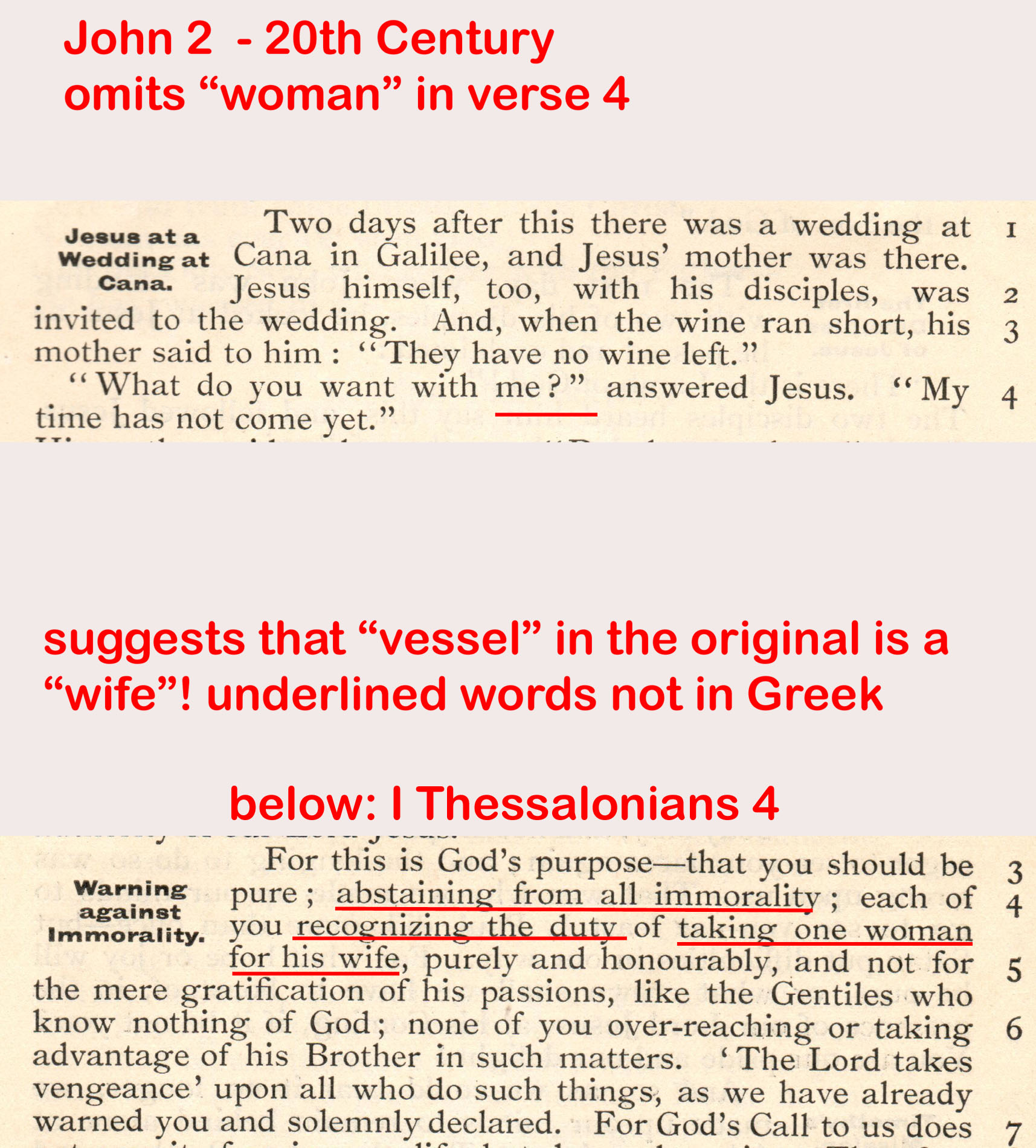 Additionally some passages are downright awkward, for example Philippians 2:17 And yet, even if, when your
faith is offered as a sacrifice to God, my life-blood
must be poured out in addition,
still I rejoice and share the joy of you all; The NASB reads: But even if I am being poured
out as a drink offering upon the sacrifice and service
of your faith, I rejoice and share my joy with you
all.
The
overall text flow is rather fractured, somewhat halting.
Which may be good as it requires the reader to think
about what he or she had just read! However, the text
could be smoother had it been subjected to an English
prose editor. The unevenness
may be due to the fact that numerous translators
were involved, and that communication betwixt them
was slow (via mail). Occasionally
British terms are encountered, such as "gaol" for
"jail". Despite some of my complaints, the text is
enjoyable and interesting to read. It is truly a unique
translation!
Numerous editions have been published over the years, one of the rarest is the Boy Scout edition, shown here in an EBAY auction, for over $400.00: 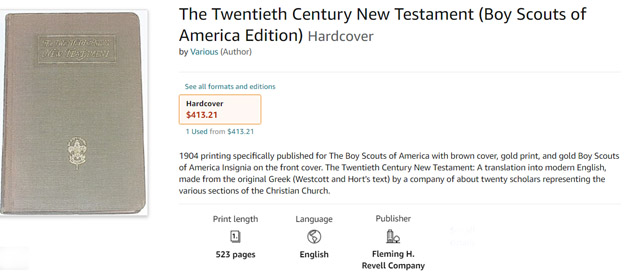 In a review of this NT, Robert Bratcher pointed out a few other changes: 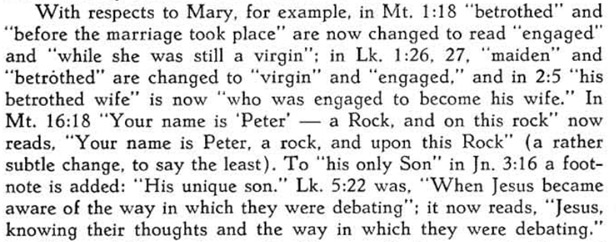 VALUE SUGGESTIONS:
|
Moody, 1961 dust jacket
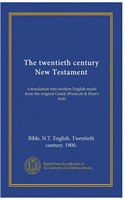 University of California reprint
University of California reprint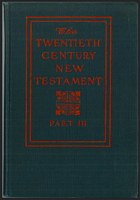 cover of earlier part three, 1900
cover of earlier part three, 1900 |
|||||||||||||||||||||||||||||||||||||||||||||||||||||||||||||||||||||||||||||||||||||||||||||||||||||||||||||||||||||||||||||||||||||||||||||||||||||||||||||||||||||||||||||||||
The Modern American Bible (1897-1901, revised 1902 and 1909) Frank Schell Ballentine BASE text - - - - -
- - - - - - - - - - Byzantine Accuracy of
translation - - - - -8 Value to Christian
faith - - - - - 8 Value as a
collectible book - - 9 (first and second editions 1889 - 1901, and 1902) Publisher - - - - - - - - - - - - - - - Thomas Whittaker
The full title of the
first edition is: The Modern American Bible,
The Books of the Bible in Modern American Form and
Phrase with Notes and Introduction.
Hills
[#2102] gives some information on each
volume with
pagination. The 1902 edition [Hills #2143]
was published in five handy volumes. Each volume was simply titled: The American Bible, Good News Publishing Company, Scranton, Penn.. Each volume was originally priced at 65 cents each ($1.00 leather). Volumes were published as follows: vol. 1 Matthew, Peter, Jude, James and Hebrews vol. 2 Mark vol. 3 Luke, Acts vol. 4 I,II,II John, John, Revelation vol. 5 Paul Each book is supplied with copious notes at the rear of the volumes. In his introduction to one of his gospel texts he states: We have used our every effort to leave off
everything peculiarly English and to put in its place what
is distinctively American. For this version of the Gospel
Story is addressed to Americans, not Englishmen. It is
addressed to Americans of this year of grace, not to those
of the 16th century. It is addressed to Americans in their
every day walk and conversation, not to them as scholars and
churchmen alone. It is addressed to all Americans of
whatever cast or class who do not find themselves entirely
at home in reading the present versions of the Gospels. It
is addressed to you, interested reader, if you are ready to
welcome a rendering of the Gospel Story talking to you in
your own distinctively American words and phrases,—the words
in common use on the street and in the mill, the phrases
ordinarily heard on the road, in the store, and at the desk. Well one could
argue that the gospels were addressed to Israelites and
Gentiles in the first century AD, in Greek. He means to
imply that this ENGLISH rendition is to be seen
distinctively as "American" English. It is addressed to
those who can read (or read to others), yet no class
distinctions are to be recognized. Ballentine makes his
point, and one wonders if he is an illusory socialist?
Elsewhere he also stated:
After this he
went out and saw a saloon-keeper
LUKE
5 : 30. Version. In the Revised Version the marginal note to S. Matt.5 : 46 says " collectors or renters of Roman taxes." The latter is the literal meaning of the original word, but in itself it only gives a faint idea of the thought which it conveyed to our Lord's hearers. The Jewish collectors of Roman taxes in our Lord's time were looked down on as a despised and disreputable class of people by those in authority in the Jewish Church, and all those who were strict followers of their theories and practices. We have no class of people among us to-day which is exactly analogous to that of the Jewish Roman tax collector, nor is there and which is hated and despised with the same intensity and abandon. The saloon-keeper of to-day comes nearest to being thought of and treated by at least certain great bodies of Christian people just as the old Jewish Roman tax collector was. This is our reason for adopting this translation. It was first suggested by our reviewer in the Sunday-school Times. We have adopted the word " prostitutes" instead of sinners for a like reason. To the Jewish mind of our Saviour's time, in fact, ages before his time, to sin against God was likened to that which the prostitute does. Cf. Hosea 4 : 10 5:3; Ezekiel 6:9; 23 : 3 ; Isaiah 57 : 3. Then again the modern use of the word "prostitute" as one who degrades and misuses his God-given gifts is thoroughly in accord with the idea which the original conveyed to our Lord's hearers. Compare S. Matt. 21 : 31, 32, a thoroughly parallel passage. --end quote-- Was prohibition in effect in 1900? His arguments are rather "far fetched" in my opinion. However, the majority of his text is well rendered in English. He does have difficulty with some of the aorist participles and verbs; for example in Ephesians chapter one, (see thumbnail), words underlined in red are poor renditions. "In heaven in Christ" - "heaven" should be [and is a] plural; perhaps "heavenly spheres". "In Christ" as a dative could be "within Christ" - producing "in the heavenly-spheres within [or "in] Christ", this suggestion stems from a note in the Scofield Reference Bibles. The words underlined in red in the Galatians sample, simply indicate how he translated this, I would translate it as "the faith of Christ", but it is ambiguous. Bradford Taliaferro [page 29], states that: "this is a translation of the Textus Receptus (and other) GNT...". Unfortunately this is not verifiable, at least the early 1899-1902 editions are not reliable translations of the TR, note these 9 samples:
The Modern American Bible, is pleasant to read, it is laid out nicely. It also presents us with many nice renditions, but over-all I do not recommend it for critical study or food for growth. Besides it is hard to find! [Recent reprints are available, low priced!]. Five volumes are available at: www.archive.org
data below is from a 1902 second edition (Luke-Acts):
|
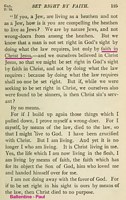 Galatians 2:16 (1902) Galatians 2:16 (1902)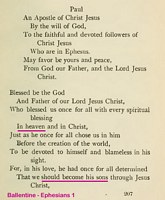 Ephesians 1 (1902) Ephesians 1 (1902)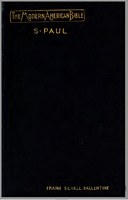 Front cover 1900 -? Paul, simply titled: The Modern American Bible. Front cover 1900 -? Paul, simply titled: The Modern American Bible.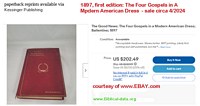 Ebay ad for first edition 1897, priced a bit high IMHO 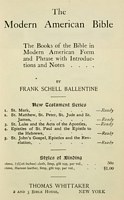 Advertisement of Ballentine's NT volumes (early editions),
Advertisement of Ballentine's NT volumes (early editions),note publisher. 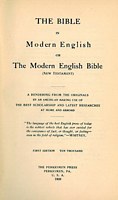 rare 1909 title page thanks to
Wikidot which is source for this image rare 1909 title page thanks to
Wikidot which is source for this image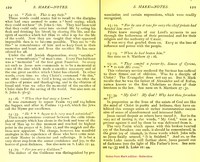 sample of "notes" from the Mark edition (~ 1900)
sample of "notes" from the Mark edition (~ 1900)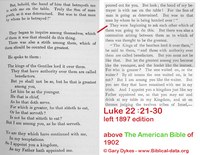 side by side comparison 1902 and 1897 |
|||||||||||||||||||||||||||||||||||||||||||||||||||||||||||||||||||||||||||||||||||||||||||||||||||||||||||||||||||||||||||||||||||||||||||||||||||||||||||||||||||||||||||||||||
The Emphasized New Testament Joseph Bryant Rotherham (1897, reprint 1959) BASE text - -
- - - - - - - - - - - - Westcott and Hort (Greek New
Testament) Accuracy of
translation - - - - 5 Value to Christian
faith - - - - - 3 Affiliation - - - - - - - - - - - - - - - Churches of Christ Publisher - - - - - - - - - - - - - - -The Standard Publishing Co.., Kregel The full title is: The Emphasized New Testament: A Translation Designed to Set Forth the Exact Meaning, the Proper Terminology, and the Graphic Style of the Sacred Original. The first complete Bible was published in 1902 by the Fleming H. Revell Company, in 3 volumes: vol. I - Genesis-Ruth: vol. II I Samuel -Psalms: vol, III Proverbs-Malachi. New Testament was first published in 1872, and rewritten in 1878. The Gospel of Matthew first appeared in 1868. In 1916, all four volumes were published in one volume. The text utilized in this review is a 1959 (Kregel) copy of the 1916 NT edition. Margaret Hills list 8 editions of his NT/Bible - #1930, #2073, #2078, #2083, #2097, #2133, #2139, #2227. Her #2227 is the Kregel edition, though she lists it as printed in the year of 1961, my copy is 1959. Of course the multi-part OT (1902) is very collectible, as well as the early 1878 NT. For current daily use and study the 1916 edition(s) are valuable. The Kregel reprints are very good of the 1916 edition, hence it has some value. The works prior to 1916 are fairly rare, and costly when in pristine condition. Via my research Rotherham was a layman without any college education. He spent much time on his translation efforts, and it shows. I assume he was self taught in Greek and Hebrew. This is typically the case with the many Church of Christ translators; they often just dive in and try to translate with lexicons in hand. Even today (November 2021) several Church of Christ translations are underway by private individuals. None are or have been taught by experts the Koine Greek language. Often it is claimed that they are under guidance of the Holy Spirit. The first such efforts began by the Campbell's circa 1828. Joseph Rotherham was thoroughly versed in Hebrew and Greek [not verified]. Using Tregelles' New Testament Greek text, Rotherham began his work in 1868. Later in his final edition of the complete Bible in 1902 he switched to Westcott and Hort's Greek New Testament. In both his Old Testament and New Testament translations, his well executed intent was to render each word as literally as possible, while still showing the shades of meaning by various markings and footnotes. He was one of the first to use Yahweh as representing the Divine name of YHWH. Below is basically per Wikipedia, with additions: Rotherham - (1828–1910), was a British biblical scholar and minister of the Churches of Christ, He was a prolific writer whose best-known work was the Emphasized Bible, a new translation that used "emphatic inversion" and a set of diacritical marks to bring out shades of meaning in the original text. Though British, his work was very popular in America, notably with the Christian Scientists. He was born at New Buckenham, Norfolk in the United Kingdom (1928). His father was a Methodist preacher, and Rotherham followed in his footsteps, pastoring churches in Woolwich, Charlton and Stockton-on-Tees. However he soon developed differences with Methodism regarding infant baptism and, at the same time, became interested in the writings of the American preacher Alexander Campbell, one of the early leaders of the Restoration Movement. Rotherham eventually joined the movement in 1854 and became a well known evangelist and biblical scholar with the Churches of Christ. He based his Old Testament translation on the comprehensive Hebrew text of Dr. C. D Ginsburg, which anticipated readings now widely accepted. (Which was a good move!). Rotherham became an editor with James Sangster and Co., London in 1868, and then a Press Corrector for 31 years beginning in 1874, principally working with religious books. Although this effectively ended his Evangelistic work, he continued preaching and publishing articles in such magazines as Christian Commonwealth and Public Opinion. Rotherham enjoyed good health virtually to the end of his life, giving his last sermon on December 19, 1909. However on New Year's Day 1910 he caught a severe cold and experienced a rapid decline, dying only a few days later at the age of 81. His body was laid to rest in Hither Green Cemetery on January 10. [end Wikipedia material]. As a press corrector, he must have been keen to note the smallest of details, a talent useful for translation! Today numerous scholars applaud his work, especially as concerns the Hebrew (the late John R. Kohlenberger III). As to his Greek, he struggled. After years of labor and three editions of the New Testament, his final result is very good - that is, his translation of the WH Greek text. He did utilize Donaldson's Greek grammar, Meyer's commentaries, the Liddell and Scott Greek dictionary, and works by others (Saphir, Farrar et al). Nearly all refer to the classical form of Greek, rather than the NT Koine. An for example note one of his labors with the prepositions, John 1:51: "...messengers of God ascending and
descending unto the Son of Man"
Note the preposition "unto" [i.e. to], the
Greek reads epi and is usually translated as "upon".
Here is his footnote:
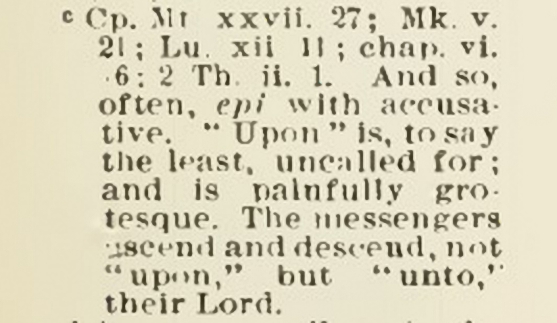 He refers to the usual translation "upon" as "grotesque". Odd. He must be viewing these angels as physical beings, as opposed to spiritual beings. Spiritual beings who may alight upon the shoulder of the good Lord to whisper a message in His ear. Is this not more reasonable? They moved up and down upon Him. [UNTO is an archaic expression for the preposition "to"] At I Peter 2:24 he translates epi as: 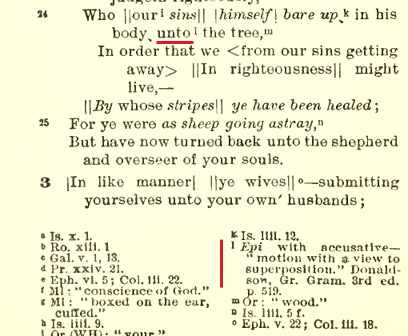 Here again epi with an accusative, Christ bore our sins UPON the tree [i.e. cross]. Donaldson's definition as, "Motion with a view to superposition"; is vague, but this is a grammar for classical Greek, and in the Attic dialect epi can indicate movement more so than in the Koine. For example at Luke 1:17, we find " to turn the hearts of the fathers TO the children". The above quote of John 1:51 shows some non-physical movement. Were our sins moved or bore TO the tree? Certainly the typical meaning of "upon" as in "upon the tree" is more realistic and accurate. Was His body "to" the tree, or "upon" the tree? My question is why make this complicated? In Rotherham's day, the Koine was just being grasped, and freed from its classical shackles, consequently Rotherham is simply an innocent grammarian of his times. Yes, in some scenarios "to" is accurate, but "upon" shows the result, at times a place of rest, a location upon which something or someone was positioned. His body was attached TO a tree, but the sins were UPON Him, not the tree. The tree was/is not our sin-bearer. Being poetical I might state: The tree did not die for me. Certainly the phrase"...from our sins getting away" (in the above quote), is confusing, to say the least. We are "dead to sin" that is simple and clear and accurate, again why did Rotherham conjure up this mishmash? As for the Hebrew, he exhibits the same ineptness with a similar preposition (b-) he is stuck upon using it as "in-", which it often means, but not always... for example he has "in a (certain) day", as opposed to "on a certain day"; s.v. Isaiah 10:20, 11;11, et al. Or "IN Mount Horeb" as opposed to "ON Mount Horeb", I Kings 8:9. etc. etc.. It appears quite that probable that he relied upon reference works which were a bit outdated. He is guilty of simply moving phrases around and alternating with a variety of synonyms. Lots of work, but indicating a poor knowledge of the Greek. The same goes for his effort on the Hebrew OT. His translation is substandard despite some other reviewers. After reading considerable chunks of Rotherham's OT and NT translation, I am left with the reality that the effort is not worth the time to try to make sense of it. Why try to put the word order of the Greek into English dress, this completely hampers the reader's ability to understand God's Word? His early work may be collectible, but I cannot recommend it as a good representation of God's Word, in the Greek or Hebrew. For more detailed information on his life and work - a book about life and his reminiscences, is available for download - copy and paste this link into your browser. http://www.teleiosministries.com/rotherhambible.html VALUE
SUGGESTIONS
data below is from a 1959 Kregel reprint of his New Testament-
|
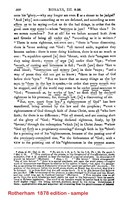 1878
sample 1878
sample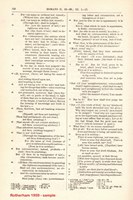 1959
sample 1959
sample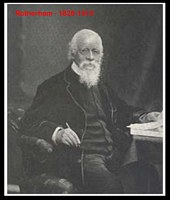 The old fellow The old fellow |
|||||||||||||||||||||||||||||||||||||||||||||||||||||||||||||||||||||||||||||||||||||||||||||||||||||||||||||||||||||||||||||||||||||||||||||||||||||||||||||||||||||||||||||||||
|
The New
Testament Revised and Translated... Base Text - - - -
- - - - - - - - - - - a modified Westcott/Hort
(WH) Accuracy of
translation - - - - - 6 Value to
Christian faith - - - - - 4 Value as a
collectible book - - 7 (1904 edition) Affiliation -
- - - - - - - - - - - - - - Assemblies of
God/Charismatic Publisher - - - - - - - - - - - - - - - reprinted - Gospel Publishing House
Some
of his biography can be seen at: (via
Wilfrid Lofft). Worrell did earn several degrees
In September 1844 Adolphus was converted and in 1850 he felt called to preach. He graduated from Mercer University, Macon, Georgia, with an honors A.B. in 1855 and with an A.M. in 1858. Later, he is termed “Dr.”, but where and when he attained his degree is not known. He was born in 1831 and died (via
stomach cancer) in 1908. He was a professor of
Greek and Hebrew as well as the editor of
several journals and was a college president,
of at least half-a-dozen colleges! The first edition (1904) of this
NT, is rather hard to find, it was published
by a Baptist press, probably because it uses
the word "immersion" for baptism. However, it
is currently available via Gospel House
Publishers, an Assemblies of God publishing
concern. Rightly so. [s.v. Hills # 2161]. It
is strongly charismatic, or rather Worrell
himself was. In his introduction he claims
that the Holy Spirit guided him in making this
"revision". He also claims that during his
effort to produce this
NT: "...that during
all the labor of translation and preparation
of the notes, he has never realized any
fatigue, in body or mind, worth noticing. On
the contrary his very spirit, soul, and body
have glowed, much of the time, with an
exhilaration that he could but credit to Him
Whom he has undertaken to serve, please and
glorify in the execution of this
work."...this work has been done as to the
Lord; and it is His..." He does not claim that the work
is perfect, discounting human error, what does
he claim? "The writer has
dealt with the tenses [Greek] as themselves
inspired, and he has not dared to translate
them otherwise..." . Hence, he claims
especial attention to the rendering of the
tenses, and to the syntax and word order of
the original Greek. He claims to have made
many improvements over the Revised Versions.
His text is basically the 1901 ASV. Which he
modifies to suit his whims. A few samples
follow:
Interestingly both versions can
be corrected to the Greek. "whole" is actually
a Greek verb meaning "save, heal, rescue". A
better rendering would be: "your faith has
healed you". The NASB (1971) correctly reads: He is adamant in stating that
Sabbath" does not mean "week" or "weeks". For
example: I Corinthians 16:2; On the first day of the
sabbaths Worrell The Greek has
"according (to) first sabbatwns" -
(plural, sabbath) per literal English we
would see "per the first of each
week..." At each location wherein
"week" would be required, he consistently
wrote "sabbath". In a footnote to to
Matthew 28:1, he mentions that "week" may
be meant, and at John 20:19 in a footnote,
he correctly renders as "on the first day
of the week". As to following the venerable
1901 ASV, note this comparison: Luke 6:1 ASV Now Worrell: now NASB: (1971) The
issue herein is that in verse one, the Greek has
"the second-first sabbath", that is why the NASB
utilized "certain". This is a difficult verse, but a
note would have been proper. Rendered as "the second sabbath after the first", per the KJV, makes the best sense
and honors the underlying Greek. One may note that
later on in verse 2, (see thumbnail) Worrell retains
the archaic "ye", following the ASV. In which case
he flip/flops back and forth with "you" and "ye". -
indicated in the thumbnail in red. (i.e.
His "plucking" in 6:1, is an improvement
over the ASV's "plucked" as it is a present active
participle). In
many more instances one can demonstrate that the
Holy Spirit erred quite often - BUT this is not the
case, Worrell was definitely NOT led by the Holy
Spirit to translate thusly, a sad indictment. His
omission of text in Matthew 20:22 is a clear bo bo
(in my opinion), here he follows the ASV, but
does the Holy Spirit follow the ASV here? Worrell
omits the last part of the verse - "...and
to be baptized with the baptism that I am baptized
with?... The
omission occurs primarily in the Egyptian
manuscripts, it is in the Majority of
manuscripts. Worrell claims to follow the
Westcott/Hort Greek NT, and the WH text does omit
the above portion of verse 22. Worrell also states
that he also consults Scrivener and others, so the
Holy Spirit made a decision to omit as per the WH
text, but who really made the decision to omit the
above, him or the HS? Was the HS his guide or was
the 1901 ASV his guide? Or was Westcott and Hort??
One is left to ponder. Many other examples are not
so dense. (I chose this one as because I may be
dense -- do you note the humor?). A
few final points regarding the format of his NT; the
margins a too narrow (see thumbnails), the page
paragraphs seem crammed together. Finding certain
passages is not simplified with addresses printed at
the tops of the pages. Otherwise the
Gospel Publication House
editions are nicely printed and bound, worth their
asking price. As
with many of the new translations appearing during
the 20th century, one must ask WHY each was
produced. Worrell obviously thought that the others
were not produced under guidance of the HS. He has
clarified the text in numerous places, but some of
his simplifications are not an improvement. If his
translation never appeared, the world would probably
not miss it. Otherwise the 1901 ASV lives on. Worrell also had several other works of his published, still in print (reprints) are The First and Seventh Day Controversy, a volume titled: Full Gospel Teachings, and a text on English grammar.
the data below is based upon the GPH edition of 1980:
|
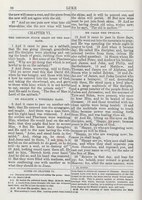 Luke
6 Luke
6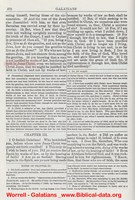 Galatians 2
Galatians 2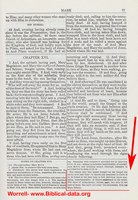 Mark
16 and note Mark
16 and note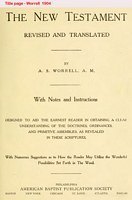 1904 title page 1904 title page |
|||||||||||||||||||||||||||||||||||||||||||||||||||||||||||||||||||||||||||||||||||||||||||||||||||||||||||||||||||||||||||||||||||||||||||||||||||||||||||||||||||||||||||||||||
|
The
Corrected English New Testament Base Text - - - -
- - - - - - - - - - - Nestle's 4th Greek text Accuracy of
translation - - - - 7 Value to
Christian faith - - - - - 6 Value as a collectible book - - 8 (first 1905 editions) Affiliation - - - - - - - - - - - -
- - - Quaker and Anglican Publisher - - - - - - - - - - - - - - - Samuel Bagster and Sons, limited After spending some time, I came to the conclusion that this effort by Lloyd was and is indeed a genuine correction and improvement of the ERV and the ASV as well as the KJV. Page after page of this text clearly presents to the reader laborious efforts to improve upon the prior mentioned versions. When the 1885 ERV was published, Lloyd and others noted to their dismay many failings - antiquated language, numerous errors when translating various verbs, poor phrasing and word order, and a reliance upon the KJV to such a degree that the results of the revisers was just the dusting off of the fossilized text. Indeed a Corrected edition was required. A daring prospect, and daunting. When Lloyd presented his suggestion before the British Foreign Bible Society, they did not accept his proposal (this being 1901). However, lack of support did not stop this man - Samuel Lloyd. Samuel Lloyd (1827 - 1918) a Quaker, was a member of the Friends Historical Society, Chairman of and owner of Lloyd's Ironstone Company, and heir within the Lloyd family of Birmingham; iron-founders and bankers, their banking business went on to found Lloyd's Bank, (i.e. Lloyd's of London) today one of the largest banks in the United Kingdom. A very wealthy man. Yet he writes: [begin quote] Writing about oneself is not a congenial task;
yet, lest it be thought that I am over much given to
business, I should like to mention the time I have
given not only to the study but also to the
distribution of the Bible even to smuggling, under the
influence of George Borrow's book, copies of the
Scriptures into Spain by hiding them in the hollow
balance-weights of the machinery we sent out to
Barcelona when we supplied the rolling-mills there,
the dissemination of the literature being undertaken
by a zealous Welsh foreman. I have long been an active
member of the Bible Society, and recently I myself
published The Corrected New Testament, in the
preparation of which I had the valuable assistance of
the Rev. G. C. Cunnington and many famous theological
scholars. I consider that my life-work. [end quote] Note the last sentence, note too that he authorized the smuggling of Bibles, via his business with companies, into Spain - jeopardizing his business. A stern man, this Samuel Lloyd! I know little of his education, but this work and his writing of some of his family's history suggest he was quite intelligent. Without the support of the BFBS he went ahead and recruited some very able scholars, principally the learned Rev. E. E. Cunnington MA, the Rev. Canon Girdlestone, Dr. J. Rendel Harris, Mr. W. H. Garbutt. Additionally he utilized the services of: Mr. E. Hampden-Cook (of the Twentieth Century New Testament fame), Mr. J. Pollard, Rev. E. W. Bullinger and others. The Corrected English New Testament, was published in 1905, first by Samuel Bagster and Sons, then also by G. P. Putnam and Sons (of New York), also The London Bible Warehouse, Knickerbocker and Ruskin Presses. All in 1905. The most desirable edition is the leather covered boards of the Samuel Bagster edition. It is beautifully made, with rounded corners and abundant gold-gilded edges. It is in a single column format (see thumbnails), with ample margins. It utilizes the Fourth edition of Novum Testamentum Graece cum Apparatu Critico, Eberhard Nestle, 1904. Upon close examination, the text is closely based upon the Nestle Greek NT. Which effort is the first New Testament, in English, based upon Nestle's Greek NT! Daring, as most flocked to the Westcott-Hort text; there exists not a lot of differences, but still this innovation is typical of Mr. Samuel Lloyd. Being a multi-millionaire one suspects that the publication was financed by the Lloyd's folks as well. E. E. Cunnington, (the Anglican) next to Lloyd, was responsible for the final product. His expertise with the Greek is apparent. More information on this Cunnington is seen below with the 1914 NT he produced! Yet I believe he has room for improvement (as all translations do), note second thumbnail to the right, concerning Galatians 2. Lloyd's NT needs to be republished, back in 1905, the publication was snubbed by the ecclesiastical society of Britain, as they did not approve of the use of the term "authorised" in its full title (The Corrected English New Testament - A revision of the "Authorised" Version). Even though Mr. Lloyd was a life governor of the BFBS, they did not endorse this work. Too bad, in my mind it surpasses the ASV, the ERV and the KJV. A remarkable effort!! As one reads this text, one will note the retention of many KJV terms and idioms, this was intentional as Lloyd had great respect for the KJV (and the ASV) and did not want to meddle with its (their) beauty. It is enjoyable to read, and copies are available for downloading at: www.archive.org. Modern reprints are also available both paperback and hardcover (Kessinger Publishing, Wentworth et al). Prices range for $29.00 (paperback) to $50.00 for the hardcover. The new print-on-demand copies are terrible as far as quality is concerned; pages missing some text, pages too light, binding tight glue. Try to find one who publishes with smyth-sewn bindings, this will help.
data below is via the Samuel Bagster and Sons, leather edition (see thumbs)
|
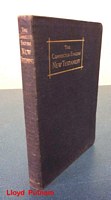 Putnam Putnam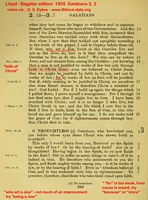 Galatians 2 +
Galatians 2 +notes added 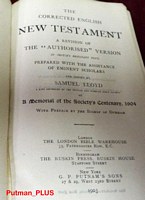 3
publishers 3
publishers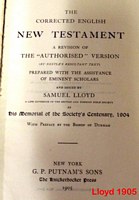 Knickerbocker
Knickerbocker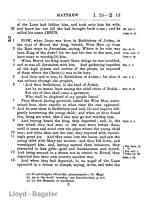 Bagster
Bagster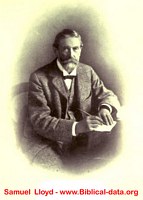 Samuel Lloyd
Samuel Lloyd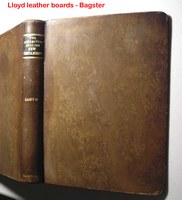 1905
leather 1905
leather the
leather from the
leather fromabove 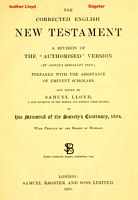 leather title page
leather title pageBAGSTER 1905 |
|||||||||||||||||||||||||||||||||||||||||||||||||||||||||||||||||||||||||||||||||||||||||||||||||||||||||||||||||||||||||||||||||||||||||||||||||||||||||||||||||||||||||||||||||
|
The Modern
Reader's Bible Base Text - - - - -
- - - - - - - - - - 1885 English Revised Version Accuracy of
translation - - - - 7 (he does modify the ERV) Value to Christian
faith - - - - - 6 Value as a
collectible book - - 6 Affiliation - - - - - - - - - - - - -
- - Methodist Publisher - - - - - - - - - - - - - - The Macmillan Company
Perhaps its in the genes, but
Richard Moulton's family was remarkable. He was the
youngest brother of four (with 2 younger
sisters). All were brilliant. Students of NT Greek
need no introduction to his brother - W. F. Moulton.
Our Richard Moulton was also the uncle of the
celebrated J. H. Moulton (who died after his ship
was torpedoed during WW I, in 1917; i.e.
in the same lifeboat was James Rendel Harris, who did
survive.) Richard Green Moulton died at his
home in Tunbridge Wells, England. He received degrees from: the
University
of
London, University
of
Cambridge, and University
of
Pennsylvania. After teaching at Cambridge, the
American Society Extension University, and the London
Society
for the Extension of University Education, he became
a professor of English literature at the University
of
Chicago in 1892.
Our Richard Moulton (1849 - 1924) was an expert with Shakespeare, and a renowned literary critic. Using his gifts he arranged the 1885 ERV Bible into a format which exemplifies the literary aspects. He presented the text in various forms differing for: poetic, dramatic scenes, prophecy, wisdom and straight history. In the volume examined, we find all of his earlier 21 volumes gathered into one chunky volume. This was first published as one volume in 1907. It contains 1734 pages, on an interesting paper. Published by the Macmillan Company (via the Norwood Press) the paper is very limp cotton-based, an off-white color, and some minor foxing. The paper is fragile, and quite soft. Viewing its fibers at 100x we note to looseness of the pulp fibers, possibly an ample amount of rag (cotton). 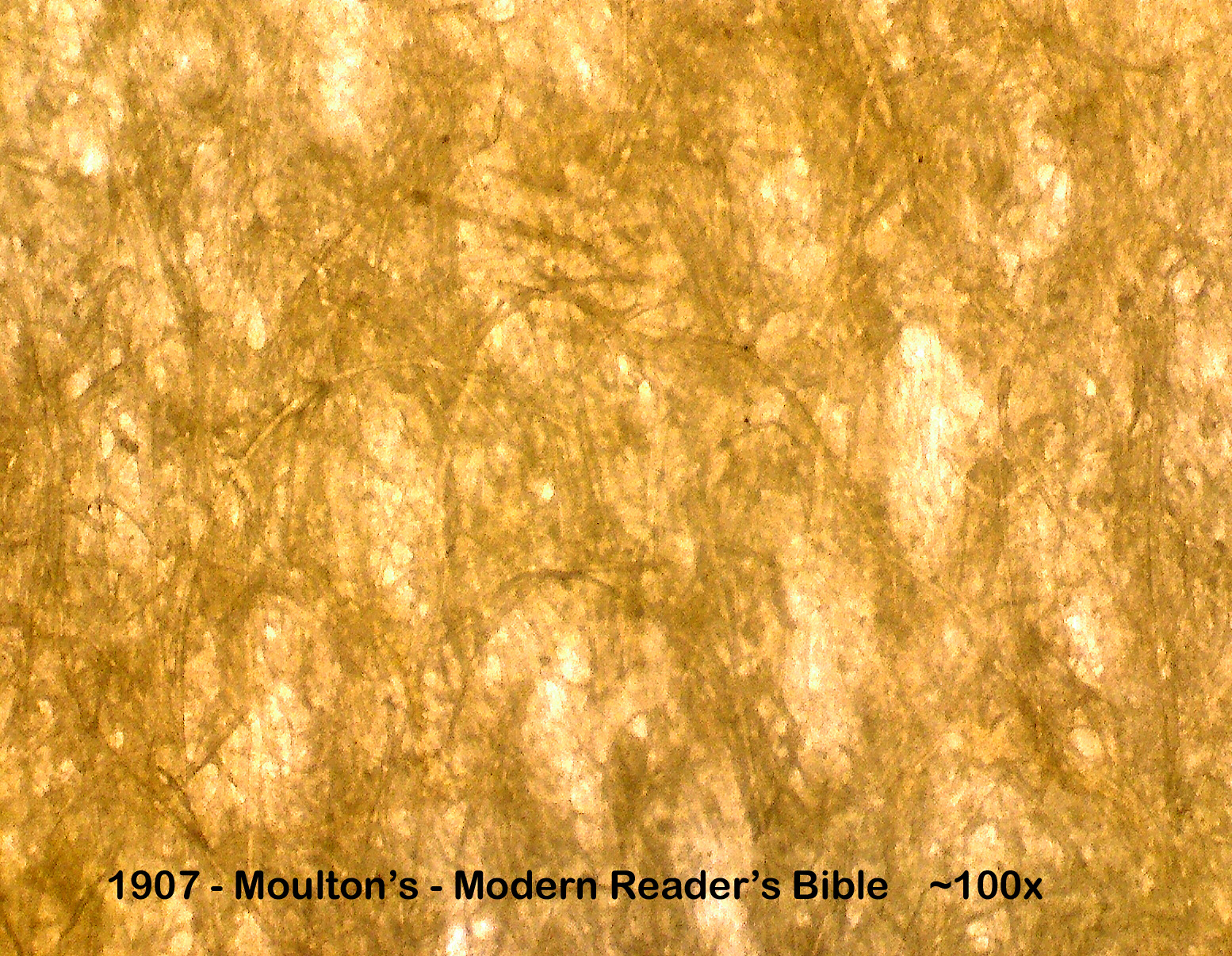 thin at .0019" we will note some ghosting It is similar to today's paper
towels. Despite this, with care it is a pleasure
to read and hold.
Moulton's
reorganizing of the textual formats, produces a
variety of responses, some appear to promote and
easier to read format, hence easier to understand.
Thus is these cases he provides a worthy
improvement! But in other cases, one wonders if
his arrangement is an improvement. Note this page
of John 1:1-18, I added the red marks:
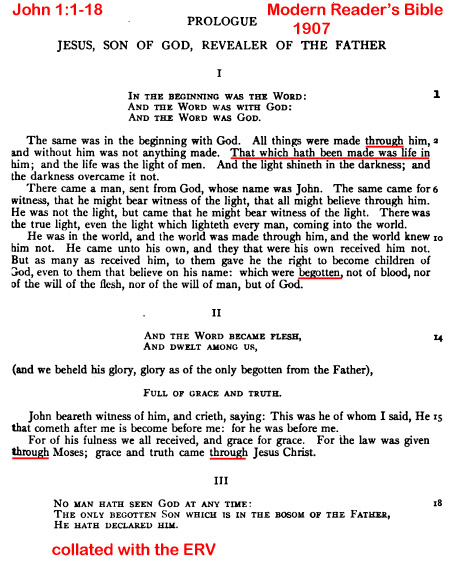 I myself do not perceive the result as an
improvement, others may declare that the author's intent
is clearer. When I read the Psalms in Moulton's
work, I do notice an improvement in comprehension. But
especially so in Ecclesiasticus. In
addition to the standard 66 books of the Bible,
he includes: Tobit, Wisdom, Ecclesiasticus.
All of the work is in a single column format.
Richard Moulton spent an immense amount of effort on this work yet the beauty of it would have been improved had he used the KJV as his base text. The melody and nobility of the KJV fits his type of arrangement much better (I noted this comment in an Amazon review of this book by anonymous). The ERV and the ASV are not gems of eloquence, both though accurate, are rather flat in their warmth. Richard considered this work as his "life's work", which is quite revealing as he had these publishing statistics: not counting the individual 21 volumes!! 52 editions published
between 1907 and 1994 in English, this
just for his Bible (all in 1 edition) 33
editions of "Shakespeare as a
dramatic thinker" 16 editions of his "Bible
Stories Old Testament" 113 editions of:
"The literary study of the Bible : an
account of the leading forms of literature
represented in the sacred writings, intended for
English readers" 23 editions of: "Bible
Idyls" 25 editions of:
"World literature and its place in general
culture" 17 editions of:
'The moral system of Shakespeare : a popular
illustration of fiction as the experimental side of
philosophy' He also had numerous other books published dealing with literature, Shakespeare, and the Bible, the above statistics are provided by www.Worldcat.org. Even more impressive is the fact that the above statistics relate only to the English language publications! He was a busy man.
The
editions are
not rare, the single volume edition was
reprinted a
number of times, I do highlight two volumes
for
exceptional value — the 1924 and 1926
reprints.
(thumbnails at the right). Some of the
earlier 24
volumes may be difficult to locate, in which
case
their value increases. No changes in
texts are noted when comparing all of the many reprints, text thus very
stable. Taliaferro #7705, Hills #'s 2066, 2178, 2511.
|
 24 vols. Modern Reader's Bible + 24 vols. Modern Reader's Bible +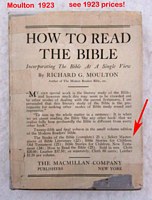 a
1923 publication a
1923 publication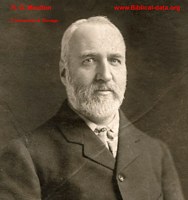 R. G. Moulton R. G. Moulton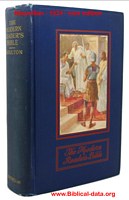 the 1924 edition the 1924 edition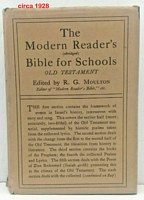 for
schools 1928 for
schools 1928 hard
to find leather hubbed!! hard
to find leather hubbed!!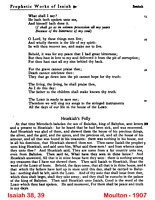 Isaiah sample
Isaiah sample |
|||||||||||||||||||||||||||||||||||||||||||||||||||||||||||||||||||||||||||||||||||||||||||||||||||||||||||||||||||||||||||||||||||||||||||||||||||||||||||||||||||||||||||||||||
|
Holy Bible
in Modern English Base Text - - - - -
- - - - - - - - - - Westcott/Hort (WH) Accuracy of
translation - - - - 6 Value to Christian
faith - - - - - 4 Value as a collectible book - - 7 (1903 NT, and Bible) Affiliation - - - - - - - - - - - - -
- - British - Israelism Publisher - - - - - - - - - - - - - - - S. W. Partridge The late 19th century
scholar, Ferrar Merricmac Fenton, (1832 - 1920) began
in 1853, a half-century of earnest labor on his
translation of the Scriptures, finally publishing the NT
in 1903 (also 1895 a first edition), as well as the
complete Bible. This review is based upon his 1906 Bible.
He had prior published his Bible in various parts,
beginning with Romans in 1882, the NT in 1895, the Five
books of Moses, 1901, and the whole Bible in 1903. Fenton was a child prodigy who (it is
claimed) from the age of seven read the Bible only in its
original languages: Hebrew, Aramaic, and Greek. This he
claims helped him to eliminate any translator bias toward
other popular English versions, so that his resulting work
was not impinged. At the age of 20, he
felt that the difficult-to-understand language of the AV
and its revision, promoted the obsolescence of the Holy
Scriptures, and that our society would therefore be
doomed without a modern revision preserving the actual
elements of the original languages. With such a daunting
task, he set out to preserve the Holy Scriptures in
English. This he worked at for 50 years. Actually
believing that he was saving the Scriptures for mankind
(in English).
He was a businessman practicing
"commerce" in London and an autodidactic as concerns Koine
Greek, Hebrew and Aramaic (or, Chaldee). He was also a
student of philology and linguistics and religion.
In the title page of his various editions he lists the
following "titles" - MCAA (Member of the Cambrian
Archeological Association) and MRAS (Member of the Royal
Asiatic Society). An example of the beautifully printed
work of his is seen in the 1895 edition of the Five
Books of Moses: the actual text is much sharper
than this reduced sample, and has wider margins.....
....but, from the above one can see that it is well laid out, in 2 columns with adequate margins and does not transliterate the non-English languages; the publisher being - S. W. Partridge and Co., London. The font is cleanly printed and a perfect size for comfortable reading. At least 10 editions of Fenton's translation were published in his own lifetime. He also continued to add extra notes to these editions up to 1910. An abridged version was published in 1935 and reprinted in 1951 by Covenant Publishing under the title The Command of the Ever-Living. Fenton was a member of a group known as "British-Israelism", or, "Anglo-Israelism"; which believe that the 10 "lost" tribes of Israel are the ancestors of modern Britons (more precisely) all Anglo-Saxons. [which includes many North Americans!]. Far fetched as it sounds several cult-like groups embrace the concept (such as: the H. G. Armstrong Worldwide Church of God, and it impacts some of the Mormon theories). Modern adherents include the late Mary Baker Eddy, Nelson McCausland a Democratic Unionist politician, Pastor Dr. Gene Scott et al, and several thousand believers in the U.S. and the British Commonwealth. Note this brief quote: partial quote from: Oxford Dictionary of the Christian Church, page 241.A quote from Bible Blessings Christian Resources, reveals some interesting facts: Many unique and interesting features of this Bible translation are not to be found in any other Christian Bible of which we are aware. I will briefly list just a few fascinating aspects. The order of books is set out in the proper Hebrew arrangement: 1st. The books of Moses or Torah, 2nd. The “early reciters” or historians, called in Hebrew, “Nebiim Rishonim,” 3rd. The major prophets, or “Nebiim Akheronim” 4th. The sacred writings, or “Kithobim,” being the Psalms, Solomon and Sacred Writers. As Jews and Messianic Christians are well aware, these early divisions give us the Hebrew name of the Old Testament, called the TaNaKh, an abbreviation for Torah, Nebiim, and Kithobim. Fenton stated that he “decided to follow this order of the books rather than that of the wild muddle in which the European translators of the Dark Ages had mixed them in the Latin and Greek versions.”
In the New Testament the usual
standard order found in our Christian Bibles
is preserved, except that the Gospel of John
has been moved to the first position in the
Gospels. The reason for this is that
Fenton’s own research into the text led him
to the conclusion that it was the first
Gospel to be written, and is to be dated as
one of the earliest books of the New
Testament. Today scholars are still divided
on that subject,[ ! ] but it is at
least interesting that Fenton’s conclusion
would explain the subtle differences in
Greek word usage between John’s Gospel and
his Apocalypse. -end quote-
“Masah and
Meribah” by its English equivalent, “Trial and
Strife.” (Numbers 17:7)
Data below per the 1925 edition
|
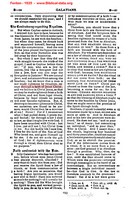 Galatians 2, Fenton 1925 - via Google Books 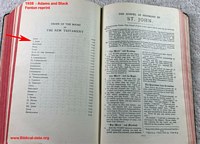 a 1938 edition, showing order of books
a 1938 edition, showing order of books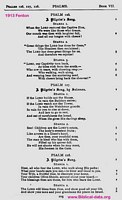 Fenton, 1913, edition,
Fenton, 1913, edition,Psalms sample |
|||||||||||||||||||||||||||||||||||||||||||||||||||||||||||||||||||||||||||||||||||||||||||||||||||||||||||||||||||||||||||||||||||||||||||||||||||||||||||||||||||||||||||||||||
|
Genders - Holy Bible for Daily Reading Base text - - - - - - - - - - - - - -
- Westcott/Hort (WH) Accuracy of
translation - - - - -NA Value to Christian
faith - - - - - NA Value as a collectible book - - 10 (first 1908 edition, quite rare!) Affiliation - - - - - - - - - - - - - - - mostly Baptist Publisher - - - - - - - - - - - - - - - Passmore & Alabaster, London
Information concerning Rev. Genders is scarce, but it is
noted that his children suffered some type of health
problems as seen in this snippet:
Apparently he had at least 4 children, and he
actively
supported Baptist missionary endeavors. He was also
talented
in growing congregations, he often began with a
small group
and deftly expanded it over the years. Arguably due
to his
ministry, he must have been very capable. Besides
these
attributes, he seemed to be a man devoted to the
Lord Jesus
Christ. Quite devout! Paul [page 89] relates
that he formats his text in "portions" as opposed to chapters, (see
insert below). The portions differ in length from the usual chapter
lengths. Below, from an EBAY posting /2022
BINDING
NUMBER
of PAGES
PAGE
SIZE
PAPER
AND PAGE
INFO
|
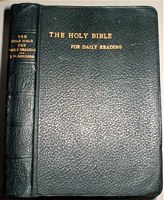 1908 via EBAY |
|||||||||||||||||||||||||||||||||||||||||||||||||||||||||||||||||||||||||||||||||||||||||||||||||||||||||||||||||||||||||||||||||||||||||||||||||||||||||||||||||||||||||||||||||
|
The
University New Testament Base Text - - - - -
- - - - - - - - - - ERV, ASV, KJV Accuracy of
translation - - - - - (1909 edition, follows 1881 ERV
quite well) Value to Christian
faith - - - - - 6 Value as a
collectible book - - 8 for original 1909 edition Affiliation
- - - - - - - - - - - - - - - Methodist/Freemason Publisher - - - - - - - - - - - - - - - University Literature Extension, reprinted - Middletown, Delaware
Upon this earth from 1864 to 1938, dwelt the ambitious Socrates Townsend Weaver. He produced 3 books of the New Testament. His first from 1909 titled:
The University New Testament in modern historical and literary form, for the church, the school, and the home, embracing the life of Jesus Christ in the words of Mark, Matthew, Luke and John, and the church of the apostles according to Acts, the Epistles and Revelation historically harmonized.
His
next published work is titled: The
Biblical Life of Jesus Christ, A
Standard Biography of our Lord in the
Words of the Gospels it
utilized a fair number of notable resources
by, Zahn, Edersheim, Neander, Burton,
Westcott et al. It was not an
entire NT, but just the Gospels with
historical notes. Its base text was the 1901
American Standard Version. Printed by the
John C. Winston Co.. It is full of many
interesting notes and comments, for a sample
see thumbnail. Most likely it is part one of
a two volume New Testament. His 1915 publication was titled: The Greatest Book Ever Written, the New Testament in Its Inspired Literary Form. it is basically the KJV printed in paragraph form. It is 734 pages. Printed in Washington D. C., by the University Literature Extension publishers. A smyth-sewn hardcover, with dark cloth boards and gold gilded edges and lettering. Note thumbnail. - Upon close examination, one will note that he will often alter the KJV, modernizing the pronouns or other alterations such as adding "beloved" before "Son" in Hebrews 5:5.
So in each
work Weaver utilizes a different English
text: ERV, ASV and the KJV. We are not
told why he changes his
base text. Today his work
is also available via print-on-demand,
which are usually terrible
reproductions, pudgy glue-bound
paperbacks. A copy I purchased was
printed in Middletown, Maryland, it
states no publisher; it is part of a
two volume set—its title as it appears
on the front cover is: The Church
of the Apostles, its text begins
on page 235. It does not have within
it the gospels, which are in volume
one. Despite its binding, it is a good
copy. A cheap reproduction, but,
purchasing one of the original
editions can be costly! They are
available, but again costly. Socrates and his wife
Mary (nee Danenhower) had 6 (some
sources cite 8 children) children, One
John Weaver died in the military in
1919. Another son, Paul
R. Weaver was born on 21 November 1893, in
Fontanelle, Adair, Iowa, United States, his
father, Rev Socrates Townsend Weaver, was 29 and
his mother, Mary Moore Danenhower, was 28. He died
in 1951, at the age of 58, and was buried in
William Penn Cemetery, Philadelphia, Pennsylvania.
A daughter, Lovisa Danenhower Weaver was born in
1901, in Oakland, Pottawattamie, Iowa, United
States, her father, Rev Socrates Townsend Weaver,
was 37 and her mother, Mary Moore Danenhower, was
35. She married Fred Francis Berry Sr. on 15 June
1927. They were the parents of at least 1 son.
She died on 6 April 1988, in Wichita,
Kansas, at the age of 86. Another daughter,
Margaret, died at less than one year of age in
1891. As concerns their other children, little
information is available. Socrates was quite active
as an evangelist and speaker wherever
he lived—be it in Philadelphia,
Washington D.C. or Des Moines, Iowa.
He is listed as an "affiliate" in the
New Jersey Grand Lodge of Freemasons.
To what degree he attained, is not
known. Upon examining his work I note
nothing directly related to
Freemasonry. The priesthood of
Melchizedek, is wrapped up in the
mysteries of Freemasonry (as well as
Mormon mythologies). (s.v. Hebrews 7).
At Hebrews 7:21, a variant reading
adds..."after the order of
Melchizedek", Weaver does not add the
variant reading. Weaver adds no
allusions to Masonry. Surviving are letters he
wrote to Presidents Wilson, and
Roosevelt. In a letter to President
Wilson he encouraged the president to
continue to maintain a Sabbath day in
America. (Which we were already
doing), I assume Socrates desired that
it be law, which Wilson said it is
fine as it is, a voluntary day of rest
(Sunday). Weaver presents us with a
nice harmony of the synoptic gospels,
one might inquire WHY? The answer is
similar to that which explains why
make another English NT. Many
"harmonies" had already been
published. In 1892 Albert Huck
produced his German edition of the
Synoptic gospels, as a harmony. In
1907 Finney translated Huck into
English (even the Greek was translated
into English). The
following (modern) harmonies - -
W. G. Rushbrooke's 1880 Synopticon,
Broadus'
Harmony (1894)
and
the
Huck/Finney Synopsis (1892),
not to mention Godbey's NT, 1902
above; these all follow
basically the same layout. Minor
differences can be seen, but
generally they agree. Logically
Weaver utilized one or more of
these (even J. W.Hanson's 1885
harmony) - for the layout of his
gospels.
Certainly Weaver
was aware of these, and if one
compares his harmony to Huck, he
appears to follow the chronology set
forth by Huck (and (Finney). Though in
his introduction he mentions a number
of sources, he does not mention
anything connected to a Huck, Finney,
Broadus, Rushbrooke, Godbey, Hanson or
Robertson. Albeit he does improve
upon many of them, by inserting
apocryphal data, as seen in the
thumbnail, and he adjusts the history
seen in Acts, he inserts at the proper
place letters via the Apostle Paul.
This is a nice feature. However it can
really disrupt the flow of the Acts
narrative. (For an excellent harmony
of the Life of the Apostle Paul, see
Frank J. Goodwin's A Harmony of
the Life of St. Paul, (Baker
Book House) is highly recommended. In
Goodwin's work, the Epistle to the
Galatians receives a proper and
expanded treatment. When comparing Weaver's
work with that of Moulton (see above)
it is clear that they are identical as
both follow the 1881 ERV text. Both
vary in the order of their materials,
but nothing of a major concern, both
are acceptable harmonies.
Finally, not much
information is available concerning
the education or life of our Socrates
Weaver. He appears educated, and
talented. copyright of 1909: 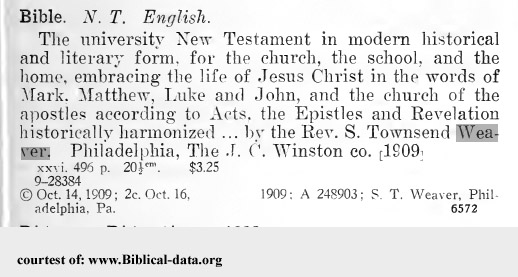 All three editions of
Weaver's work are freely available as
PDF's at the www.archive.org site,
with two copies of the 1909 text:
above, via
www.archive.org
Info below refers to his 1909 NT:
|
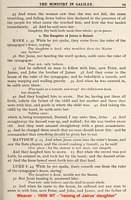 sample of 1909 edition
sample of 1909 edition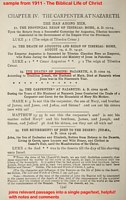 sample of 1911 sample of 1911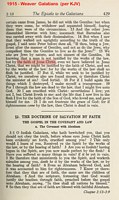 sample 1915, showing Galatians
2 sample 1915, showing Galatians
2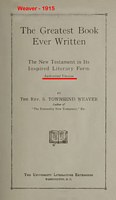 title page of 1915 edition title page of 1915 edition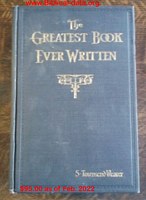 1915 for sale, $95.00 at Biblio
1915 for sale, $95.00 at Biblio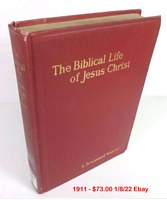 1911 for sale
1911 for sale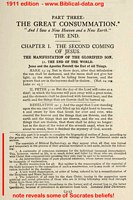 notes from his 1911 text
notes from his 1911 text |
|||||||||||||||||||||||||||||||||||||||||||||||||||||||||||||||||||||||||||||||||||||||||||||||||||||||||||||||||||||||||||||||||||||||||||||||||||||||||||||||||||||||||||||||||
|
The Scofield
Reference Bible Base Text - - - - -
- - - - - - - - - - KJV Accuracy of
translation- - - - - 9 Value to Christian
faith - - - - - 8 Value as a
collectible book - - 9 (1909 edition, and sealskin
edition) Affiliation - - - - - - - - - - - - -
- - Plymouth Brethren/Dispensationalist Publisher - - - - - - - - - - - - - - - Oxford University Press, American Branch
The
quote below is per Glenn R. Goss: - The Scofield
Bible, and C. I. Scofield. quote:
In
1869 he and his family moved to
Kansas, where he was admitted to the
bar to practice law. He was elected
twice to the Kansas legislature, in
1871 and in 1872. President Grant
appointed him as the United States
District Attorney of Kansas June 9,
1873. He affirmed, in the oath of
office, that he had never voluntarily
born arms against the United States .
. . He evidently had no problem with
that claim, even though he had fought
in the Confederate Army. He resigned
December 20, 1873, amid charges and
counter-charges of political
corruption. That ended Scofield's
political career. After that
"career" he began or continued drinking, incurred a
divorce, and faced several legal problems. His wife
noted that he had abandoned her and his daughters,
which was true! He landed in jail several times over
unpaid bills, and also incurred some debts. Scofield
was living a dreary life, a change was needed, and a
change did arrive in the man - Thomas McPheeters, a
Christian businessman. In a Y.M.C.A. shelter, in
1879, Cyrus Scofield began trusting the Lord Jesus
Christ, he never looked back. He viewed his first
marriage (to a Roman Catholic) as a mistake, but it
was she who left - or who filed for divorce, he
complied. Thus this chapter ends. He began to
study the Bible, he was tutored by Dr. James H.
Brookes, a famed limited-dispensationalist. Scofield
made good use of his sharp analytical mind and
learned fast. Early-on he saw the joys of
understanding the Bible in a dispensational manner,
noting who was speaking, to whom, when, and why, and
about what. (The best method of Bible study!).
He was licensed
to preach by the Congregational Churches of St.
Louis. Later he moved to Dallas and began pastoring
a small church. In 1882 it had 11 members, in 1896
it had 815 members. During this time he married
Hettie Hall and they had one child. He began
research on his "project" a reference Bible. He
traveled to Europe for research purposes, a number
of times; in fact he traveled extensively gathering
data, as well as touring, which he enjoyed. With the
help of Frowde, Arno C. Gaebelein and R. A. Torrey
the 1909 reference Bible was published. Oxford
publishers thought well of it. And it paid off. The
Scofield Reference Bible was Oxford's BEST selling
book, in two weeks over one million copies were
sold. From 1915 to 1921, Oxford University Press,
paid $76,847.63 in royalties to Scofield. In his
will he left it to his 2nd wife Hettie and his one
son, Noel Paul. Also to be noted is the fact that
sales of the Scofield Bible helped the Oxford
University Presses to survive WWI. According to
Goss, we do not know how many copies of the 1909
edition were printed. Today the original 1909
edition is rather scarce. My copy was owned by E. B.
Buckalew, who worked at Moody Bible Institute. It
was a well- used volume. Overall, over 6 million
copies of the Reference Bible have been
printed/sold! The Scofield Bible was first copyrighted in 1909, then 1917, renewed 1937 and 1945. Early printings also read: New and Improved Edition. Has an indexed Atlas and in later printings a Cyclopedic Concordance. Most early copies do not contain an added dictionary (per Hills #2444). Each of these editions, 1909, 1917, and this 1945[6] are all KJV. The 1945 edition is typeset in Brevier 8vo, Black-faced. Scofield facsimile series No. 2. Bible text occupies 1353 pages, a later added Concordance another 370 pages, followed by 12 pages of maps, preceded by an index to the maps. (pagination per the 1946 edition minus concordance). Text is in a two column format, with a center reference column. In this edition the name of Rev. William L. Pettingill is added to the list of consulting editors. Volume is black, hardcover, with The Scofield Reference Bible intaglio on the front cover. Spine 21 cm., spine reads: HOLY BIBLE: Cyclopedic Concordance: Scofield Reference Edition: Oxford. My original 1909
edition is a well-used volume is a leather edition,
with nice full yaps, paper edges are gold gilded,
with rounded corners. The paper is now
brittle, .0017", ghosting is slight. It is in
two columns with a center column for references.
Footnotes are at bottom of pages, See thumbnail. It
has a total of 1388 pages (including the end maps).
The printing setup, (via Oxford's Frowde) is
excellent. The actual letter press printing was done
by Eaton & Mains of New York. Frowde,
the printer of Oxford, was a member of the Plymouth
Brethren. In this 1909 edition
the consulting editors were: Rev. Henry G. Weston Quite a distinguished group. In the 1945 edition we note that Rev. William L. Pettingill was added. Scofield became well
grounded in the limited-dispensational* theology, he states
clearly that the Pauline epistles ALONE are directed
to the church of this age. (s.v. note page
1252 et al). His notes in Daniel really
assist the reader in its connection to Revelation,
Scofield lays it all out in clear rational
exposition. It is a joy to see the magnificent
harmony of the Old Testament and the New Testament!
His dispensationalism differs somewhat from some of
his listed consultants as he still believed that the
church of this age began at Acts 2 Pentecost, rather
than in Acts 9-13. A.C. Gaebelein also held this
misconception (s.v. God's Masterpiece, page
120). note this quote from
his original text of Rightly Dividing the
Word, by C. I. Scofield: 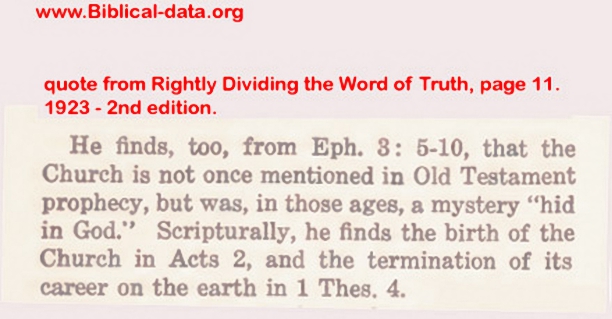 Failure to recognize when the church of
today (this age) began is probably my biggest complaint
with all of the Scofield Bibles. But however, his note on
page 1252 [the 1909 edition, printed below] appears to contradict such a shortcoming seen
above. On the Pentecost of Acts 2, no Gentiles were
present, just Jews and proselytes, hence no union. The
union of Jew and Gentile, into one new man, was revealed
by Paul and first demonstrated in the church at Antioch.
The church of today, began with Paul's ministry (Acts chapter 13
NOT chapter 2).
In constructing the
Reference Bible Scofield desired to present to
readers the results of much research. He claims
nothing original, he simply shares what other
scholars have learned. Besides the consulting
editors, Scofield utilized Thayer, Lightfoot, Sayce,
Ussher, Hengstenberg, H. A. W. Meyer et cetera.
With a massive amount of data available, Scofield
and his editors were able to immerse it into the KJV
text as notes, with an excellent and unparalleled
system of cross references. What a work! It has been
stated that the footnotes are largely the work of
Scofield himself. In chapter 38 of
Ezekiel he states in a note that "all agree" that a
reference in Ezekiel 38:2, refers to Russia. Perhaps
back in Scofield's day, all agreed. However, modern
research suggests that Gog, Meshech and Tubal
actually refer to places in Turkey (north of
Jerusalem). Hence, probably Muslims! (s.v. Edwin
Yamaguchi; Foes From The Northern Frontier,
Grand Rapids: Baker, 1982).
Though Scofield was
long dead, a new edition in 1967 was issued from
Oxford. It utilized the following consultants: Frank E. Gaebelein Though they updated a
few archaic KJV words, their real editing further
corrupted the dispensationalism as presented by
Scofield. The new notes enforce Scofield's
"limited-dispensationalism*"
which is popular, even until today (2023). For the
sake of popularity they damaged the intent of the
notes of the original Scofield Bible. Note for
example the note on page 1352 (1945 Scofield):
That the Gentiles were to be saved was no mystery Romans 9:24-33; Romans 10:19-21. The mystery "hid in God" was the divine purpose to make of Jew and Gentile a wholly new thing--"the church, which is his Christ's body," formed by the baptism with the Holy Spirit 1 Corinthians 12:12; 1 Corinthians 12:13 and in which the earthly distinction of Jew and Gentile disappears ; Ephesians 2:14; Ephesians 2:15; Colossians 3:10; Colossians 3:11. The revelation of this mystery, which was foretold, but not explained by Christ Matthew 16:18 was committed to Paul. In his writings alone we find the doctrine, position, walk, and destiny of the church. In the 1967
edition "alone" is omitted, thus leaving open all sorts of
assumptions. Such as: perhaps other books of the NT are
directed to us (as opposed to being for us); or, one can
follow the dictates seen in James for example, In reality
Paul is the apostle to the Gentiles (not James or Peter, or
Luke, et al). Alone is a meaningful word here.
the 1967
edition says: (f) After
Pentecost the Spirit was imparted to such as
believed, in some cases by the laying on of
hands Acts 8:17, 9:17 What
happened "to Jews only", which is what Acts 11:19 states. Obedience
was necessary prior to Paul's gospel of grace without works
(note Acts 5:32). Again the 1917 edition has this note as part of the introduction to Hebrews:
Church truth does
not appear, the ground of gathering only being
stated (Hebrews
13:13). In the 1967
edition, this phrase above is omitted.
The
book of Hebrews is written to "Jews" not the church, which
is not a popular truth today, thus its omission. Finally
Scofield was charged
(wrongly so) of promoting racism, these deluded
critics usually point to the 1909 note at Genesis 9: 1, in
the notes we point out item number (5): (5) A
prophetic declaration is made that from Ham will descend an
inferior and servile posterity (Gen, 9: 26,27).
(5) A
prophetic declaration is made that descendants of Canaan, one
of Ham's sons, will be servants to their brethren. (Gen. 9:25,
26). Yet the KJV text of 9:25 is (thankfully) unaltered: (Scofield's "inferior" can easily be misunderstood) 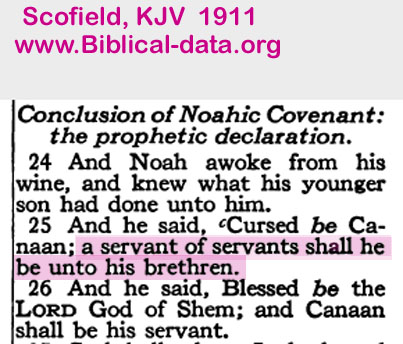 A "servant of servants" may also be
rendered as "the lowest of servants", the argument is not
against Scofield, but rather the Bible! The Hebrew verb -
"shall he be" is a Qal imperfect, suggesting ongoing
action, not a settled historical event. Perhaps even today
these "descendants" are still under the curse?
Many more
examples could be shown, rarely the text of the KJV
been occasionally altered, note I Corinthians 9:20, wherein
"not being myself under the law" is added in italics
in the 1967 edition.
For Scofield purists,
the 1917 or 1945 edition, best reflect the efforts
of Scofield. In the 1967 edition, the text and
especially the notes were greatly altered, as
indicated above. The 2003 King James Version III,
is not reviewed herein, but it is also highly
altered from the original Scofield. The 1920 NT, has
notes which show some very slight changes, but true
to the original, the changes were most likely
corrections added by Scofield himself, shortly
before his death. One final point: the
Scofield Bible/notes taught that the nation Israel
must FIRST be regathered into her land before the
return of the Lord, recall that Scofield and
Gaebelein died decades before Israel was recognized
as a nation (in 1947). This was a nice prophetic
aspect seen in their notes. It greatly assisted with
the hopes of the Zionists at the time. Scofield
correctly taught that the "rapture" (i.e.
translation) of the Church occurs just before the
seven year tribulation, it is after the tribulation
that Jesus Christ returns to
earth to set up His 1,000 year reign. Scofield makes
these events and their order clearer. Note for
example: Hosea 3:5 and its note, Ezekiel 39:
7, 8, 25-29, Romans 11:1 and entire chapter,
and notes, especially the note at 11:26. Certainly
all students of the Bible and of the history of
Israel can only admire Scofield's insights! ___________________
Data below per the 1909 edition
|
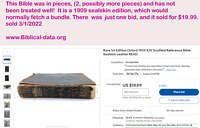 a damaged 1909 survivor, sold
for pennies. a damaged 1909 survivor, sold
for pennies.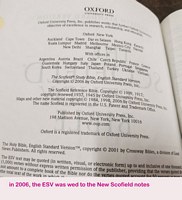 Scofield + ESV Scofield + ESV Scofield + Scofield + HCSB 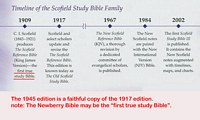 Oxford publication dates 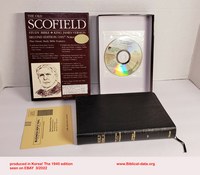 manufactured in Korea - per EBAY 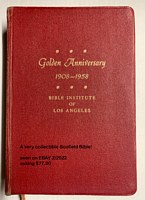 suggested value $80.00 - $120.00 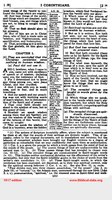 sample - 1917 edition
sample - 1917 edition |
|||||||||||||||||||||||||||||||||||||||||||||||||||||||||||||||||||||||||||||||||||||||||||||||||||||||||||||||||||||||||||||||||||||||||||||||||||||||||||||||||||||||||||||||||
| The Cross Reference Bible (ASV text) 1910 - Harold W. Monser editor Base Text - - - - -
- - - - - - - - - - -1901, ASV Accuracy of
translation - - - - - NA Value to Christian
faith - - - - - 8 Value as a
collectible book - - 8 (1910) Publisher - - - - - - - - - - - - - - - Cross Reference Bible Co., reprinted Baker Book House Included herein is this work edited by Monser, as it is not a translation per se, but it is a very important work. Monser oversaw the publication, it also utilized the following associate editors:  Notice "J. W. Monser" who is the editors father. Also note the great Greek grammarian A.T. Robertson. The 1910 edition filled 2,472 pages. Of which there are: 20 pages of maps, [note: no maps in the 1959 Baker edition] over a dozen pages of indexes, and 20 pages for prefaces. The book of Revelation ends on page 2395, which means the reader has a whopping 2,375 pages of text, text loaded with the ASV. Note that the 1959 Baker reprint does not contain the maps, pagination varies slightly. The use of the famous American Standard Version of 1901, really magnifies the stature and usefulness of this Bible. This is a reference Bible stuffed with steroids! It should be noted that the senior editor (Monser) was a University of California (Berkeley) graduate, he also spoke SEVEN different languages. His wife—Mrs. Monser, was a minister in the Christian Church, serving churches in Urbana, Villa Grove, Vandalia and El Paso—died in 1956. Monser died a young man at age 50. [died of pneumonia]. In his short life he accomplished much. As a member of the Church of Christ he was joined in the publication with the following editors each C of C members, Charles Reign Scoville, J. W. Monser (Monser's father) and D. R. Dungan Theologically the work was possibly influenced by the Churches of Christ. Yet some strong Baptists were also editors: Robertson, and Sampey and Terry. On each page of text, major variant readings are noted, comments from several hundred authors are also noted (hence a nice commentary collection), as well as a large number of cross references, all on each page! It claims to illustrate over 400,000 cross references. However it does not serve well as a stand alone commentary. The English Standard Version's Study Bible boasts over 10,000 pages, but many of these are almost blank pages! Though the Wilmore Reference Bible may be a bit thicker, it is only thicker as it is not just a single book, it has added separate dictionaries, and Cruden's concordance, et al. Monser's effort truly fills all 2,472 pages, only a helpful index [at rear of book] of about 40 pages and the mentioned preface differs from the actual text. Monser was the first called pastor of the Berkeley First Christian Church, 1893-1895. Interestingly, the Berkeley Bible seminary (which Monser helped to establish) morphed into the creation of what became Chapman University in Orange California. Note this snippet: He (Monser) was also
an active evangelist: below from
an Indianapolis newspaper:
In 1972 Logos
International published
the Monser Bible with a few
alterations:
*
Several
paragraphs of the Cross-Reference Bible Preface, The Logos edition added:
*
"The Layman's Commentary on the Holy Spirit", It
is a worthy addition to any Christian library.
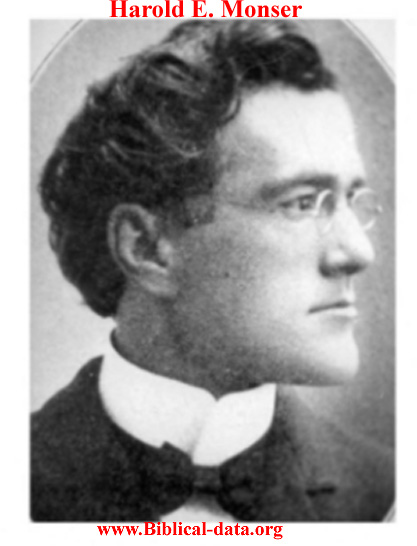 One wonders who generated the idea for this 1910 publication? Monser certainly did oversee the entire work (per the preface), we may never know, was it because the Newberry edition was insufficient, or that Scofield's Bible needed a challenge? Certainly Alexander Campbell and B. W. Johnson's wonderful efforts may have stimulated the effort. (Both these prior efforts by C of C members were innovative editions!). And who or what bore the brunt of the cost of such a large work, was it the collective Churches of Christ? The actual first publishers, the New York Cross Reference Bible Company, (also of Champaign, Illinois) failed a few years after publication. I highly recommend the work, I own and use the 1959 edition. No reference Bible is totally complete, in that each omits various references, one example suffices: at Revelation 20:14 a reference to Revelation 19:20 is oddly lacking. At Romans 3:22 the reading "...[faith] of...[Jesus Christ] is mentioned in the margin, but not at Galatians 2:16. Inside the the dust-cover a Dean Orval Morgan demonstrates how to use the book. He points out that the book contains over 400,000 references, under the title"Jesus" there is listed over 20,000 references! One finds volumes of information in just the footnotes alone! [for example study the footnotes to the genealogy at Matthew 2, lots of data there, and a lengthy quote from R. A. Torrey!, note thumbnail]. Gratefully the 1910 edition is available at www.archive.org In Hills as #2196. [sadly Taliaferro and Paul both lack this author/editor, due to the fact that the text is not a unique translation]
Information below is from the 1959 Baker Book House reprint,. They did a great job!
|
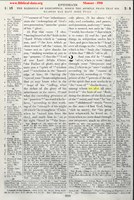 1910 edition. Ephesians 1:15 - 2:5.
1910 edition. Ephesians 1:15 - 2:5. 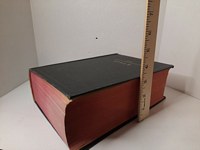 1959 edition size 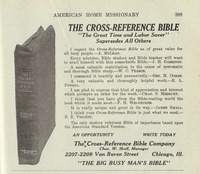 early ad - 1918, leather full yap 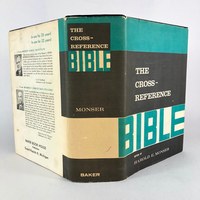 1959 with dust jacket 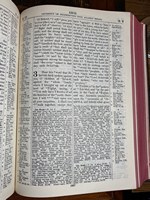 sample Amos 3 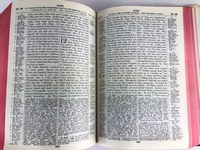 sample John - 1959 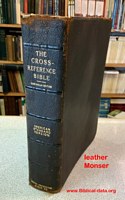 rare leather edition this one without full yap 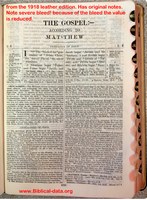 inside the leather edition, note "ghosting" [no yap], unknown date. Herein begins the large amount of data on the two genealogies! 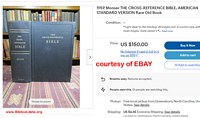 prices high but worth it! |
|||||||||||||||||||||||||||||||||||||||||||||||||||||||||||||||||||||||||||||||||||||||||||||||||||||||||||||||||||||||||||||||||||||||||||||||||||||||||||||||||||||||||||||||||
|
BIBLE UNION,
IMPROVED EDITION Base Text - - - - -
- - - - - - - - - - TR, but changes over time,
toward critical text Accuracy of
translation - - - - - 6 Value to Christian
faith - - - - - 4 Value as a
collectible book - - 8 Affiliation - - - - - - - - - - - - -
- - mostly Baptists, some Anglican Publisher - - - - - - - - - - - - - - - American Baptist Publication Society
In my humble
opinion, the work of Lloyd (see above) of 1905, is
superior to most of the efforts of the ABU. That
said, the ABU folks did produce nice
preparatory volumes, each titled as "Notes....,
on various books of the Bible. In these editions lay
very instructive notes as to how and why various
renditions were generated. These Notes were notable
as in the mid-1800s very few works existed which
displayed critical evaluations of the Greek texts
(and Hebrew). Each were printed in three columns
with the KJV, Greek and revised texts in one of the
columns. See thumbnails for a sample from Ephesians,
1857 and Mark 1858, and Galatians. Each available as
downloads from www.archive.org The actual
revised texts they produced were not always
improvements as desired, often they added confusion,
for example note this side-by-side comparison of the
KJV and the 1912 text of John 1:15:
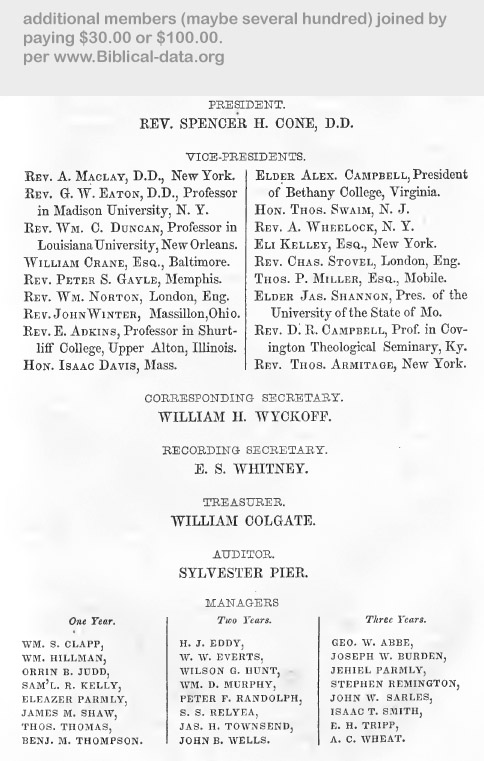 Later members who contributed to the textual evaluations were: Thomas J. Conant, J. W. Morton, N. N. Whiting, John Lillie, Orrin B. Judd, Dr. A. C. Kendrick and others, notably the great Greek grammarian John A. Broadus [1827 - †1895]. (Note Hills #1764). With Alexander Campbell as a member some internal strife occurred with the Baptists, which eventually led to the publication of TWO versions, one translating the Greek "baptizw" as "baptize" and the other showing it as "immerse". Hence some peace ensued. The full title of the 1912 edition was: The Holy Bible Containing the Old and New Testaments - An Improved Edition (Based in part on the Bible Union Version) -- published by the American Baptist Publication Society, Philadelphia. My digital copy contained 1,406 pages, margins are rather narrow, in 2 columns, with no cross references. A few notes at bottom of pages. (see thumbnail). The printing appears clean with little ghosting. Any Greek or Hebrew terms/words are transliterated in the notes.
Data below is per the digital 1912 edition. Various editions and some of the "Notes.." editions are available from: www.archive.org.
|
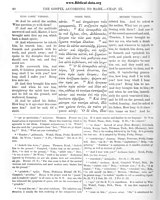 1912 - Galatians NOTES compare with below thumb 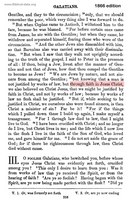 compare with this 1866 edition, Galatians 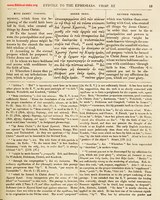 NOTES, sample, Ephesians - 1857
- N.N. Whiting NOTES, sample, Ephesians - 1857
- N.N. Whiting sample _NOTES - Mark 1858
sample _NOTES - Mark 1858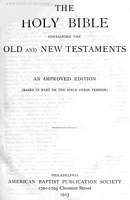 title page 1913 edition title page 1913 edition |
|||||||||||||||||||||||||||||||||||||||||||||||||||||||||||||||||||||||||||||||||||||||||||||||||||||||||||||||||||||||||||||||||||||||||||||||||||||||||||||||||||||||||||||||||
| The New Testament The Authorised Version Corrected Sir Edward Clarke (his spelling!) Base Text - - - - -
- - - - - - - - - - 1881 ERV and the KJV Accuracy of
translation - - - - -NA Value to Christian
faith - - - - - 3 Value as a
collectible book - - 6/7 Publisher - - - - - - - - - - - - - - - -Smith Elder and Co.. London Another "corrected" edition. This published in 1913 by Smith, Elder & Co., 15 Waterloo Place (great Britain). Full title: The New Testament - The Authorised Version Corrected. One must assume that Sir Edward was aware of the effort in 1905 of Lloyd's translation (reviewed above). However he does not mention Lloyd or the editions of the Bible Union "corrections". What is one to think? Upon reading his biography (-ies), just a small single paragraph mentions his NT, out of hundreds of pages of his multi-colored life, just a small paragraph! First a motive must be discovered, why did Sir Edward pursue this endeavor? Clarke was (according to Paul) a lawyer, a politician and a British Knight. Apparently he was well educated (Kings College, London, City College London, et al). He spent many years preparing the morning and evening lessons for the Church of St. Peter, Staines. While doing so, he compared the KJV and the ERV texts for the lessons. He kept notes. Using these notes he composed his "version". The text is a true mixture of the KJV and the 1881 ERV. His motive: he felt that he presented the best of two editions! Simple. I suspect he thought that the labor was valuable or needed. The mixture is apparently based upon (a) the reader's need to comprehend, and (b) improvement in consistency. As concerns his publisher (Smith and Elder) we note this extract from Wikipedia: Smith, Elder & Co., alternatively Smith, Elder, and Co. or Smith, Elder and Co. was a British publishing company which was most noted for the works it published in the 19th century. It was purchased by John Murray in the early 1900s, its archive now kept as part of the John Murray Archive at the National Library of Scotland in Edinburgh, Scotland. The firm was founded by George Smith (1789–1846) and Alexander Elder (1790–1876) and successfully continued by George Murray Smith (1824–1901). They are known to have published as early as 1826. They are notable for producing the first edition of the Dictionary of National Biography (DNB). END QUOTEThis NT edition is a nice and attractive hardcover. But I doubt if it will see much use. It survives as a curiosity. A quite collectible volume! Clarke (1841 - 1931) came from a family of limited income at the time (300 pounds per year), and it was due to scholarships that the young Clarke was able to attend college. His parents were strict Calvinists. Biographies are available about his life, a life which presented to the reader a true gentleman, and a man who worked hard at whatever he endeavored to achieve. He became one of England's best lawyers (barrister), he was also a respected politician. Though not much is mentioned of his New Testament "translation"— as it seems almost trivial compared to the accomplishments of this man. He wrote a number of treatises on the Gospels, in addition to publishing a volume or two of his speeches, and of course his edited edition of the New Testament which he proudly considered the best in the language. He was proud of his New Testament. He also felt that his NT was the most accurate available! He omits quite often as per the KJV, - Mt. 16:20, 20:7, Lk 23:38, 24:49, Acts 7:37, Ro. 9:28, 3:22, 15:29, I Cor. 6:20, 10:28, Eph. 3:9, I Pet. 4:14, Jude 25, Rev. 2:13, 12:17 and 16:17 all omitted. At I Tim. 3:16 he reads "He" for "God". Readers' today can test for themselves the degree of accuracy resulting from this amalgamation of the two texts, I do note some improvement in some passages, I mean after-all the man had a keen mind, and was actually of a humble sort, good ingredients for a translator (or editor). Three sample verses were chosen to display this composite nature.
Hopefully the complex mixtures are apparent. In the Luke citation, the added words seen in the KJV, are actually in the Greek Majority text; which brings up the fact that nowhere is it recorded that Clarke knew any—or was taught any—Koine Greek. Hence, in Romans 4:25, "again" is not in the Greek (nor is it in the Lucan passage), however this Greek word, a verb (anistemi) occurs 111x in the Majority text (108 in Nestle Aland), and it means "up-stand", passively "to be raised". The KJV adds "again" 15x to this verb without warrant. [Though the prefix "ana-" could be taken to mean "repeat" or "again", thus "stand-again" but not "rise again"!]. Consequently, various decisions of his lack veracity, and simply add to the general confusion of Scripture. Albeit his text of Romans 1:12 comes across as easier to understand! One may also note the inconsistency of the ERV herein ("again" in Luke, but not in the Romans passage). It is available freely at: https://archive.org/details/newtestamentauth00clarrich
|
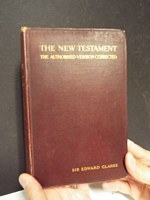 1913 cover 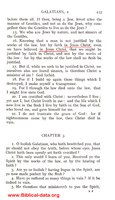 Galatians 2-3 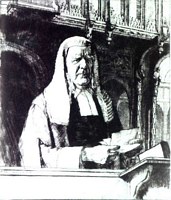 the Barrister! 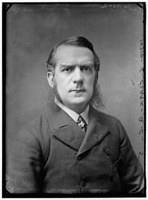 serious Clarke |
|||||||||||||||||||||||||||||||||||||||||||||||||||||||||||||||||||||||||||||||||||||||||||||||||||||||||||||||||||||||||||||||||||||||||||||||||||||||||||||||||||||||||||||||||
|
Numeric
New Testament - Ivan Panin Base Text - - - - -
- - - - - - - - - - Ivan Panin's Greek NT, (close to
Westcott/Hort) Accuracy of
translation - - - - -8 Value to Christian
faith - - - - - 8 Value as a
collectible book - - 8 (original edition 1914) Affiliation - - - - - - - - - - - - -
- - generic Christian Publisher - - - - - - - - - - - - - - - Grafton, Mass. (Mark Vedder's 2014 edition is a corruption)
Panin
was born in Russia in 1855, and died an American
citizen in 1942 at age 86. He was a serious
looking fellow:
Besides
being serious looking, he was a genius in
mathematics! After
graduating from Harvard–wherein he learned Greek
and Hebrew–in 1882, with a Master's degree in
Literary Criticism, he became well known as a
guest speaker. He traveled extensively across
the U.S. lecturing upon the classics (such as
Tolstoy and Turgenev et al),
additionally he was a confirmed
agnostic. In 1890 while reading John 1:1, his
mind exploded with the truth that the Bible
was/is the inspired Word from God. His
conversion was actually headline news in some
of the newspapers in America. He saw in the
Greek text of the New Testament amazing
numerical manifestations: he spent the next 50
years of his life revealing these. He labored
night and day, and it cost him his health. He
produced over 43,000 pages of notes, several
Greek word concordances (a 1,000 page one, and
a 2,000 page concordance). A review of
some of his work is available at this
following link:
However,
when I began to read his 1914 English
translation, I was floored! Seriously
impressed. First, there was the accuracy of
his English renditions, second, was his
literalness his following of his Greek New
Testament, very very accurate. So I read more. Grammarians
all know that ambiguity can raise its plural
heads when translating genitives (objective or
subjective), or prepositions (agency or sphere
et al). Usually translation committees
deviated little from established norms. For
example in Galatians 2:16, the preposition
"dia" with the genitive "pistews Iesou
Xristou" is there typically rendered as "faith
in Jesus Christ". Note: NASB, NIV, CEV,
NLT et cetera. Whereas the
Geneva and KJV render it as "faith of Jesus
Christ". There in Galatians 2:16 Panin follows
the crowd, he has it as: "through faith in
Jesus Christ". All are grammatically possible.
But do note that Panin correctly recognized
the preposition "dia" here as "through".
Personally I take issue with the "IN Jesus
Christ" indicating Him as the object of faith.
The second "faith IN Christ", utilizes the
Greek preposition "ek" and in my mind it
should be rendered as "out of", as in "out of
faith of Christ" in the second portion of
Galatians 2:16, indicated in the thumbs at
right. I, as my followers know, would
translate as per the Geneva and KJV, as it is
His faith which justifies us, not our conjured
faith! Nor our works. Hence a subjective
genitive. However, Panin will at times, pick
the wrong choice in my opinion, as
demonstrated at Galatians 2:16. Mark
11:22 reads per Panin as: "Have God's faith",
instead of the typical "have faith in God".
Here Panin was right on! In Galatians
2:7, Panin reads: "gospel of the
uncircumcision", for both Paul and for Peter's
gospels he has "of the circumcision" in the
same verse. Now, behind Panin's renderings,
one would notice that these genitives are free
to imply:
the good news of uncircumcison (for
Paul) (ASV, KJV) Whereas
the typical renderings for these genitives
are: the gospel to the uncircumcised - for
Paul (NASB, NIV) each
of the renderings are grammatically correct,
but the resultant meanings are very different.
Evangelicals cannot accept the plain fact that
there are different gospels displayed in the
NT. Paul's unique gospel is GOOD news about
uncircumcision. Imagine convincing a
first century Jew of that! Paul had a hard row
to hoe, but misrepresenting his gospel, only
adds to the confusion. Yes Paul went to the
Gentiles, and Peter focused upon his ministry
in Jerusalem, yet the content of their GOOD
NEWs' differed. Peter prepared Jews for the
Kingdom, Paul prepared any hearers for heaven.
Read their writings! (Compare I Peter with I
Timothy for example.) Note
and compare his rendering of Ephesians 3:11,
12 Jesus
our Lord 12 in whom we have
:boldness and access in confidence through his
:faith. Jesus
our Lord 12 in whom we have
boldness and confident access through faith in
Him. - NASB Jesus
our Lord 12 in
whom we have the bold and
confident access through our faith
in Him.
- Weymouth Jesus
our Lord
12
in whom we have
boldness and access
with confidence
through our faith in
Him. -
Letchworth. Jesus our Lord 12 through whom, as we have faith in Him, we enjoy our confidence.... - Moffatt
Should
anyone wish to
view Westcott
and Hort's
Greek text in
English,
Panin's
translation is
head and
shoulders
above all, it
closely
reflects
Westcott and
Hort, the
closest I have
yet
encountered. Despite
my rhapsodic
endorsement of
Panin's
English
translation,
he is not
perfect, he
has flaws. In
his 1914
English
translation,
at Matthew
2:11, Panin
has "...came
into the house
and
found the
little child".
For
"found",
Westcott and
Hort
read
"saw", as do
most Greek
manuscripts.
"Found" is
seen in the TR
and numerous
Latin mss,
perhaps in his
second edition
he corrected
it
(?)....or...
does "found"
fit his
numeric
scheme?
Critics often
claim that
Panin selected
from the
variant
readings only
those which
satisfied his
numeric
arrangements.
However since
his work is so
close to that
of Westcott
and Hort,
would the
critic's claim
that WH picked
and chose
variants per
some numeric
scheme? Indeed
not, Panin's
renderings
truly reflect
his earnest
numeric
conception. He
keeps the
woman caught
in adultery,
and the long
ending of
Mark, and the
final two
verses of
Romans 16. He
typically
omits passages
in line with
Westcott and
Hort (Matthew
1:25
[firstborn],
Acts 8:37 et
al). For
years I have
lamented that
"men" was
omitted at
Acts 7:2 (as
in the NASB),
of course
Panin has
it. He
states in his
introduction
to his 1914
English
translation,
that every
Greek word is
rendered by
the SAME
English word.
He does not
abide by this.
For example at
Galatians 6:2
and verse
5, he
wrote "burden"
in each verse.
They are
different
words in the
Greek, and a
"backpack
(i.e. load)"
is not the
same as a true
"burden". I
have heard
entire sermons
based upon the
faulty KJV
rendering of
these two
Greek words
("burden" and
"load"), had
the orator
utilized the
Greek text the
whole sermon
would have
been
corrected. The
Mark Vedder editions are not included below.
The original 1914 edition is not easy to find!
|
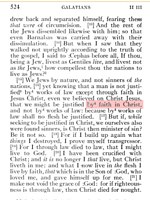 Galatians 2, 1914 edition 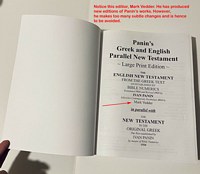 title page of a modern "reproduction" 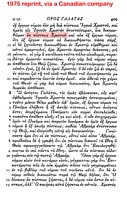 sample of Panin's Greek New Testament, Galatians 2
sample of Panin's Greek New Testament, Galatians 2 |
|||||||||||||||||||||||||||||||||||||||||||||||||||||||||||||||||||||||||||||||||||||||||||||||||||||||||||||||||||||||||||||||||||||||||||||||||||||||||||||||||||||||||||||||||
|
The
Twenty-Four Books of the Old Testament
Accuracy of
translation - - - - -as accurate as is the KJV Value to Christian
faith - - - - - 6 Value as a
collectible book - - 8 Affiliation - - - - - - - - - - - - -
- - Jewish apparently Ashkenazic Publisher - - - - - - - - - - - - - - - The Hebrew Publishing Co.. New York
Alexander
Harkavy 1863 - 1939, born in Russia, and died an
American in New York city. He was
educated privately, and at an early age displayed a
talent for philology.
In 1879 he went to Vilna,
where he worked in the printing-office of the Romm
Brothers in 1882 he went to America, then in 1885 to
Paris, returning again to America to reside in New York.
It is largely due to Harkavy's efforts that Yiddish was
recognized as a world language, his Yiddish dictionaries
place the language on firm footing. Dictionaries available at www.archive.org
Besides his works on Yiddish, Harkavy
as noted, also worked on translating Scripture into
English, starting with Genesis (published
1915), then Psalms (1915),
then The
Twenty-Four Books of the Holy Scriptures According to
the Masoretic Text (1916), with reprints
following. He had the Hebrew text on pages facing the
KJV text, which he carefully modifies. The 1916
edition is in two and or four volumes. The
printing is quite fine and clean. Very little is
stated as to the source of his Hebrew text, other than
it is from the Masoretic. There is no preface other
than a single page which states that he maintains the
KJV as far as possible. It is unfortunate that he did
not provide data upon his source Hebrew text, he
assumes that "Masoretic" is sufficient. He does
provide some footnotes which explain certain Hebrew
textual aspects (see thumbnail for the Isaiah 53
image).
His modifications of the KJV are usually
corrections, for example at Genesis 3:15, he replaces
the pronoun "it" with the correct "he"; "And I will put enmity between thee and the woman, and between thy seed and her seed; he shall bruise thy head, and thou shalt bruise his heel."
"If any of thine be driven out unto the outmost parts of heaven, from thence will the Lord thy God gather thee, [and from thence will he fetch thee:]" - underlined text omitted in Harkavy's English and Hebrew.
Let's now compare a sample text from
Harkavy, parallel with Leeser and the KJV: 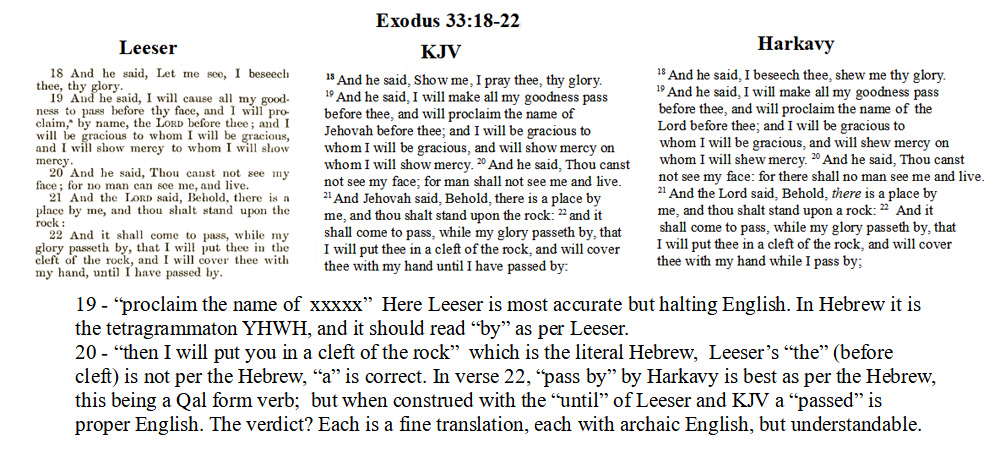 Not much revealed in the above, except to
note that each is definitely KJV based! Leeser in his
Preface (page iii) really berates and deprecates the
English Bible (the KJV), as he considers it "a
perverted and hence erroneous rendering" of the
Hebrew. However he is all to quick to adhere to
it as evidenced by just the above sample. Further, he
boasts of using numerous versions, texts and the works
of his highly praised German theologians—one is left
wondering why he so closely follows the Christian
English Bible?? Sure Leeser's OT was quite literal, but
it is Harkavy's English translation which is prominent
today! He was also a busy author. (Leeser may have
solidified the Jewish presence in America, but it was
Harkavy who established Yiddish as a proper language,
as noted in the publications below) From
Wikipedia note the following partial list of his
publications:
He did publish an English version of the Hebrew OT, for
English speaking Jews, simply called "The Holy Scriptures":
in 2000 it was titled as "The Holy Bible".
The Holy Scriptures [see second thumb]First
published in 1916, revised in 1951, by the
Hebrew Publishing Company, revised by Alexander
Harkavy,
a Hebrew Bible translation in English, which
contains the form Jehovah as the Divine Name in
Exodus 6:3, Psalm 83:18, and Isaiah 12:2 and
three times in compound place names at Genesis
22:14, [see thumb], Exodus 17:15 and Judges 6:24
as well as Jah in Psalm 68:4. The use of the
divine name Jehovah was and still is very
unusual for a Jewish Bible, although this Bible
never gained the popularity of the JPS Tanakh,
Alexander Harkavy has been remembered for his
contributions to Jewish literature and the
development of modern Yiddish. This Bible's
translation style is comparable to the 1917 JPS
Tanakh.
|
| BOOK, or
edition |
Good condition $$ |
FINE condition $$ |
| 1916 (2 vols.) |
$70.00 (for set) |
$100.00 - $300.00 |
| 1916 and 1928 (4 vol. sets) |
$80.00 (for set) |
$150.000+ (for set) |
| 1930's era reprints (2 vol) |
$50.00 (both vols.) | $85.00 (both vols.) |
| |
|
|
|
BINDING |
NUMBER of PAGES |
PAGE SIZE |
PAPER AND PAGE INFO |
| 2
volumes hardcover
smyth-sewn |
vol.
1
-
660
vol.
2 -
724
illustrations
are
grayscale
on
same paper
as
text. |
140
mm x 210 mm .0027" (the
height of a vol. from the
4 vol. set is 240 mm) |
single
column, Hebrew and English
on facing pages. Paper
off-white, minimal
ghosting. |
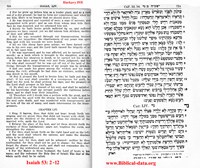 Isaiah 53 2-12 - Harkavy 24 Books...
Isaiah 53 2-12 - Harkavy 24 Books...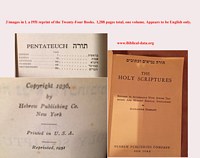 from
a 1951, English Bible for Jewish readers
from
a 1951, English Bible for Jewish readers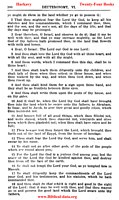 Deut.
6 from 24 Books...
Deut.
6 from 24 Books...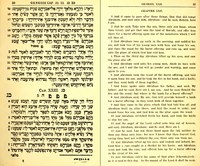 note
Jehovah.. Genesis 22:14, seen in all of his English
translations
note
Jehovah.. Genesis 22:14, seen in all of his English
translations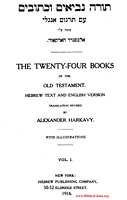 1916 title page 24 Books...
1916 title page 24 Books...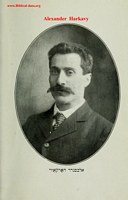 our man, middle
aged
our man, middle
agedBase Text - - - - -
- - - - - - - - - - Nestles Greek text (4th edition)
Accuracy of
translation- - - - - 4
Value to Christian
faith - - - - - 4
Value as a
collectible book - - 9 (1914 and 1919 editions)
and that from
infancy thou hast known3 sacred
writings, those that are able to make thee
wise unto
salvation through faith that is in Christ
Jesus.
| BOOK, or
edition |
Good condition $$ |
FINE condition $$ |
| 1914 |
$80.00 + |
$100.00 - $175.00 |
| 1919 |
$70.00 |
$150.00 + |
| 1926 and 1930/35 |
$70.00 + | $95.00 - $130.00 |
| |
|
|
|
BINDING |
NUMBER of PAGES |
PAGE SIZE |
PAPER AND PAGE INFO |
| hardcover
smyth-sewn |
514
including
the
appendices |
1914
edition 4" x 6" inches!
|
single
column |
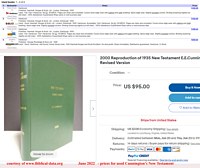 2022 prices for used editions, and one new reproduction.
2022 prices for used editions, and one new reproduction.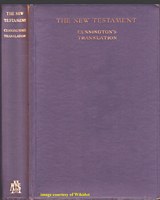 1935 cover, note full title!
1935 cover, note full title!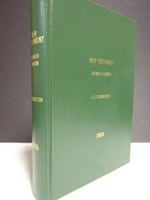 cover
of a new repro via probably Wiph and Stock, 1935 text.
cover
of a new repro via probably Wiph and Stock, 1935 text.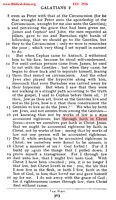 Galatians 2, 1926 edition
Galatians 2, 1926 edition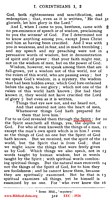 see
comments, I Cor. 2:10 - 1926 edition
see
comments, I Cor. 2:10 - 1926 editionBase Text - - - - -
- - - - - - - - - - basically a Rabbinic edition
Accuracy of
translation - - - - - 6
Value to Christian
faith - - - - - 2
Value as a
collectible book - - 5
First group
Doctor Marcus Jastrow, Editor-in-Chief, [later replaced with Doctor Solomon Schechter] with Doctor Kaufman Kohler and Doctor Frederick de Sola Mendes as the other members of the Editorial Committee.
There is given herewith a list of the translations prepared for the Society from 1892 to 1901:
Genesis, Max Landsberg, Rochester, N. Y.
Exodus and Leviticus, L. N. Dembitz (deceased), Louisville, Ky.
Numbers, David Philipson, Cincinnati, Ohio.
Deuteronomy, F. de Sola Mendes, New York.
Joshua, Joseph H. Hertz, London, England.
Judges, Stephen S. Wise, New York.
II Samuel, Bernard Drachman, New York.
Jeremiah, Sabato Morais (deceased), Philadelphia, Pa.
Ezekiel, Henry W. Schneeberger, Baltimore, Md.
Joel, Oscar Cohen (deceased), Mobile, Ala.
Amos, H. Pereira Mendes, Now York.
Obadiah and Jonah, J. Voorsanger (deceased), San Francisco, California.
Micah, Maurice H. Harris, New York.
Nahum, L. Mayer (deceased), Pittsburgh, Pa.
Habakkuk, R, Grossman, New York
Zephaniah, M. Schlesinger, Albany, N. Y.
Haggai, S. Mendelsohn, Wilmington, N. C.
Malachi, D. Davidson, New York.
Job, Marcus Jastrow (deceased), Philadelphia, Pa.
Ruth, Joseph Krauskopf, Philadelphia, Pa.
Ecclesiastes, Gustav Gottheil (deceased), New York.
Esther, William Rosenau, Baltimore, Md.
I and II Chronicles, M. Mielziner (deceased), Cincinnati, Ohio.)
What a group! Experts each, but corresponding via mail and sharing back and forth via mail would take up many years (America to and from Europe). The situation was changed as they realized that working via correspondence would take far too long. So in 1908 a new group was formed, consisting of:
Second
Group
Doctor Solomon Schechter
“ Cyrus Alder
“ Joseph Jacobs
“ Kaufman Kohler
“ David Philipson
“ Samuel Schulman
“ Max L. Margolis
Professor Israel Friedlaender, (for one year replacing Dr. Schechter)
Again
trimmed but a great group of Jewish scholars. Note: no
Christians, no women and no Gentiles! They also explain in
their preface that christological interpreations are out
of place in a Jewish Bible! I agree, in fact any
interpretation should not malign any Biblical text, Jewish
or Catholic, or Protestant, or New Age. period.
Below is
a demonstration of a difficult passage in the Hebrew
anyways. Psalm 103:5, illustrating the passage in several
editions: (Kittel II, is Biblia Hebraica, the 1913
edition (before the Russian manuscript charged into the
scenario):
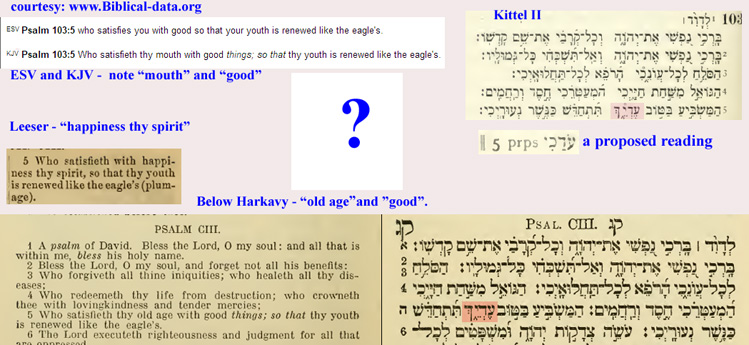
Not an
easy text, but when the context is surveyed, the rendering
by Harkavy appears the best, and this is close to what the
NASB prints - " Who satisfies your years with good things"
(footnote - shows for "years", "desires"). RSV
- "Who satisfies you with good as long as you live".
The other renditions using "mouth" and "desires" et al,
(Geneva, KJV) do not make as much sense. And myself, being
an elderly person, I can definitely concur with the "old
age" renditions. Hence I vote for the Jewish Publication
Society, its translation is:
Who
satisfieth thine old age with good things - Psalms 103:5
In
many other passages, as concerns our translation under
review (the JPS), one must read carefully, and various
subtle changes appear which seem suspicious. It helps
if the Hebrew can be consulted. For example, in
Jeremiah 23:36 the JPS text injects an interrogative,
which is not in the Hebrew: every man's "vision" or
"dream" does become his or her's own prophecy and
hence does pervert the word, no question here. JPS
reads:
"...for
every man's own word shall be his burden; and would
ye pervert the words of the living God, of the Lord
of hosts
our God?"
ASV Isaiah 9:1 But there shall be no gloom to her that was in anguish. In the former time he brought into contempt the land of Zebulun and the land of Naphtali; but in the latter time hath he made it glorious, by the way of the sea, beyond the Jordan, Galilee of the nations.
ESV Isaiah 9:1 But there will be no gloom for her who was in anguish. In the former time he brought into contempt the land of Zebulun and the land of Naphtali, but in the latter time he has made glorious the way of the sea, the land beyond the Jordan, Galilee of the nations.
KJV Isaiah 9:1 Nevertheless the dimness shall not be such as was in her vexation, when at the first he lightly afflicted the land of Zebulun and the land of Naphtali, and afterward did more grievously afflict her by the way of the sea, beyond Jordan, in Galilee of the nations. ["and" as per the 1560 Geneva, and the Catholic Douay]
NAS Isaiah 9:1 But there will be no more gloom for her who was in anguish; in earlier times He treated the land of Zebulun and the land of Naphtali with contempt, but later on He shall make it glorious, by the way of the sea, on the other side of Jordan, Galilee of the Gentiles.
RSV Isaiah 9:1 But there will be no gloom for her that was in anguish. In the former time he brought into contempt the land of Zebulun and the land of Naphtali, but in the latter time he will make glorious the way of the sea, the land beyond the Jordan, Galilee of the nations.
| BOOK, or
edition |
Good condition $$ |
FINE condition $$ |
| 1917 |
$20.00 |
$30.00 |
| later reprints |
$10.00 |
$20.00 |
|
BINDING |
NUMBER of PAGES |
PAGE
SIZE
|
PAPER AND PAGE INFO |
| hardcover,
smyth-sewn, side
stitched end
signatures |
1136, preceded with a 15 page preface et al | 125
mm x 180 mm.
narrow margins,
edges red tipped.
text is in 2
columns. |
off
white, some minor
ghosting, .0027"
thick. Type is
clean. since 1945
apparently
offset-lithography.
Poetry texts in
poetical formats.
Main text is in
paragraph format
(see thumbnail).
Paper is smooth,
lightly sized. |
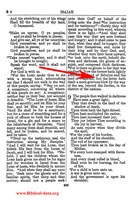 Isaiah
8,9
Isaiah
8,9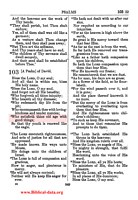 Psalms
103
Psalms
103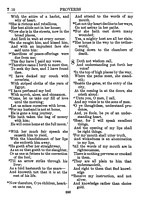 Proverb sample,all thumbs of 1917 edition
Proverb sample,all thumbs of 1917 editionBase Text - - - -
- - - - - - - - - - - Tischendorf's transcription
of Codex 01
Accuracy of
translation - - - - - 3
Value to
Christian faith - - - - - 4
Value as a
collectible book - - 8 - for the 1918 edition, including
earlier publications
Affiliation - - - - - - - - - - - -
- - - Churches of Christ
Publisher - - - - - - - - - - - - - - - first edition [1800s] self published, then The Standard Publishing Co. Cincinnati
Henry Tompkins
Anderson was born on 27 January 1812, in Caroline,
Virginia, United States; his father, John Burbidge
Anderson, was 46 and his mother, Martha Patsy
Tompkins, was 46 when Henry was born. Henry
married Jane Ellen Buckner on 9 January 1832. They
had numerous children, some sources say 10-14. He
ministered largely for Disciples of Christ
congregations, in the south, including Washington
D.C.. Anderson died September 19, 1872.
It has been
recorded that Anderson often farmed out his
numerous children, leaving them scattered with
friends in 3 or 4 different locations. Once in a
orphanage. His wife -- it is said -- was very
tolerant, and made sure he had no domestic duties.
It is also known that Anderson often relied upon
the hospitality of others, even relying upon them
to pay his rent, whenever he had a rent due. In
his latter years, he got all of his family
together when he accepted a position to preach at
Washington D.C. small Disciples of Christ Church.
He died while serving there.
A layman,
Anderson spent much time studying the Bible, and
in 1864 made his first published (he self
published via the Franklin Type Foundry,
Cincinnati) New testament - 1,000 copies printed,
569 pages. He attempted to improve upon the KJV.
In 1866, a newer edition was published by John P.
Morton and Co., which publisher issued a smaller
edition of 408 pages (the first was 568 pages).
Between the 1864 edition and the 1866 edition
there is only a few changes - "Paraclete" is
"Advocate" in the later edition (thanks to William
E. Paul), note Hills # 1805. In 1867 an edition
was also published in England.
Shortly before
his death, Anderson came across Tischendorf's
transcription of Codex 01 (Sinaiticus). He
translated it, but it was not published until
1918, and even then the publisher (The Standard
Publishing Company - a popular Churches of Christ
publisher) which -- according to William E. Paul
-- had sales of the 1918 edition so poor, that the
publisher bundled up the remaining copies and sold
them as scrap. In the 1918 edition Anderson
rendered baptism as "baptism" and not as
"immersion" as he had done in his previous
editions. William Paul also states that no more
than a few thousand copies of all four editions
were ever printed.
I might
mention that during the war, he was in Kentucky
making his first translation, as many Disciples of
Christ (Campbellites) were pacifists, though not
all, Anderson certainly was. The Civil war helped
contribute to the splintering of the Churches of
Christ (i.e. in my terminology herein I consider
both groups as one, unless otherwise
indicated).
So copies are
rare of any of his publications. The Codex
Sinaiticus website uses Anderson's translation as
an English guide to the Greek manuscript, and if a
person who reads Greek compares them, it would
become clear that Anderson did a poor job. His
earlier editions (upgrading the KJV) may be
useful, but the 1918 work leaves much to be
desired. For example when comparing with the
famous Codex, we note:
in John 1:13 he renders
"bloods" as a singular "blood", it is plural in 01
Acts 6:7 the original hand of 01 has "Jews", not
"priests".
I Corinthians 1:4, the original hand of 01 omits
"my" (as in "my God")
I Corinthians 1:14 "God" is not in the original 01
I Corinthians 2:1, the original 01 reads "mystery"
not "testimony".
I Corinthians 5:3, "as" is not in 01
I Corinthians 5:4, "for or Lord Jesus", 01
actually reads - "Lord Jesus Christ"
I Corinthians 6:4, "judgments" is singular in 01
I Corinthians 6:19, "bodies" should be singular as in 01
Galatians 2:12, for "they had come", 01 reads "he
came"
Galatians 3:1, "among you" is
not in 01
Galatians 6:15, Anderson omits "for in Christ" (
before "there is neither circumcision...")
Galatians 6:10, "as we have" is subjunctive,
should read "as we may have..."
Ephesians 1:16, the second "you" is not in 01
Ephesians 3:9, omits "and", which he has in his
earlier editions, it is in 01
Ephesians 3:9, "men" is not in 01
I could go on
and on, but you get the idea, it is not a
trustworthy translation, I wonder if Anderson had
lived longer, would he have produced a better
effort? One wonders. Should a reader desire a more
faithful translation of Codex Sinaiticus the 1902
work by Godbey (above) is much better.
One more
demonstration; often Anderson just follows the
KJV: text is I Timothy 4:10
10 For this reason we both labor – Anderson
and suffer reproach, because we
trust in the living God, who is
the Saviour of all men, especially
of believers.
10 For therefore we both labour --- KJV
and suffer reproach, because we
trust in the living God, who is the
Saviour of all men, specially of
those that believe
10 For to this end we labor
and
– ASV and Sinaiticus,
as well as Godbey
strive, because we have our hope
set on the living God, who is the
Saviour of all men, specially of
them that believe.
The ASV, Godbey and Sinaiticus are correct with
“hope set on”. NOT trust. And finally,
editions of Anderson's translations are
available at www.archive.org
This review is
based upon a digital text. The 1918 edition has
adequate margins, very little ghosting, and is in
a two column format. The printing is very clean.
(see thumbnail). His earlier editions, command a
fair price as well due to their rarity.
| BOOK, or
edition |
Good condition $$ |
FINE condition $$ |
| 1918 |
$40.00 |
$80.00 - $100.00 |
| |
||
| |
|
|
|
BINDING |
NUMBER of PAGES |
PAGE SIZE |
PAPER INFO |
| hard cover | 320
pages |
180 mm
spine |
N/A |
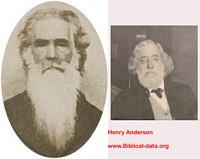
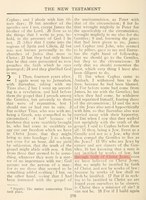 Galatians 2, 1918
Galatians 2, 1918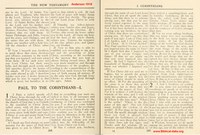
Base Text - - - - -
- - - - - - - - - - - Von Soden Greek (NT): hypercritical
Hebrew text
Accuracy of
translation - - - - - 5
Value to Christian
faith - - - - - 3
Value as a
collectible book - - 7
James Moffatt (no middle name) was born July 4, 1870, in Glasgow, Lanarkshire, Scotland. He died June 27, 1944, in New York City, N.Y.. He was a Scottish biblical scholar and translator who single-handedly produced one of the better known modern translations of the Bible. His publisher was usually - Harper and Brothers.
Educated at Glasgow Academy and Glasgow University, Moffatt was ordained in the Church of Scotland in 1896 and immediately began a career of pastoral service that was to last 16 years, during which time he produced his first scholarly writings. His Introduction to the Literature of the New Testament, a comprehensive survey of contemporary biblical scholarship, appeared in 1911, while he was pastor of a church at Broughton Ferry, Scotland. The next year he joined the faculty at the University of Oxford and in 1913 published his translation of the New Testament. James married Mary Reith on 29 September 1896, they had 4 children.
FROM WIKIPEDIA
"In beginning his work in 1901, he arranged the New Testament into what he perceived to be historical order and provided an original translation of the New Testament, The Historical New Testament. Being the Literature of the New Testament Arranged in the Order of Its Literary Growth and According to the Dates of the Documents.
Moffatt's departed from traditional translations in several areas. Firstly, he held to the documentary hypothesis and printed his Bible in different typefaces (see thumbnails) according to which author he believed had written each particular section. Secondly, he dated most books hundreds of years later than most theologians did at the time, which stemmed from his doubt about the historical accuracy of many of the biblical books (especially in the Old Testament). Finally, he rearranged the biblical texts (usually by switching chapter orders), based on his judgments about the content, authorship, and historicity of the texts. For example, John 14 comes after John 15 and 16 in the Moffatt Bible.
He raised
objections from many scholars but proved very
popular and started a trend toward more
paraphrased translations. His translation
received praise from C. S. Lewis, and was
one of those frequently used by Martin
Luther King Jr."
END QUOTE
[I added the underlines]
He
received the degree Doctor of Divinity from the University
of St Andrews in April 1902, it was given to him via the
honorable method. [ Professor Moffatt was awarded honorary
degrees of Doctor of Divinity by the University of Oxford
and by the University of St Andrews of which Queens College,
Dundee was then a part.] In 1911 he was appointed
Professor of Greek and New Testament Exegesis at Mansfield
College, Oxford, but he returned to Glasgow in 1915 as
Professor of Church History at the United Free Church
College. From 1915 to 1927 he was professor of church
history at the University of Glasgow , publishing
his Old Testament in 1924 in two volumes. From
1927 - 1939 he was Washburn Professor of Church History at
the Union Theological Seminary, New York. [at
the time Union Theological Seminary was the largest Biblical
oriented University in the world, and exceedingly liberal].
Although his own chief interest was in church history, he is
better known for his New Testament criticism; he edited a
series of commentaries on the New Testament, published
1928–49. After his formal retirement in 1938, he continued
teaching and served as a consultant to a radio serial
dramatization of the Bible.
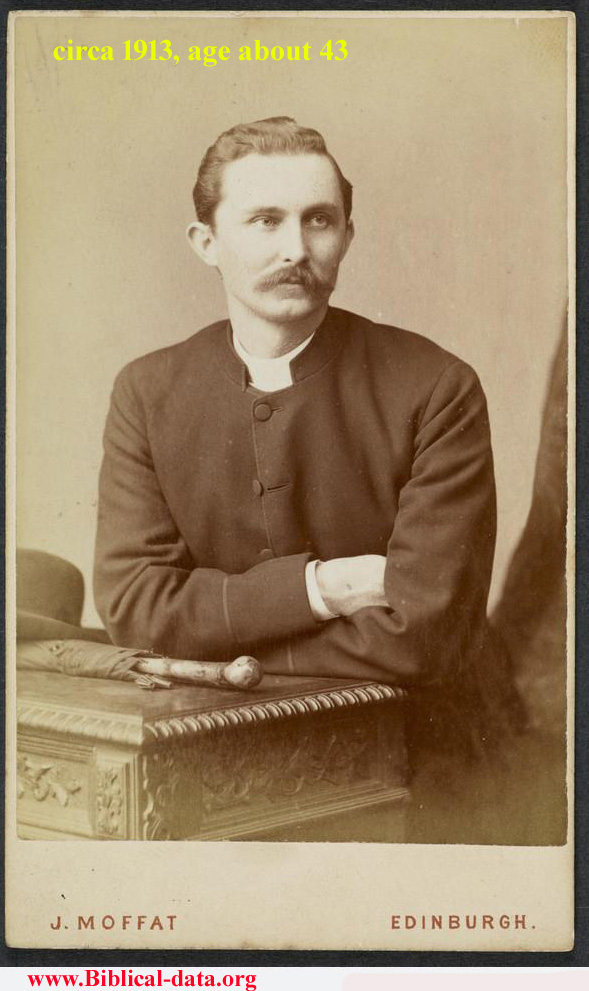
Probably during his experience at Glasgow, his mind was corrupted with the teachings of the liberal German critics (Baur, Eichorn, Geddes, Hupfield, De Witte and Graf). Wellhausen in 1885, amplified what the earlier Frenchman's theory declared (Jean Astruc) and this documentary hypothesis theory became all the rage in the German universities and elsewhere in Europe; via whom or how, it is hard to determine when these liberal influences attracted Moffatt. But without question he denied the veracity and inerrancy of the Scriptures.
Moffatt even displayed his perceived differences in authorship of the Pentateuch via the use of different fonts, or the use of brackets. He uses double brackets to indicate texts he believes are editorial additions or later interpolations. (Double brackets can be observed at II Kings 9: 7-10; he also moves I Kings 21 to follow chapter 19, without alerting the reader why). This method made reading his OT a displeasure.
He moves entire chapters and verses to fit his scheme, or his chronology. It is true some of his transpositions make sense such as moving Exodus 2:23-25 to follow 4:26, but this is a needless move! At other times his rearrangements really confuse the flow of the texts such as his disruptions observed in Genesis chapters 34 - 38. The NT is also attacked: note that he moves Romans 2:14 to follow verse 16, which to me is absolutely wrong!
Then we are faced with his renderings. It has been said that early readers enjoyed the ease of reading the prose, and that the translation "allows the reader to quickly follow the progress of thought" and that his rendition is, "a clear and beautiful translation in the light of illuminating documents uncovered by modern research" - from 1935 dust-cover. Blah blah blah, however as time passed readers began to note some strange renderings, as for example Hebrews 4:12 (as per his 1935 and earlier renditions)
For the Logos of God is a living thing,
active and more cutting than any sword
with double edge, penetrating to the very
division of soul and spirit, joints and
marrow—scrutinizing the very thoughts and
conceptions of the heart.
"Logos" is
the usual "Word", but here rendered as Logos. Elsewhere he
will often render logos as word, as for example at: Mt.
26:44, Mk 4:14, Hebrews 7:28 and 13:7, et cetera.
"Thing" is not in the Greek, "is" reflects a
present tense participle, it could be viewed
as "Word" being the subject, and "living" the participle as
the predicate nominative, similar to "The Word is
living...". "Living" is definitely masculine, not a thing!
At times he inserts strange additions, such as in Ephesians
5:26,
At
Acts 26:12, in his early renditions—he rendered the
Greek plural "priests" as "priests" but he, in his 1935
rendition, rendered it as a singular "the high priest".
He failed to recognize that there were numerous "chief
priests" (same Greek word) and his renditions reflected
his confusion.
At Isaiah 26:9, he ignores the pronouns, which are each
1st person singular in the Hebrew, instead he
makes them plurals: below is his 1935 rendition,
"we
have been yearning for thee in the night, our
spirits eagerly in search of thee."
For such an esteemed scholar, these and hundreds more irregularities defy explanation. It seems that Moffatt placed himself above the written Word. [final note - at Galatians 2:16, he has faith IN Jesus Christ]
HNT,
below is: The
Historical New Testament. Being the Literature of
the New Testament Arranged in the Order of Its
Literary Growth and According to the Dates of the
Documents.
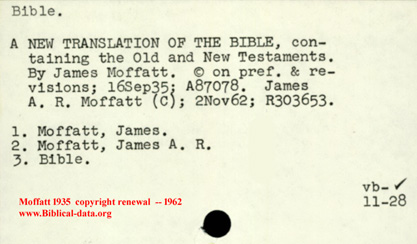
| BOOK, or
edition |
Good condition $$ |
FINE condition $$ |
| 1901 (NT within HNT) |
$80.00 |
$120.00 |
| 1913 (NT) (printed in GB) |
$60.00 |
$80.00 - $100.00 |
| 1922 (NT pebbled leather) |
$35.00 |
$45.00 |
| 1922 (NT parallel w/KJV) |
$55.00 |
$75.00 |
| 1924 (OT, 2
vol.))
|
$35.00 per volume |
$50.00 per volume |
| 1926 OT single vol. |
$40.00 |
$55.00 |
| 1935, NT, goat skin w/yap black, miniature |
$55.00 |
$75.00 |
| 1941 Shorter version |
$20.00 |
$30.00 |
| 1935 Bible |
$25.00 |
$30.00 |
| hard cover,
smyth-sewn |
a 45 page
introduction then - 1039
pages OT, 329 pages NT |
182 mm x
124 mm, margins adequate, but
bottom narrow. |
.00190",
slightly off-white, some
ghosting. Edges red tipped. |
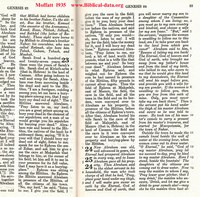
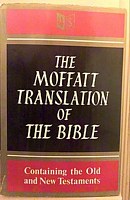 1922 dust cover
1922 dust cover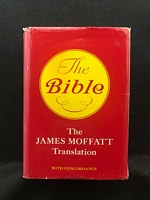 1976 dust cover
1976 dust cover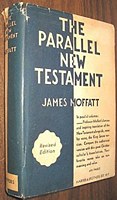 1944 parallel dust
cover
1944 parallel dust
cover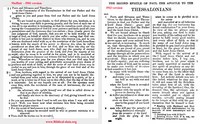 compare 1913 and 1901 Moffatt
compare 1913 and 1901 Moffatt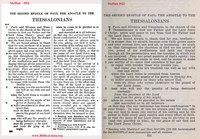 compare 1913 to 1922 Moffatt
compare 1913 to 1922 Moffatt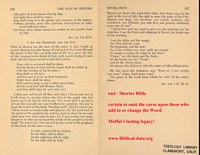 end of Shorter
Bible 1935
end of Shorter
Bible 1935 EBAY ad for a 1935 edition
EBAY ad for a 1935 edition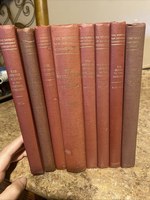 Moffatt commentary
8 volumes
Moffatt commentary
8 volumes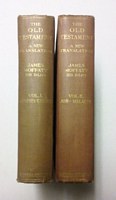 OT - 2 volumes, 1930 printing
OT - 2 volumes, 1930 printing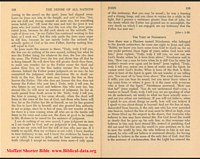
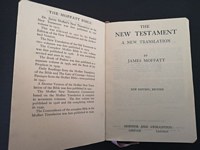 Moffatt "minature"
w/publication info
Moffatt "minature"
w/publication info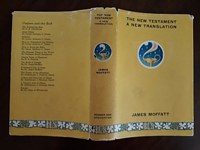 1924 dust cover Hodder and
Stoughton
1924 dust cover Hodder and
StoughtonBase Text - - - - -
- - - - - - - - - - - King James Version
Accuracy of
translation - - - - - NA
Value to Christian
faith - - - - - 7
Value as a
collectible book - - 9 (a tough one to find!)
Affiliation - - - - - - - - - - - - -
- - Churches of Christ
Publisher - - - - - - - - - - - - - - - "Simplified Bible" House, U.S.A., also Bible Advocate, England
A nice compact book and an enjoyment to read and use. Here
is an ad for his NT, circa 1944:
Simplified New
Testament
Black-face type.
Fits man's coat pocket.
Self-pronouncing in part.
Simplified translations of hundreds of hard
passages.
References on thought and NOT mere words.
At beginning of each book, an account of writer,
ones written to, and subject
written on.
An important outline of the argument in each book.
Carefully prepared headings scattered through each
page. Many short talks can be
obtained from this handy
book.
Makes nice present to anyone.
Price, substantial cloth, $2.00; six copies, $10.00
[end of ad]
475 pages (with
an additional 8 page introduction), smyth-sewn, with
rounded corners, edges tipped in red. Margins are
satisfactory, notes are in a lighter font. The words
in the KJV which were in italics, are just in the
regular font in Sommer's work. Book cover is a
nondescript black. Pages have two columns, in verse
format, (see thumbnail) book introductions are at
the beginning of each book, chapters typically have
a heading. Minimal ghosting, and the pages are
cleanly printed, which printing was done at:
"Simplified
Bible" House
918 Congress avenue
Indianapolis,
IN.
AND
"Bible Advocate"
73 Park Drive
Colne, England
This work reminds me of the Amplified New
Testament, as it often has notes which simply
offer a variety of synonyms. He often defines
difficult words or scenarios. He will often refer
the reader to the Revised Version (which seems to be
the English 1881 text). Being a staunch Church of
Christ member, be gently emphasizes the notion of
works as being necessary to salvation. In the book
of Revelation, his added notes make it very clear
that the "beasts" are either pagan or papal Rome and
the Catholic church. Which teaching reflects a
rather common Protestant view emerging from out of
the 1800s. He also gently implies that the
millennial saints live with Christ for 1,000 years in
heaven, as opposed to the understanding that
the millennium occurs on earth. With these
aside, his notes are usually helpful and orthodox.
In his
introduction he printed a "chart" of the "Three Ages
of Religion", reproduced below:
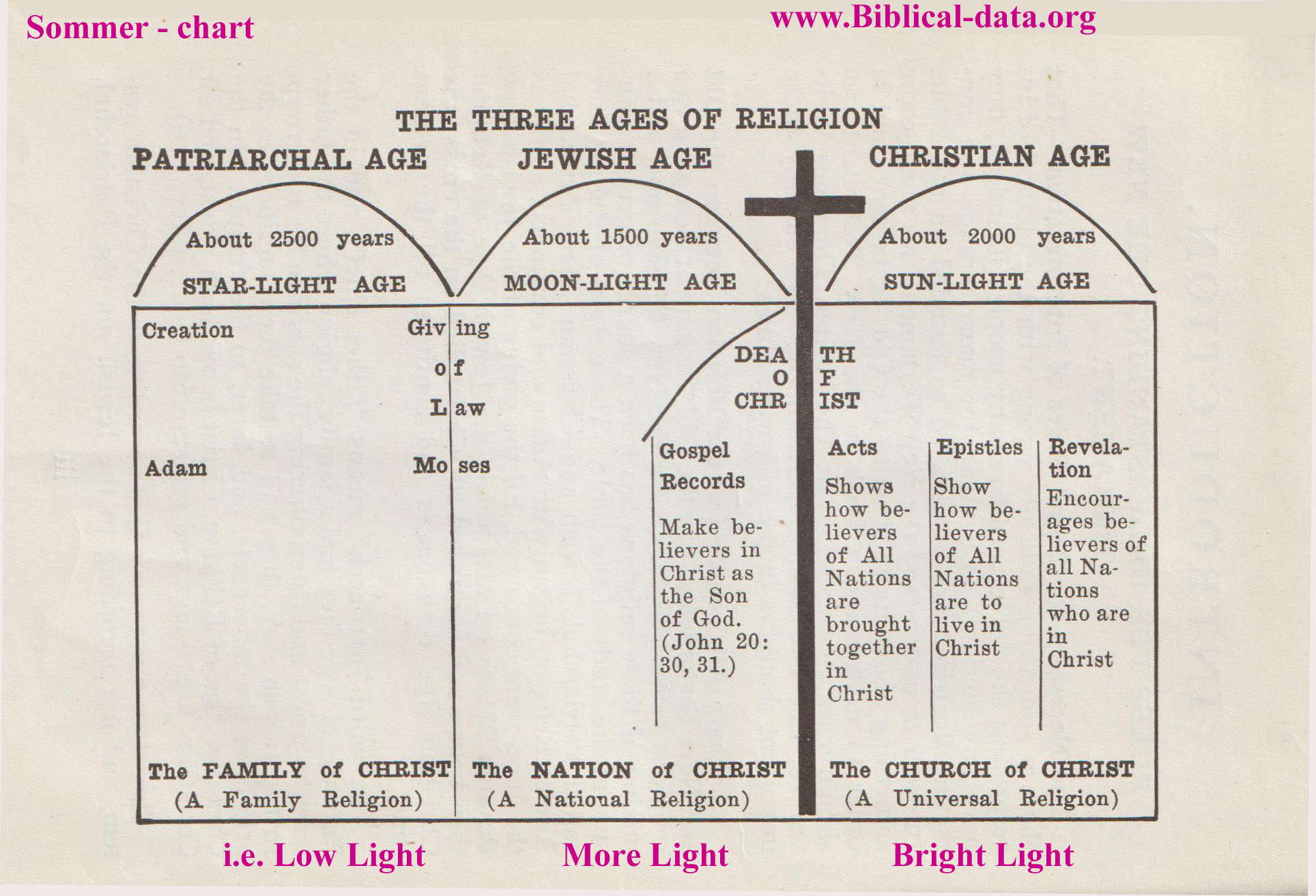
In each age, more truth "light" is revealed.
Doctrinally, it is rather benign.
Daniel
Sommer (1878 - 1952) was the son of an
influential Church of Christ gospel preacher also
named Daniel Sommer. Young Sommer was raised in a
Godly home, and came to value the raising of
children as that of being prayerfully fed the Bible
throughout their childhood. He was born in Kelton,
Pennsylvania. As to religious zeal, he followed
closely his father. In 1886 he purchased the American
Christ Review (a periodical, which he renamed
as the Octographic Review), which opened a
door for his extensive ministry of various written
articles. In 1905 he visited and traveled in, the
near east (Bible lands) and used the experiences to
write his first book, Meditations in Bible Lands
- 1910. His family (via his father) also published
the Apostolic Review.
In 1907 he
married Pearle Grider, and they had six children,
one of which was a son (Daniel Paul, 1908 - 1992).
For some years he and his family—all of whom
participated in the publication of the Apostolic
Review—had many quarrels within their family.
These quarrels affected the publication of the Apostolic
Review. Which publication was popular within
the Disciples of Christ churches. In his efforts to
achieve some sort of unity amongst the Disciples of
Christ churches, many verbal battles ensued. Sommer
simply was too conservative.
He believed the Bible and the Bible only should be
the basis of family life and education.
This belief had
the possibility of producing God-fearing men and
women within our society. Hence promotion of peace,
and truth. Idealistic? Yes, but still a goal. Sommer
wrote, no, emphasized the need for nurturing
children in God-fearing homes, he knew that this
could help to produce a strong society. Other church
of Christ members saw him as an extremist, as he was
in favor of banning music during worship, banning
female pastors, avoiding religious colleges, not
supporting certain large evangelistic societies and
generally upholding most conservative Biblical
practices and principles. Thus he was slowly
relegated to the outside of most Churches of Christ
(or Disciples of Christ). The many quarrels which
existed within the Disciples of Christ churches,
plagued Mr. Sommer up until the time of his death,
by heart attack. He spent many years preaching and
writing, striving for the always out-of-reach unity
he sought for.
The good news is
that this man did leave behind some well written
efforts as well as his "Simplified New Testament".
As far as collectors are concerned, his New
testament is rather rare, as well as his other
books.
| BOOK, or edition |
Good condition $$ |
FINE condition $$ |
| |
|
|
| 1923 NT |
$70.00 - $90.00 | $95.00 - $120.00 |
| |
||
|
BINDING |
NUMBER of PAGES |
PAGE SIZE |
PAPER INFO |
| hard cover
smyth sewn |
483 total |
145 mm x 176 mm. .0036" | supple, not
bright, no ghosting. Two
columns, rounded corners, edges
tipped in red. Cleanly printed. |
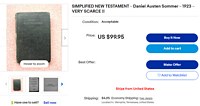 an EBAY ad - circa 2022
an EBAY ad - circa 2022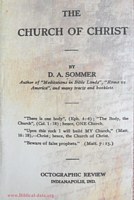 one of his several publications
one of his several publications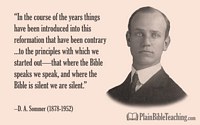
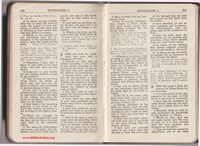 sample, Ephesians 2 - 1923
sample, Ephesians 2 - 1923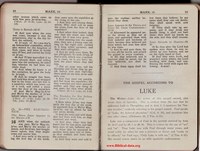 Mark 16, no notes separating
vss 9 -20, from regular text
Mark 16, no notes separating
vss 9 -20, from regular textBase Text - - - - -
- - - - - - - - - - Nestle's Greek NT, plus
reference to older translations
Accuracy of
translation - - - - - 4
Value to Christian
faith - - - - - 3
Value as a
collectible book - - 7 (first edition 9, 1923)
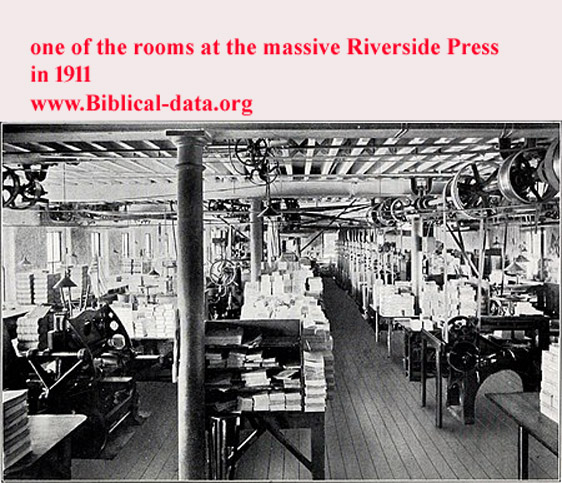
| BOOK, or edition |
Good condition $$ |
FINE condition $$ |
| 1923 |
$70.00 |
$100.00 - $150.00 |
| 1934 |
$50.00 |
$90.00 |
|
BINDING |
NUMBER of PAGES |
PAGE SIZE |
PAPER INFO |
| hard cover
smyth sewn |
452 total
pages |
124 mm x 175 mm. | supple, not
bright, some ghosting. Single
column. Cleanly printed. .0022"
page thickness |
 2022
EBAY ad, volume is only in fair condition
2022
EBAY ad, volume is only in fair condition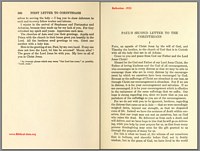 first edition, 1923, no verse
numbering
first edition, 1923, no verse
numbering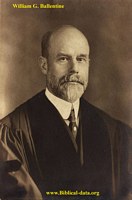 our editor
our editor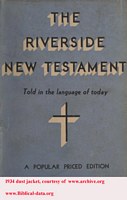 1934 dust jacket
1934 dust jacket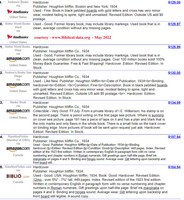 sample prices asked (1934 editions only), 1923 much rarer!
sample prices asked (1934 editions only), 1923 much rarer!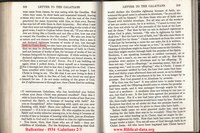 1934 Galatians 2/3 (note verse
numbers)
1934 Galatians 2/3 (note verse
numbers)Base Text - - - - -
- - - - - - - - - - -Greek text behind the 1881 English
revision (basically Westcott and Hort)
Accuracy of
translation - - - - - 6/7
Value to Christian
faith - - - - - 6
Value as a
collectible book - - 7 single volume 1924 (the 2 volume set - 9)
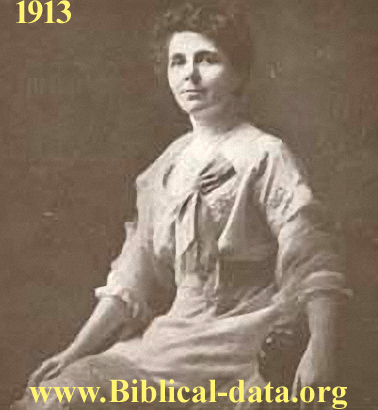
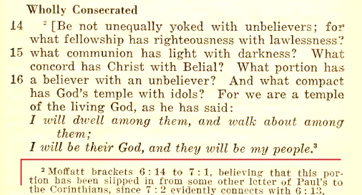

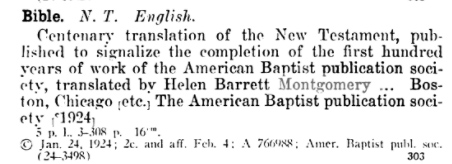
| BOOK, or edition |
Good condition $$ |
FINE condition $$ |
| 1924 (the 2 vol. edition) |
$25.00 each volume |
$40.00 + for each volume |
| 1924 single volume |
$25.00 |
$40.00 |
| post 1924 Judson press reprints |
$20.00 |
$30.00 |
| 1988 Holman reprint |
$15.00 |
$15.00 |
|
BINDING |
NUMBER of PAGES |
PAGE SIZE |
PAPER INFO |
| hard cover
smyth- sewn |
724
pages (no end matter) a few
footnotes are seen |
100 mm x
159 mm. Margins rather narrow |
supple, not
bright, minor ghosting. Single
column. Cleanly printed. .0020"
page thickness. text in
paragraph format, edges tipped
in red |
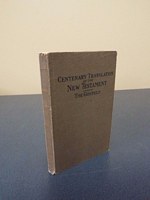 volume
one of the rarer 2 vol. set
volume
one of the rarer 2 vol. set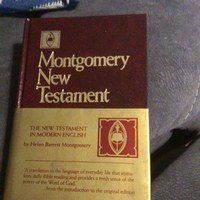
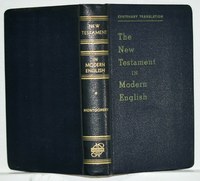
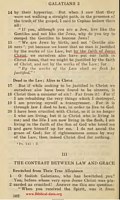

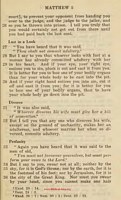
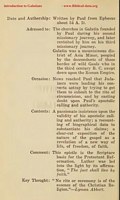
Base Text - - - - -
- - - - - - - - - - - ASV
Accuracy of
translation - - - - - 8
Value to Christian
faith - - - - - 3
Value as a
collectible book - - 7
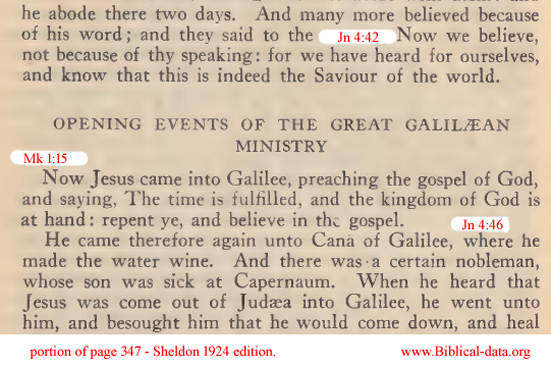
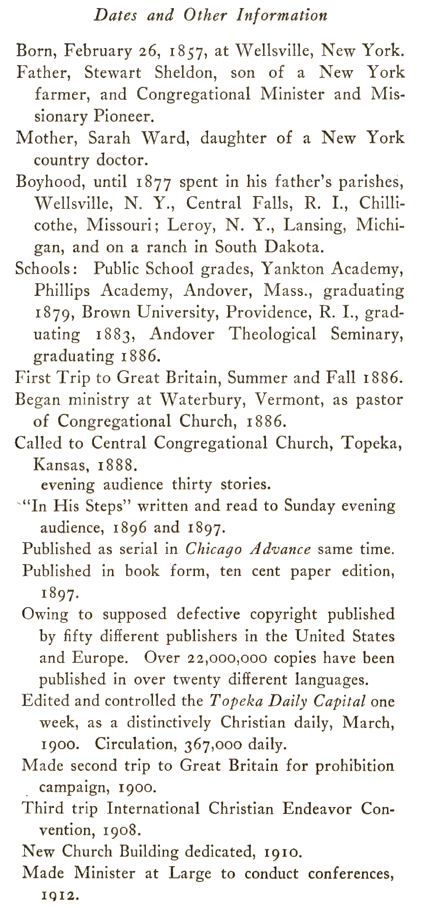
| BOOK, or edition |
Good condition |
FINE condition |
| 1924 | $8.00 |
$25.00 |
| 1939 | $7.00 |
$20.00 |
| |
||
| |
|
|
|
BINDING |
NUMBER of PAGES |
PAGE SIZE |
PAPER INFO |
| hard cover
smyth- sewn |
640 pages | 35 mm x 200
mm. Nice wide
margins. |
supple,
off-white, Single column.
Cleanly printed. page thickness
.0048", text in
paragraph format. |
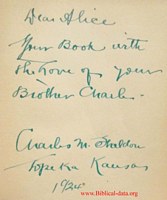 signed copy, to His sister
signed copy, to His sister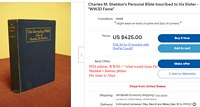
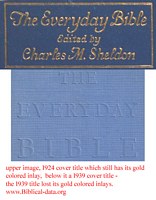
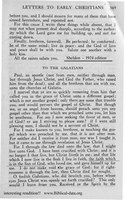
BASE text - - - - - - - - - -
- - - - - codices 01, 02, 03 (plus a select few
MSS), Weymouth's Greek New Testament
Accuracy of translation - - -
- - 4
Value to Christian faith - - -
- - - 4
Value as a collectible book -
- - 8 (first editions: 1919-1926 NT, 1931 Bible)
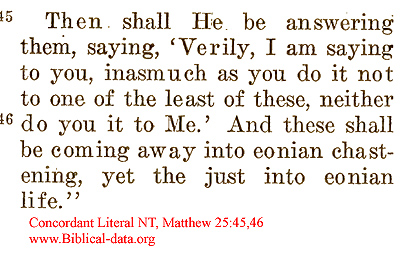
| BOOK, or edition |
Good condition |
FINE condition |
| 1926 Literal NT [no Greek] |
$30.00 |
$45.00 |
| 1926 Concordant Greek text
with commentary [1,542 pages] |
$30.00 |
$60.00 |
| Literal OT (currently published) |
$35.00 |
|
| |
|
|
| early paperback editions of various Biblical books |
$25.00 |
$45.00 + |
|
BINDING |
NUMBER of PAGES |
PAGE SIZE |
PAPER INFO |
| hard cover,
glue bound |
592
pages NT text + 368 pages of
Concordance and explanatory
matter |
138 mm x 190 mm. sufficient margins | bright white, Single column. Cleanly printed. page thickness .004", text in paragraph format. Slight ghosting |

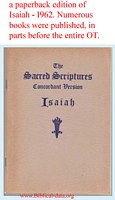
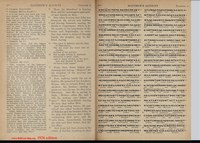
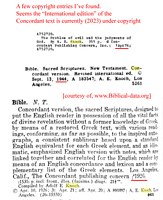
BASE text - - - - - - - - - -
- - - - - -modified KJV
Accuracy of translation - - -
- - NA
Value to Christian faith - - -
- - - 4
Value as a collectible book -
- - 7
| BOOK, or edition |
Good condition |
FINE condition |
| 1928 edition |
$30.00 |
$45.00 |
| |
|
|
| |
|
|
| |
|
|
|
BINDING |
NUMBER of PAGES |
PAGE SIZE |
PAPER INFO |
| hard cover, smyth-sewn. Alfred A. Knopf publisher. End page contains font (type) data! |
424, plus a single page preface, end page contains font and paper data. |
155
mm x 228 mm.
nice
wide
margins, two column format. Verse numbering (see above), paragraph
format. |
.0052", hence
no ghosting! Volume had uncut fore-edge, top edge tipped in blue/black.
Printed in Scotch type, Paper manufactured by S. D. Warren Co., Boston. |

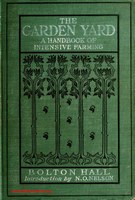
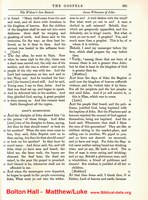
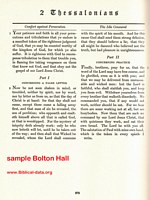
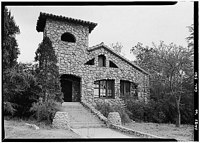
The
Authentic Literature of Israel (2 vol.)
Miss Marie Elizabeth Josephine Czarnomska
BASE text - - - - - - - - - -
- - - - - -modified KJV
Accuracy of translation - - -
- - 7
Value to Christian faith - - -
- - - 4
Value as a collectible book -
- - 7
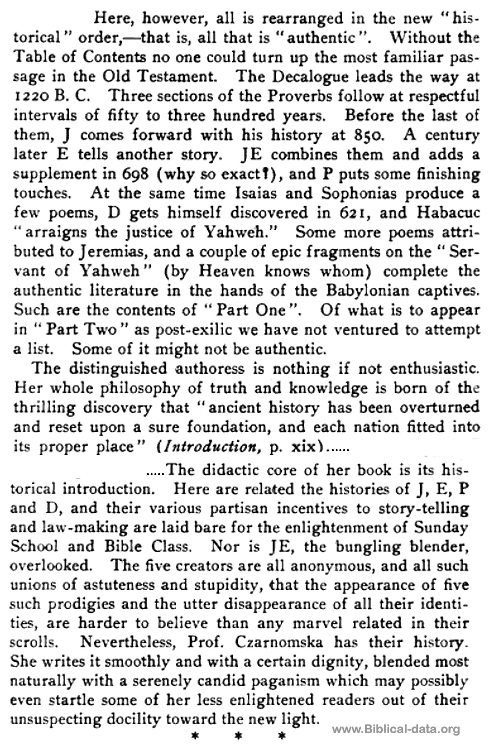
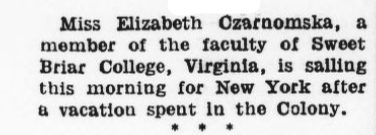
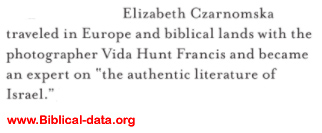

Photographer Vida Hunt Frances (1870 – 1957) was a native of Philadelphia, Pennsylvania, who graduated in 1892 from Smith College. She studied photography and platinum printing with Charles Pancoast and John C. Bullock. Frances photographed throughout Europe, the Middle East, and the United States, and was commissioned by G. Putnam's Sons to make photographic illustrations for The Cathedrals and Cloisters of France, an eight-volume work by Elise Whitlock Rose published from 1906 to 1914.
| BOOK, or edition |
Good condition |
FINE condition |
| 1924-28 "Authentic Literature..." 2
vol. |
$35.00 for both |
$45.00 for both |
| single volume |
$25.00 |
$30.00 |
| |
|
|
| |
|
|
|
BINDING |
NUMBER of PAGES |
PAGE SIZE |
PAPER INFO |
| hard cover,
smith-sewn |
vol. i, 422
pages; vol, 2, 552 pages. Both
volumes have maps |
155 mm x
232 mm.
sufficient
margins.
Single column
format. |
off-white, Cleanly printed. page thickness .0056", text in paragraph format. No ghosting |
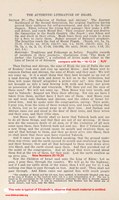
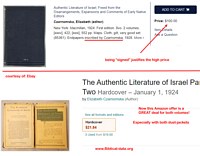
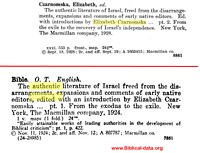
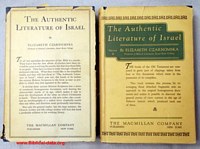
BASE text - - - - - - - - - -
- - - - - -codex 01, and apparently Westcott and Hort's
Greek text
Accuracy of translation - - -
- - 4
Value to Christian faith- - -
- - - 3
Value as a collectible book- -
- 10 (original edition of 1927, 28, very rare)
The Christian's Bible - New Testament. The New Testament of our Lord and Saviour Jesus, the Christ. A Translation from the Greek, Chiefly of the Codex Sinaiticus and Codex Vaticanus; These Being the Oldest and Most Complete MSS. of the New Testament.
It is not simply a translation of words, but under the guidance of the Holy Ghost, His Thoughts, as recorded in Greek by His specially inspired writes, are made known to us. By a Servant of Christ.
"but knowing that a man is not justified in consequence of works of the law, but only through belief of Christ Jesus, we also believed into Christ Jesus, in order that we may be justified in consequence of belief of Christ, and not in consequence of works of the law, because in consequence of works of the law no human shall be justified."A bit cumbersome!
"if you are trained in spirit, you are not under law."
As concerns baptism, at Mark 7:4, LeFevre suggest that folks coming from a market-place need to be "immersed" before they eat. In the upper room at the last supper, when in Luke 22:19, we read that the upper room was awaiting them, no baptismal font is mentioned, which according to LeFevre should be present which was needed to "wash" the disciples who brought any of the food. Nor does Jesus indicate that He or any of them were first baptized before eating!
43 Now when the foul spirit has gone out of a man †[who has resolved to reform], it roams about through barren places seeking a resting-place and finds it not. 44 Then he saith: I will return to my house from whence I came; and coming he finds it unoccupied †[by a holy spirit], but swept [of immorality] and garnished †[with beautiful mottoes and even Scripture texts].Of course, I cannot recommend this text to anyone. The 1929 edition is rare, that is its only value.
(his footnote reveals that he added these words, because the reader needed to be reminded that they concern an unregenerated man)
| BOOK, or
edition |
Good condition |
FINE condition |
| 1929 (a few dated 1928) |
$75.00 |
$105.00 |
| |
|
|
| |
|
|
| |
|
|
|
BINDING |
NUMBER of PAGES |
PAGE SIZE |
PAPER INFO |
| hard cover,
smith-sewn |
unpaged 352
pages; |
225 mm x
150 mm.
sufficient
margins. Two
column format. |
text in paragraph format. No apparent ghosting |

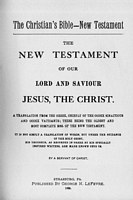
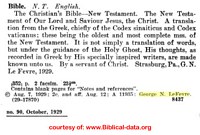
BASE text - - - - - - - - - -
- - - - - -several Syriac manuscripts, and a printed
Syriac NT
Accuracy of translation - - -
- - 6
Value to Christian faith- - -
- - - 4
Value as a collectible book- -
- 6 (original edition of 1933)
THE HOLY BIBLE As translated by Dr. George M. Lamsa is a translation from the Peshitta, twenty-five years were required to complete this translation. The Four Gospels were completed first and published in 1933, followed by the New Testament in 1940 and finally the entire Bible in 1957.
Lamsa strays still further from biblical Christianity by denying that Jesus Christ ever physically rose from the dead. While he claims that Christ rose with a “spiritual body,” Lamsa compares Jesus’ life to a mere glass of water and His death to its evaporation into the air and ocean, depreciating His ongoing personal existence and significance.
Lamsa spiritualizes the Ascension as well as the Resurrection: “The ascension of Jesus was a spiritual transformation. Jesus rose up from death and was taken up into the heavenly realm in a spiritual body, freed from all physical limitation [i.e., nonphysical]. He was seen alive and ascending to heaven only by those whose spiritual vision had been strengthened by faith in him.”
Lamsa
likewise stresses that the Second Coming is not a physical
event, but a “spiritual” coming that will transpire in the
world’s consciousness: “The second coming of Jesus will be a
spiritual coming, that is, he will come in a spiritual body,
free from all physical limitations. Moreover, the people’s
consciousness will be raised to a spiritual level, so that
every eye will see nothing but good. In other words, it will
be a spiritual life and spiritual kingdom.” Lamsa typically
focuses on the disciples’ experience rather than
on Christ’s personal actions after Calvary.
Lamsa attempts to unite world religions in part by eliminating the uniqueness of Jesus and His atoning sacrifice on the cross. He follows the lead of the metaphysical (or “mind science”) cults by redefining sin as mere error or (at worst) evil, not as moral disobedience to the Creator which deserves punishment from Him. Salvation in Lamsa’s view is simply knowing Truth and “understanding the good” — a view which reduces Jesus from the essential suffering Savior to the dispensable model man. Christ died, Lamsa says in his notes on John 3:16, to show us meekness and the existence of life hereafter, not to atone for our sins. He thus contradicts the central theme of the whole Bible.
| BOOK, or
edition |
Good condition |
FINE condition |
| 1933 |
$35.00 |
$55.00 |
| 1939, 1940, 1957 reprints |
$15.00 |
$20.00 |
| 1968 softcover |
$10.00 |
$15.00 |
| |
|
|
|
BINDING |
NUMBER of PAGES |
PAGE SIZE |
PAPER INFO |
| hard cover,
smith-sewn |
1243 pages;
plus a preface of about 20
pages. Unlike 1940 edition
1957 edition has no maps. |
212 mm x
136 mm.
margins a bit
narrow. Two
column format. |
text is in
verse format. A few footnotes are
seen. Minimal ghosting. paper
slightly off-white. .0036"
thick |
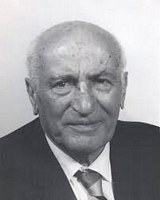
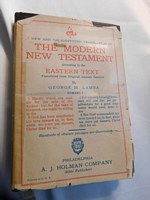
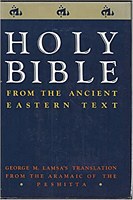
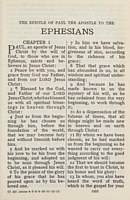
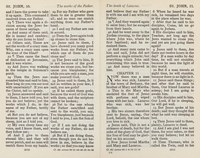
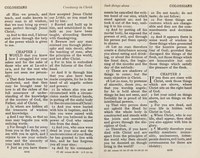

BASE text - - - - - - - - - -
- - - - - Westcott and Hort (including their readings in the margins)
Accuracy of translation - - -
- -5
Value to Christian faith - - -
- - 6
Value as a collectible book -
- 9
| BOOK, or
edition |
Good condition |
FINE condition |
| 1934 |
$65.00 |
$95.00 |
| 1934 (without forward) |
$50.00 |
$80.00 |
| |
||
| |
|
|
|
BINDING |
NUMBER of PAGES |
PAGE SIZE |
PAPER INFO |
| hard cover,
smith-sewn |
560 pages, plus 14 pages front matter. Closes with two pages showing pronunciation of names. |
120 mm x
181 mm.
margins sufficient. single column. Verse numbers in text. |
A few
footnotes are
seen. No ghosting.
paper
slightly off-white.
.0033"
thick. Cleanly printed.
Has no maps, but has lengthy "essays" on "resurrection", "miracles" et
al. |
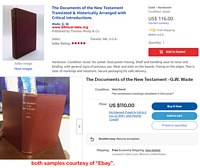
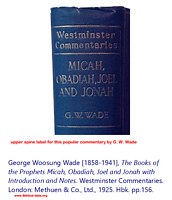
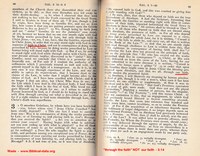
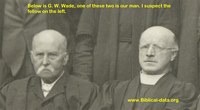
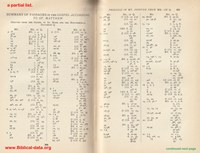
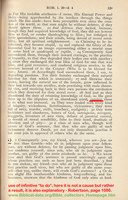
BASE text - - - - - - - - - -
- - - - - Westcott and Hort
Accuracy of translation - - -
- -5
Value to Christian faith - - -
- - 4
Value as a collectible book -
- 4 (7 for the 1923 NT)
"Monkeying with the Bible”: Edgar J. Goodspeed's
American Translation
R. Bryan Bademan - 2006
Sacred Heart University
quote from page 77
In a speech titled “Why Translate the Bible?” given to eager, mostly Protestant
audiences across the country, the Chicago professor argued
that “the great danger in democracy is vulgarity; in art, in literature,
in drama, in speech, in social customs, even in religion.” Goodspeed
almost defensively insisted that he was no cultural leveler, no friend of
“Bolshevism.” What protected a democracy was cultural achievement,
or “Humanism,” “the sense of taste, restraint, good will, elevation,
poise, fairness, understanding, socialibility [sic].”
In his view, the Bible and religious language, in order to have any beneficial cultural
influence, must become part of the best of the cultural vernacular as it
is. And such a state of affairs could only be achieved when the best of
science, in this case contemporary biblical criticism, was applied to
the Bible. Only in this way could the Bible’s message be truly decipherable
and thus applicable to human circumstances.
Conservatives, too, had culture’s preservation in mind. But they
believed that American culture needed religion and religious language
to perform its work from without. The magnificence and otherworldliness
of the KJV, in their view, stabilized a culture that might
suffer from internal collapse. The 1920s, after all, brought the “Red
Scare,” a severely restricted policy on immigration, the era of the prohibition
amendment, and violent race riots in the American heartland.
Critics who attacked Goodspeed’s project for its affinities with
slang, the vaudeville stage, commercialism, jazz, populist religion, and
the prize ring were articulating deep cultural insecurities. Religion,
for them, was a force that acted upon culture, not a current within it.
—end
quote—
Typical
of most modern versions are the frequent "revisions".
Goodspeed provided at least 3 revisions (editions).
Below are comparisons of 2 of them:
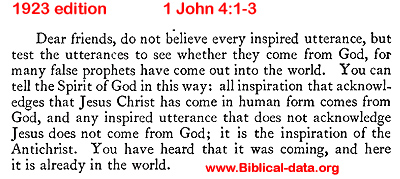
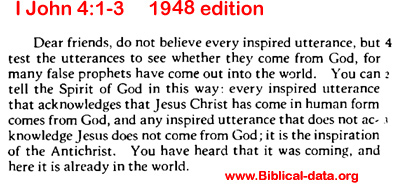
| BOOK, or
edition |
Good condition |
FINE condition |
| 1923 NT |
$75.00 |
$100.00 |
| 1927 whole Bible |
$55.00 |
$75.00 |
| 1935 |
$15.00 |
$20.00 |
| later reprints |
binding dictates |
|
|
BINDING |
NUMBER of PAGES |
PAGE SIZE |
PAPER INFO |
| hard cover,
smith-sewn |
4 page
preface, 883 pages OT;
2 page NT preface, 246
pages NT |
128 mm x
190 mm.
narrow
margins. Two
column format.
verse #'s on
margin. |
text in paragraph
format. Poetry
in verse
format. slight
ghosting.
Paper bright
white. paper
.0028". Type
is clear and
uniformly
printed. |
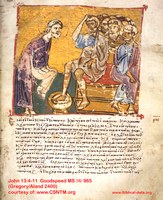
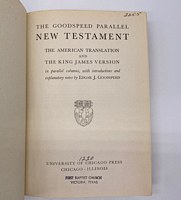
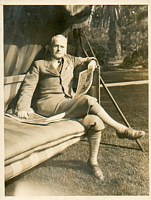
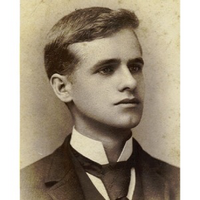
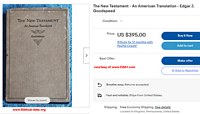
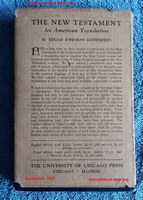
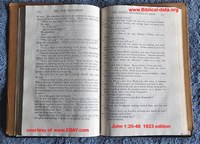
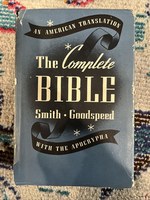
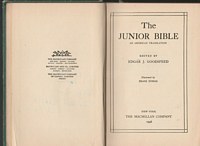
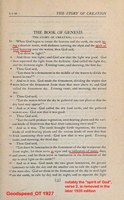
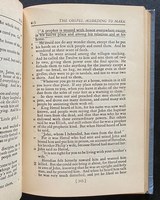
BASE text - - - - - - - - - -
- - - - - Westcott and Hort for NT, Latin Vulgate for OT
Accuracy of translation - - -
- -7
Value to Christian faith - - - - - 7
Value as a collectible book -
- 6
| Volume I | Part 1 | St. Matthew | by Joseph Dean | 1928 |
| Volume I | Part 2 | St. Mark | by Joseph Dean | 1916 |
| Volume I | Part 3 | St. Luke | by Joseph Dean | 1935 |
| Volume II | Part 1 | St. John | by W.S. Reilly | 1929 |
| Volume II | Part 2 | Acts | by Cuthbert Lattey | 1933 |
| Volume III | Part 1 | I and II Thessalonians | by Cuthbert Lattey | 1913 |
| Volume III | Part 2 | I Corinthians | by Cuthbert Lattey | 1914 |
| Volume III | Part 3 | II Corinthians | by Cuthbert Lattey and Joseph Keating | 1920 |
| Volume III | Part 4 | Galatians, Romans | by Alexander Keough (Galatians) and Cuthbert Lattey (Romans) | 1920 |
| Volume III | Part 5 | Ephesians, Colossians, Philippians, Philemon | by Joseph Richaby (Eph and Col) and Alban Goddier (Phil and Philemon) | 1914 |
| Volume IV | Part 1 | Hebrews | by Patrick Boylan | 1924 |
| Volume IV | Part 2 | I, II Timothy, Titus, I,II,III John, James, I, II Peter, Jude | by Francis Gigot (I, II Tim, Tit. I,II,III John) and W.H. Kent (Jas., I,II Pet, Jude) | 1924 |
| Volume IV | Part 3 | Apocalypse of St. John | by Francis Gigot | 1915 |
THE BOOK'S CHARACTERISTICS
Table copyrighted © 2023 Mr. Gary S. Dykes, format and contents.
Publication Date 1958
Publisher [of volume examined]
Hawthorn Books, New York (actual printing done in Holland), also published in England
Cover hardcover, white leather-like over stiff boards
Editors' religious affiliation
Catholic
Page Size 10.25 inches height
7.25 inches width
2.30 inches book thicknessBinding smyth-sewn in signatures of 32 pages each
First and last signatures, side stitched no
Number of pages, and number of volumes
980, 458 + 19 preface, one volume (about 1,458 pages total)
Paper thickness and suppleness
.0032", illustrations on thicker stock. text pages nicely supple
Paper color, UV reaction, acidity
off-white, color illustrations on glossy stock. Not UV reactive, no acidity statement. Paper largely wood pulp origin.
Text block orientation, margins and page appearance
text block - 8.25 x 6.25 ", two column format
each column is 3.0", with a center margin of .25". right side margin 3/8" gutter margin 5/8". nice even gray page appearance throughout
Text style (paragraph, or verse by verse et al)
Text justified, paragraph style, verse numbers in-text. Poetry is laid out in poetical form (i.e. not justified)
Font(s) characteristics
Main text is a serif cross between Caslon and Garamond, (note ball shaped finial on the lower case "a"), leading is tight but appropriate, decorated initials for each book's first verse. Font size 12 point, (larger than most large prints). Headers are in an italic type.
Pages consistent inking (too dark or too light)
nice consistent gray. All pages cleanly printed
Location of verse numbers
in text
Thumb-Index Tabs no
Headings yes, in an italic font
Christ's words in red no Ribbon Markers one, 3/4" wide white
Gold Gilding w/ Rounded Corners yes, rounded corners, ample gold gilding!
Cross References no, some few indicated in the footnotes.
Helps, and unusual features
Following the OT are pages for family records. Following Revelation, is extensive material on Catholic Bibles and Rheims/Douay history. Scattered throughout are good color reproductions from the masters. Chronologies of both Testaments. A list of references (concordance). At end are: Indulgences, the Rosary, table of movable feasts, the Bible in art, Holy days of obligations, A commentary on the color plates (which are scattered throughout). The seven sacraments, color maps. The Offertory, with images. The Communion, with images. Just before the table of contents, is a pasted-in color photo of Pope Pius XII. Footnotes yes, adding insights, corrections and references, below each column. Some notes biased (s.v. Matthew 12:48's footnote)
Concordance yes, termed "Table of References", 45 pages two column
Maps yes, 7 on thicker stock, in color. Not highly detailed.
Name(s) of the Father God, Lord (Genesis 7:1 et al), Father (Isaiah 63:16)
Name(s) of the Son Jesus, Lord, Jesus Christ, Messiah + many other titles
Hebrew Transliterations All Names, and titles (spelling follows the Rheims/Douay and the Westminster text) Dates are A.D., B.C. format. Book/Canon Order Old Testament Order
Torah
Historical Books, then Tobit, Judith
Writings including: Wisdom, Ecclesiasticus, then Isaiah, Jeremiah, then Lamentations, Baruch
the remaining Prophets, then I and II Maccabees
New Testament Order
Gospels - Mt, Mk, Lk, Jn
Acts
Pauline Epistles (Thessalonians follows Acts, then Corinthians, Galatians, Romans, Ephesians, Colossians, Philemon, Philippians, Hebrews, I and II Timothy, Titus).
General Epistles
RevelationBase/source Text(s) For OT, Rheims/Douay from the Latin Vulgate. The NT and Psalms the Westminster Version, the NT was rendered from the Westcott/Hort Greek text. Psalms from the Masoretic text.
Digital file(s) available
yes, www.archive.org — but not the 1958 edition (yet)
Family data pages (marriages, deaths et al)
yes, between testaments: Marriages, Births, First Communions, Confirmations, Deaths—all on thicker stock
Cuthbert Lattey S.J. (1872-1956) was a British Catholic priest, biblical scholar, and author. He was born in Liverpool, England, and studied at Heythrop College, University of London, where he was ordained a priest in 1896. He was a prolific writer, and his works—besides the Westminster Version—on the Bible include this sampling: The Bible: Its History, Transmission, and Inspiration (1903), The Gospel of St. Mark (1920), and The Epistle to the Hebrews (1926) et cetera. He was also a founding member of the Catholic Biblical Association of Great Britain, and he served as its president from 1940 to 1942.
Lattey was a leading figure in the Catholic biblical movement in the early 20th century, and his work helped to promote a more scholarly and critical approach to the study of the Bible among Catholics. He was also a strong advocate for the use of the vernacular in Catholic worship, and he helped to prepare the first Catholic version of the Bible in English direct from the original Hebrew and Greek, known as the Westminster Version.
Lattey was a controversial figure in his own time, and his work was sometimes criticized by more traditional Catholics. However, he is now widely acknowledged as one of the most important figures in the history of Catholic biblical scholarship. In addition to his work on the Bible, Lattey also wrote on a variety of other topics, including Catholic social teaching, mysticism, and the history of the Catholic Church. He was a popular speaker and lecturer, and he was also a regular contributor to Catholic magazines and journals.
Lattey
died
in 1956 at the age of 84. He is buried in the Jesuit cemetery at
Heythrop College.
END AI
(Heythrop College had an early relationship with the
Jesuits). [the above AI reply needs correcting on one point: the
first attempt to render the NT from the original Greek and Hebrew was
done in 1836 by Dr. John Lingard, AND beginning in 1898 Rev. Francis A.
Spencer issued his The Four Gospels...].
As
shown in the topmost chart, Lattey was joined by a number of other Catholic
scholars. For example the Gospel of John was edited by the Rev. W. S.
Reilly, S.S., Doct. S. Script. Professor of Sacred Scripture, St. Mary's
Seminary, Baltimore. With such a distinguished ensemble one would
expect a fine effort and this version does not disappoint. The editors
of the NT portion followed the West/Hort Greek text, however they also
utilize other readings when warranted.
The
following research is based upon the 1958 edition. [But keep in mind
that the primary texts of the NT suffered very little alteration when
the early fascicles, the four volume set, and the single volume editions
are compared]. In the 1958 edition the original notes are jettisoned
and replaced by a few notes by Father Robert Dyson, S.J. Professor of
Exegesis in the Pontifical Biblical Institute, Rome.The notes for the NT
were created by Rev. Richard Foster, Professor Of Biblical Studies,
Oscott College Birmingham, England. The original notes were much more
valuable, and it is a shame that they were replaced by these feeble
attempts. Hence, the four volume hard cover set (shown in the uppermost
chart, vols. I - IV) which edition contained all of the earlier
fascicles, with the prior notes slightly edited) is preferred.
However,the texts
comprising the NT suffered very little editing yet a reader will note a
small number of changes: below are a few of these changes (between the
fascicles and four volume set versus the 1958 edition):
| early editions |
1958 edition |
| I Thes. 3:5 refrained |
held out |
| I Thes. 3:9 offer |
render |
| I Thes. 4:3 fornication |
impurity |
| II Thes. 2:3 [that day cannot come] |
...... (not in text) |
| II Thes. 2:7 restraineth |
keepeth |
| II Thes. 2:12 acquiesced |
resolved |
| John 1:15 was before me |
existed before me |
| Mark 4:39 arose |
awoke |
| Mark 5:41 signifieth |
translated |
| I Cor. 11:10 sign of submission over her head |
hold command over her head |
The W/H text omits the "Woman Caught in Adultery" portion. Thankfully all editions of the Westminster Version retain it.
Over all the Westminster Version, (WV) follows Westcott and Hort (W/H) fairly close, note the following samples.
Acts 12:25 W/H reads "...from Jerusalem" the WV reads ""...to Jerusalem" [important for those studying the chronology of Acts]
John 2:17, WV reads "...shall eat me up" a correct future tense as per W/H
both omit: Acts 8:37, Acts 9:5,6 Acts 7:57 (part), neither text has "Thomas" in John 20:29.
In John 17:20 both present a present tense "...those who believe", other texts have a future tense
Contrary to WH, our version includes Matthew 17:21
Contrary to WH, our version includes Matthew 18:11
At Matthew 20:16 both texts omit "...many are called, but few are chosen" (which omission accords to mss 01 and 03)
At Matthew 28:2 both omit "...from the door"
At John 3:15 both omit "...should not perish".
the conclusion....WH is closely followed, but the Westminster editors exercise some freedom, hence eclectic.
Often the 1958's renditions are stiff, as the editors were a very, very literal, for example note:
Mark 5:38
"And they come to the president's house..."
Here "come" is a present tense in the underlying Greek, but most English translations present the narrative as - "And they came
to the house of the synagogue official...". Viewing it as an act in the
past, which provides for a smooth narrative. If a student wants a nice
smooth text, then this is not their cup of tea, it is overtly literal.
As for me, I like the literal accuracy, it is impressive!
In closing we may quote from an article "The Truth of Scripture" by Lattey:
...an example of God speaking “in many portions”–that is to say, revealing often only a part of the truth, for which the Jews were more ready. In the Book of Malachi it is prophesied that the Old Testament sacrifices are to be rejected by God: “For, from the rising of the sun, even unto the going down, my name is great among the Gentiles, and in every place there is sacrifice, and there is offered to my name a clean oblation” (Mal. 1:11).
The
objection has been raised that the prophet did not foresee the
sacrifice of the Mass. That may well be true, though it cannot be
proved; but even if it is true, it is no less true that the above
lines contain a true prophecy, which is found to be fulfilled only in
the Mass. Almighty God, for his own good reasons, revealed only a
part of the truth, but this should have been enough to prevent
Protestants from saying that the Mass is contrary to Holy Scripture.
Indeed, they cannot give a satisfactory explanation of the lines.
The
above quote references Malachi 1:10,11: In which the Catholic editor
(Lattey) tries to relate the rejection of Israel's offerings and His
acceptance of the Gentile's (non-Jews i.e. "Catholics") offerings as
equaling the Mass. He overlooks Malachi 3:3, 4. There is no such thing
as a "mass" in scripture. The John six, (i.e. eating His body (bread)
and drinking His blood (wine) is not a physical reality. Is is a spiritual ingestion, as John 6:63 makes clear:
"It is the Spirit Who gives life; the flesh profits nothing; the words that I have spoken to you
are spirit and are life." [flesh = physical bread and wine]
Perhaps this is why so many Catholic priests drink so much of their free wine!
Note: I have seen a rare 2 volume hardcover set, but cannot find any information on it. See thumbnail.
| BOOK, or
edition |
Good condition |
FINE condition |
| 1913 - 1935 fascicle (any one of) |
$25.00 |
$35.00 |
| all 11 fascicles |
$200.00 |
$275.00 |
| 1935 four vol. set |
$115.00 |
$150.00 |
| any one of the 4 vol. |
$30.00 |
$40.00 |
| 1948 single volume |
$75.00 |
$150.00 |
| 1958 |
$60.00 |
$120.00 |
| two volume leather set |
$100.00 |
$150.00 |
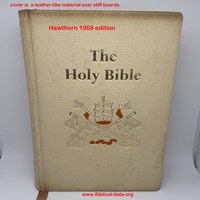
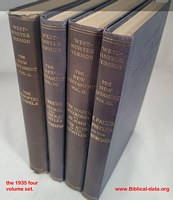
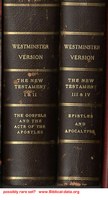
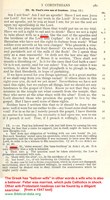

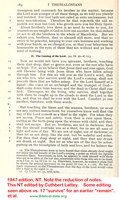
BASE text - - - - - - - - - -
- - - - - Johannes's wife's brain
Accuracy of translation - - -
- -3
Value to Christian faith - - -
- - 0
Value as a collectible book -
- 4
| Greber's text |
ASV text |
| Therefore, as the sin of apostasy from God came into God's creation through a single individual, and in consequence of this apostasy the spiritual death of separation from God likewise stepped in, so this spiritual death also affected all mankind; for they had all fallen away from God. It follows that the sin of apostasy was in the world even before the Law of Moses. But we become conscious that something is a sin only if there is a law that forbids it as sin. Thus the Prince of Death reigned from the time of Adam to that of Moses over all who had committed the same sin of apostasy that Adam had committed. This Prince of Death is thus the antitype of the Prince who was to come later. |
Therefore, as through one man sin entered
into the world, and death through sin; and so death passed unto all men,
for that all sinned:— 13 for until the law sin was in the world; but
sin is not imputed where there is no law. 14 Nevertheless death reigned
from Adam until Moses, even over them that had not sinned after
the likeness of Adam's transgression, who is a figure of [H]sic him that
was to come. |
| BOOK, or
edition |
Good condition | FINE condition |
| 1937 |
$10.00 |
$15.00 |
|
BINDING |
NUMBER of PAGES |
PAGE SIZE |
PAPER INFO |
| hard cover,
smith-sewn. Has a dust jacket. |
463 pages; which includes an 11 page introduction. no maps. No ribbon. |
215 mm x
150mm.
margins nice and wide. Single column format. |
text is in paragraph format. No footnotes are
seen. Minimal ghosting. paper
slightly off-white. .0027"
thick. Verse numbers in margin. Smooth sizing. Not UV reactive. |
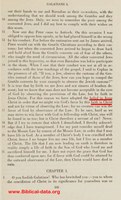
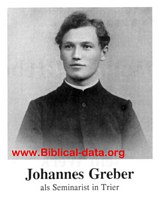
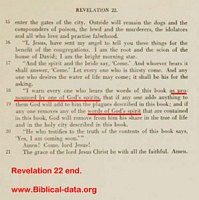
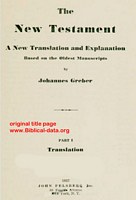
BASE text - - - - - - - - - -
- - - - - eclectic critical Greek texts, and Latin Vulgate
Accuracy of translation - - -
- -7
Value to Christian faith - - -
- - 5
Value as a collectible book -
- 7
| NASB's reading [1971] |
SPENCER's reading |
| Mt. 1:25 "first born" |
omits |
| Lk 1:42 "said" |
"chanted" |
| Mt. 26:30 "sung a hymn" |
"sung the psalms" [would take some time!] |
| Mt. 16:19 "shall"....shall have been" |
"shalt.....shall" |
| Jn. 2:4 "Woman" |
"Woman" - but see his footnote |
| Mt. 13:55, 56 "brothers....sisters" |
"kinsmen...kinswomen" - see his footnote |
| Mt. 23:9 "father" |
"Rabbi" |
| I Cor. 9:5 "believing wife" |
"Christian woman" |
| Mk. 1:30 "Simon's mother-in-law" |
"Simon's mother-in-law" [hence Peter was married!] |
| Gal. 1:12 "a revelation" [one of many] |
"the revelation" |
| BOOK, or
edition |
Good condition | FINE condition |
| 1937 |
$30.00 |
$45.00 |
| later reprints | $20.00 | $25.00 |
|
BINDING |
NUMBER of PAGES |
PAGE SIZE |
PAPER INFO |
| hardcover,
smith-sewn. covers are green (1946) |
719 pages; plus an 8 page preface, and a 3 page intro.. Includes two B/W maps. |
195 mm x 130mm.
margins nice and wide. Single column format. |
text is in paragraph format with headings. Has footnotes. Minimal ghosting. paper
slightly off-white. .0031"
thick. Verse numbers in margin. No sizing detected. Not UV reactive. |
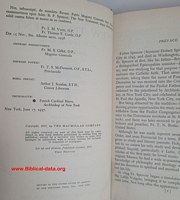
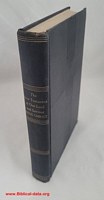
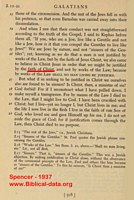
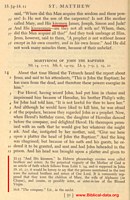
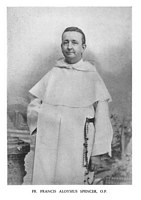
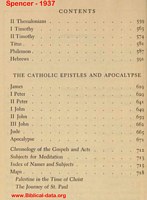
The
New
Testament: A Translation in the Language
of the People.
Charles B. Williams 1937
BASE text - - - - - - - - - - - - - - - Westcott and Hort, also codex 03
Accuracy of translation - - - - - paraphrase
Value to Christian faith - - - - - 2
Value as a collectible book -
- 7 for the 1937 edition
Affiliation - -- - - - - - - -
- - - - - -Baptist
Publisher - - - - - - - - - - - - - - - -Moody Press, Chicago
The
New Testament: A Translation in the Language of the
People. Charles B. Williams. Chicago: Moody Press.
Edition examined is dated 1952. Original copyright is
1937. This 1952 edition is a reprint with the Publishers’
Preface (two pages), followed by a slightly revised
Forward (Hills #2493) also of two pages, next appears a
two page Introduction signed by: Edward A. McDowell, J. R.
Mantey and John Mostert. Next is a one page Table of
Contents, followed by a single page of Key to Footnotes.
Text of New Testament, pages 11 - 575. Each book has a
short introduction, (see sample image) each chapter has a
brief heading. Text is single column format, verse numbers
in text. At foot of each page are the notes via Williams.
Spine is 20.25 cm.. Text on spine reads: The New
Testament: Williams: Moody Press, with a Moody Press
logo. Book is a hardcover, dark brick red in color. Paper
is nice and supple, not a bright white, good on the eyes.
Much of the book does not lie open, is a bit pudgy.
Signatures are smyth sewn, volume is sturdy. Thanks to the
efforts of his surviving daughter, the book is still
currently in print.
Charles
Bray Williams (1860-1952) a Southern Baptist, earned a PhD
in Greek from the University of Chicago. It would have
been nice if he had a degree in English as well, for his
English is atrocious. He states in his preface that he
spent 20 years on this translation.
In a 1956 edition, published by Moody, the title page read: The New Testament: A Private Translation in the Language of the People. William's text is also seen in The Four Translation New Testament, a parallel edition, (sans the footnotes) published in 1966, by Iverson Associates, for Decision Magazine, by World Wide Publications.
It has been reported that some other printings of this paraphrase lack most of Williams' footnotes, and this has been verified. According to Hills, Moody Bible Institute acquired the copyright to the work in 1949. The original 1937 publisher was Bruce Humphries, Inc., of Boston. (Hills #2362). The volume was reprinted in 1986, by Holman Bible Publishers. Copyright was renewed in 1965 by Edith S. (Mrs. Charles B.) Williams, and Mrs. Perry Sprawls. Jr. (Charlotte Williams Sprawls), titled: The New Testament; A Translation in the Language of the People.
Editions with the footnotes are of course, the more desirable. The footnotes explain and clarify. For example at Acts 4:12, Williams renders the verse as:
"There is no salvation by anyone else..."
He comments upon the "by" and indicates that he renders or sees it as a preposition denoting the instrument. Most other versions render this preposition here as "in". Perhaps he did so so as to agree with the function of the second occurrence of this preposition, in the verse: "...as our only medium by which to be saved." Jesus Christ is seen as the Agent or the Instrument, most likely BOTH functions apply here. Williams is to be congratulated for bravely advancing the possibility that Jesus may be seen here as the Agent (his instrument); this note reveals some of the talent and ability of Williams. He has potential! But..., Williams will often generate some odd or difficult renderings, for example note this rendering of Romans 3:25,
"For God once publicly offered Him in His death as a sacrifice of reconciliation through faith, to demonstrate His own justice (for in His forbearance God had passed over men's former sins);"
It is probably an error to
render "blood" as "death". The original Greek literally
focuses the readers' attention upon "faith in His blood";
in Williams' rendering the actual object of the faith is
not very clear. The aorist tense "demonstrated"
(proetheto) [Williams' - "once publicly offered"] most
likely is a single occurrence, an act not repeated, thus
Williams adds "once". Yet in hundreds of other occurrences
of the aorist tenses, he does not add a word to signify
the singularity of the action. He did so here so as to
emphasize to the reader this important act. Thus, a degree
of manipulation of the text is evident in William's
translation. This manipulation, sincere as it is, is one
of the primary failures of the (or, any) paraphrase to
give an accurate rendering of the source text(s).
Below are some other textual
observations, many of which he supplies with a footnote - often
stating "not in the best manuscripts". Back in his era, the Majority
Text (and or TR) was not widely appreciated, nor truly understood -
sadly to Williams they were NOT a part of the best manuscripts.
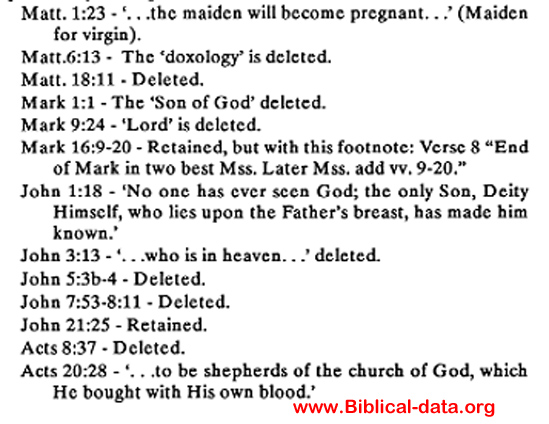
In the upper sample image on the right, (Ephesians) his rendering of Ephesians chapter one, is at best confusing. I cannot image how Dr. Williams, or anyone in their right mind, could state that William's rendition of this chapter is understandable, or an improvement in communication. Herein, we note a sad digression, Williams actually hinders a readers' understanding of the once Holy Writ. Ephesians one, is reckless, wild and should never have been printed! Thus, the theological value of the entire effort is quite low, in my opinion. Perhaps collectors may find value in the book as an object. Finally, in verse one of Ephesians he adds the footnote: "(a) Order of Vat. Ms." a senseless note, as both Westcott and Hort and codex 03, read identical word order(s) "Christ Jesus". Was he using or referencing another Greek text? One wonders!
In
the Forward, Dr. Williams states that "Our translation is
based upon the Westcott and Hort Greek New Testament". He
also states that, in the case wherein variants occur, he
has followed the Vatican (codex 03) manuscript which he
also says is conceded to be the oldest and the best. This
paraphrase contains all of Mark (the long ending), omits
the text of John 8:1-11 (the Woman Caught in Adultery),
omits "in Ephesus"at Ephesians 1:1. Oftentimes quite free
in his paraphrase, as for example at I Corinthians 2:15,
wherein he renders anakrinetai (literally - "thoroughly
evaluates") as "appreciated", which even for a paraphrase
is misleading. The 1937 edition, is of course, worth about
twice the value of this later reprint. This particular
edition (1950-52 reprint) is a nice volume, well made, and
is a good book via which one can possess a copy of this
paraphrase, a paraphrase with some good renderings, most
likely by accident! The first edition was available in a
dust jacket.
A
copy of a 1950 printing is available at: www.archive.org (along with
several other publications by Williams). His commentary upon the Pauline
epistles utilizes the same text as his oft reprinted New Testament.
Though an "expert" with Koine Greek he seems unaware of some of the
notions presented with the various genitive semantics. [note: Romans
3:22 and Galatians 2:16 et al].
| BOOK, or
edition |
Good condition |
FINE condition |
| 1937 |
$35.00 |
$40.00 - $60.00 |
| 1952 and the many later reprints |
$15.00 |
$25.00 |
| |
||
|
BINDING |
NUMBER of PAGES |
PAGE SIZE |
PAPER INFO |
| hard cover
smyth sewn |
575 (not including 10 pages of introductory matter) |
130mm x 195
mm. Single column, verse numbers in text. Has numerous footnotes. Nice margins |
supple, not
bright, no ghosting .0042"
cleanly printed |
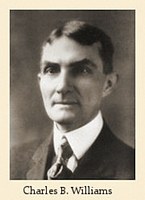
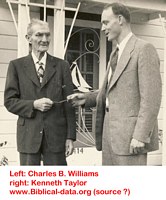
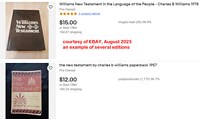

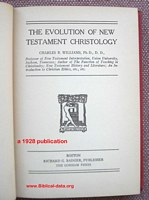
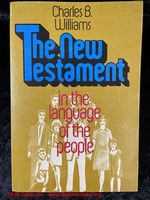
Base Text - - - - - - - - -
- - - - - - Westcott/Hort (WH)
Accuracy of translation - -
- - - 6
Value to Christian faith - -
- - - 4
THE BOOK'S CHARACTERISTICS
Table copyrighted © 2023 Mr. Gary S. Dykes, format and contents. Publication Date
Publisher [of volume examined]
Cover
Editors' affiliation(s)
Page Size Binding
First and last signatures, side stitched
Number of pages, and number of volumes
Paper thickness and suppleness
Paper color, UV reaction, acidity
Text block orientation, margins and page appearance
text block - 8.25 x 6.25 ", two column format
each column is 3.0", with a center margin of .25". right side margin 3/8" gutter margin 5/8". nice even gray page appearance. Easy on the eyes and easy to read.
Text style (paragraph, or verse by verse et al)
Font(s) characteristics
Pages consistent inking (too dark or too light)
Location of verse numbers
in text
Thumb-Index Tabs no
Headings yes, in an italic font
Christ's words in red no Ribbon Markers
Gold Gilding w/ Rounded Corners
Cross References
Helps, and unusual features
Footnotes
Concordance
Maps Name(s) of the Father God, Lord (Gen. 7:1 et al) Father (Isaiah 63:16)
Name(s) of the Son Jesus, Lord, Jesus Christ, Messiah
Hebrew Transliterations
Book/Canon Order Old Testament Order
Torah
Prophets
Writings including: I and II Maccabees, Ecclesiasticus. Baruch, Canticle of Canticles, Tobias
New Testament Order
Gospels/Acts
Pauline Epistles
General Epistles
RevelationBase/source Text(s)
Digital file(s) available
yes, www.archive.org
Family data pages (marriages, deaths et al)
Manuscript Origin
ERV - English Revised
Version 1881
Base Text - - - - - - - - -
- - - - - - Westcott/Hort (WH)
Accuracy of translation - -
- - - 6
Value to Christian faith - -
- - - 4
Value as a collectible book
- - 8 (first British editions)
Affiliation
- - - - - - - - - - - - - - - mostly Reformed
| BOOK, or edition |
Good condition $$ |
FINE condition $$ |
|
BINDING |
NUMBER of PAGES |
PAGE SIZE |
PAPER INFO |
| hard cover | issued in 5
vol.. For example; Paul - 360
pages, Mark 138, etc.. |
160 mm
spine x ? |
N/A |

ERV - English Revised
Version 1881
Base Text - - - -
- - - - - - - - - - - Westcott/Hort (WH)
Accuracy of
translation - - - - - 6
Value to
Christian faith - - - - - 4
Value as a collectible book - - 8 (first British editions)
Affiliation - - - - - - - - - - - -
- - - mostly Reformed
| BOOK, or edition |
Good condition $$ |
FINE condition $$ |
|
BINDING |
NUMBER of PAGES |
PAGE SIZE |
PAPER INFO |
| hard cover | issued in 5
vol.. For example; Paul - 360
pages, Mark 138, etc.. |
160 mm
spine x ? |
N/A |

ERV - English Revised Version
1881
Base Text - - - - - - - - - - - -
- - - Westcott/Hort (WH)
Accuracy of translation - - - - -
6
Value to Christian faith - - - - -
4
Value as a collectible book - - 8 (first British editions)
Affiliation
- - - - - - - - - - - - - - - mostly Reformed
| BOOK, or edition |
Good condition $$ |
FINE condition $$ |
|
BINDING |
NUMBER of PAGES |
PAGE SIZE |
PAPER INFO |
| hard cover | issued in 5
vol.. For example; Paul - 360
pages, Mark 138, etc.. |
160 mm
spine x ? |
N/A |

The
New Testament in the Original Greek: Byzantine
Textform 2005
BASE text - - - - - - - - - - - - - - - - Majority of Greek MSS
Accuracy of translation - - - - - NA
Value to Christian
faith - - - - - 7
Value as a collectible book - - 8
Affiliation - - - - - - - - - - - - -
- - Southern Baptist
PUBLISHER:
Chilton Book Publishing, Southborough, Massachusetts
ORDERING INFORMATION:
Chilton Book Publishing
P.O. Box 606
Southborough, MA 01772-0606
DATE REVIEWED: February
2010/2012
ISBN 13: 978-0-7598-0077-9
Cost is an
economical $16-$18 dollars, via Amazon! [but see below] As seen in the
sample image, unlike the earlier editions of
Robinson/Pierpont, this edition is fully accented. It
also shows many of the variations between this edition
and that of the Nestle/Aland text(s), at the bottom of
each page. The preface is completely revised from its earlier state as seen in
the 1991 softcover edition. Since the death in 2003 of
Pierpont, Robinson alone has been responsible for the
later appearing works.
A nice feature is located on the outer margins, wherein a handful of significant inter-textual differences amongst the Byzantine MSS themselves are noted, (no outer marginal readings are seen in the sample image).
As editors, Robinson and Pierpont (RP) did make some decisions as to the displaying of certain minor variants, these are mentioned in their preface. This they did thoroughly; after testing their efforts I have found their decisions typically reflecting the real MAJORITY of Byzantine MSS.. Minor deviations exist as noted below, but they are minor,
For example of a minor deviation, at I Corinthians 1:2, the adverb "all" (pasin) has the final nu indicated in this edition; this does not reflect the proper Attic (and Ionic) rule, (since the word precedes a word beginning with a consonant without intervening punctuation, the final -n is usually omitted) which rule was observed by most Byzantine scribes (though not all). In this case they - RP made a decision which did not also follow the consensus of existing Byzantine MSS here at I Cor. 1:2. The vast majority of Byzantine MSS omit the final nu here, and read "pasi". By not displaying the consensus reading here, an anomaly is manifest in this labor of Pierpont and Robinson. (Note most Egyptian MSS retain it and read "pasin").
As one peruses the
must-read preface, one is struck by the studious avoidance
of the term "majority" or "majority-text" (seen only
once on page i). Instead one is confronted with the
similar - "consensus text". Robinson and the late
Pierpont, arrived at their consensus text via extraction
from H. von Soden's large work from the earlier 20th
century. Von Soden developed a methodology for
recognizing MSS which formed the backbone of his "K"
text-types (the "K" types are reflect a majority or
Byzantine text-type(s)). RP (as well as the Hodges/Farstad
(HF) edition) relied heavily upon von Soden's
classifications. For the Apocalypse, both (i.e. Hodges/Farstad and
Robinson/Pierpont) utilized the work of Hoskier,
Hoskier exhibits a nice thorough view of the variations.
It seems clear that Robinson avoids "Majority" as it
suggests the Hodges/Farstad text.
In
reality, RP relied upon printed editions for their text,
and did not display extensive or even a few collations
via hundreds of manuscripts. (Only the Pericope seen in
John, has been fully examined amongst most manuscripts).
If one were to ask Dr. Robinson which Byzantine
minuscules read "diakonian" instead of "koinonian" at I
Corinthians 1:9?, he would have to run to von Soden or
Swanson to give you an answer, as he himself did not
display the collation base of this text in the
actual manuscripts. Von Soden only reveals 1 witness,
Swanson 2 more. Beyond that Robinson could/can not
answer you. [ As an aside, I can provide more, as I have
examined personally, (via films and photographs) many
many manuscripts, I can thus speak with authority, and
it is this very authority which this edition
lacks!].
It is a derivative work, second-hand in nature. However, upon testing this work, it reveals an amazingly accurate Majority Text. The care which Robinson and Pierpont gave to this effort has paid off, it is also very close to the Hodges/Farstad Majority text as well, exhibiting only minor orthographical variations, rarely do whole words or phrases vary (between the HF work and this RP effort). The advantage of the RP edition, is how quickly the user can observe a few variations between the MT and that of the eclectic Nestle/Aland editions; as well as a few inter-textual variations within the MT itself! Herein the user has a really useful tool, great for translators and investigators, and students who want a very nice readable copy of God's Word!!
As
noted above, the "consensus text" as seen in RP, rests
largely upon the labors of others, and not upon the
collations done by Pierpont nor Robinson - as they did
not do this type of necessary work. Necessary in that it
provides a sure foundation and proof of an actual
majority reading (or a reading which does not reflect the
majority). Again, despite this lack, both the RP and HF
editions are very similar. Their agreements are
remarkable. Their texts are no doubt close to being the
majority text (MT) as seen in the majority of Byzantine
manuscripts throughout the centuries: but they fall
short in being able to actually point to
actual manuscript witnesses to prove their case. A later
edition has been published, which corrects many of the
earlier accentuation errors, but still does not show
evidence for their text.
Nevertheless, despite these orthographic decisions, and despite their lack of demonstration of a word-for-word collation of numerous Greek Byzantine manuscripts, they produced a very commendable effort!! An effort which is easier to use than laboriously trying to extract the data from von Soden and elsewhere, and an effort which should set the stage for future efforts to produce an authoritative text. As Dr. Dan Wallace once stated, the majority text can and should serve as the text against which all other texts and manuscripts should be collated. It is indeed, the standard Greek text of God's Word. (Wallace- first indicated his preference for the MT for collation purposes in, Bibliotheca Sacra, January-March, 1990, pages 122f..).
Following
the NT text, is a 53 page essay by Robinson outlining
reasons why the Byzantine Text-type is superior to the
later Egyptian text-types. This essay is discussed at
-
http://evangelicaltextualcriticism.blogspot.com/search?q=Robinson
This
volume has wide margins, and the text is very sharp, no
pages misprinted. The book is sturdy and nicely
designed. The binding is a bit tight, and the volume can lay open as is
it smyth-sewn. The somewhat thick paper is a bright
white, and can strain the eyes, yet ghosting is minimal.
Again the nice wide margins are a pleasant feature!
Recall that this is the 2005 publication. The book has
no index, no list of acknowledgments, nor a bibliography
of materials/references utilized.
| BOOK, or edition |
Good condition $$ |
FINE condition $$ |
|
BINDING |
NUMBER of PAGES |
PAGE SIZE |
PAPER INFO |
| hard covers, smyth sewn | xxiv plus 586 | 9 1/4 x 6 inches (trimmed) | alkaline paper, .0037 inches thick. Bright white. |
| BOOK, or edition |
Good condition $$ |
FINE condition $$ |
The Revised
Standard Version (RSV) New Testament - First edition of NT
- 1946.
BASE text - - - - - - - - - - - - - - - - Westcott/Hort (basically), BHS - Hebrew
Accuracy of translation - - - - - 7
Value to Christian faith - - - - - 8
Value as a
collectible book - - 6/7 (first edition)
Affiliation - - - - -
- - - - - - - - - - mixed, though largely Reformed
Publisher - - - - - - - - - - - - - - - Thomas Nelson and Sons, plus others
Original title of the 1946 edition: "The New Covenant Commonly Called the New Testament of Our Lord and Savior Jesus Christ. Revised Standard Version". Thomas Nelson & Sons. Norwood Press, J. S. Cushing Co.. Also Berwick & Smith. First printing February 11, 1946. The title page also states: Translated from the Greek: Being the Version Set Forth in A. D. 1611 Revised A. D. 1881 and A. D. 1901: (original print form places the next statement on a lower separate line), Compared with the Most Ancient Authorities and Revised A. D. 1946. First printing has on the copyright page: copyright 1901, by Thomas Nelson & Sons; copyright renewed 1929, by the International Council of Religious Education; copyright 1946, by the International Council of Religious Education. (s.v. Hills #2453).
First edition has 553 pages, with an additional six page preface. Spine is 19 cm.. Words in a gold color on spine are: New Testament: Revised Standard Version: Nelson. Single column text, on slightly off-white paper. Smyth sewn binding in a blue hardcover. Around the edges of the front cover is engraved a fine gold-colored decorative border line. The copyright of the New Testament was renewed in 1973 by Division of Christian Education, National Council of the Churches of Christ in the United States of America.
In 1950 the copyright holder was changed to: Division of
Christian Education of the National Council of the
Churches of Christ in the United States. Copies of the
first edition of 1946, exhibit this change which began in
1950, otherwise the copy is very good, also having 553
pages. With this change in 1950 at least one other press
became involved, it was the Van Rees Press. In 1962, and
again in 1971 the RSV New Testament was revised.
The 2001 English Standard Version, (ESV) is largely the RSV slightly modernized, even retaining some of the original footnotes seen in the 1946 RSV [for example at I Corinthians 9:5].
FROM WIKIPEDIA
[ 1962 printings
Minor modifications to the RSV text were authorized in 1959 and completed for the 1962 printings. At the same time, other publishing companies besides Thomas Nelson were allowed to print it, including Zondervan, Holman, Melton, Oxford, Cokesbury, and the American Bible Society. Some of the changes included (but were not limited to) reverting to the Greek phrase "the husband of one wife" in 1 Timothy 3.2, 12 and Titus 1.6 (in the 1946-52 printing it was paraphrased as "married only once"), quoting the Roman centurion who witnessed Jesus' death as calling him "the Son of God" in Matthew 27.54 and Mark 15.39 (in 1946-52 he was quoted as calling Jesus "a son of God").
1971 Second Edition of the New
Testament
In 1971, the RSV Bible was re-released with the Second Edition of the Translation of the New Testament. Whereas in 1962 the translation panel had merely authorized a handful of changes, in 1971 they gave the New Testament text a thorough editing. This Second Edition incorporated Greek manuscripts not previously available to the RSV translation panel, namely, the Bodmer Papyri, published in 1956-61.
The most obvious changes were the restoration of Mark 16.9-20 (the long ending) and John 7.53-8.11 (in which Jesus forgives an adulteress) to the text (in 1946, they were put in footnotes). Also restored was Luke 22.19b-20, containing the bulk of Jesus' institution of the Lord's Supper. In the 1946-52 text, this had been cut off at the phrase "This is my body", and the rest had only been footnoted, since this verse did not appear in the original Codex Bezae manuscript used by the translation committee. The description of Christ's ascension in Luke 24:51 had the footnote "... and was carried up into heaven" restored to the text. Luke 22.43-44, which had been part of the text in 1946-52, was relegated to the footnote section because of its questionable authenticity; in these verses an angel appears to Jesus in Gethsemane to strengthen and encourage Him before His arrest and crucifixion. Many other verses were rephrased or rewritten for greater clarity and accuracy. Moreover, the footnotes concerning monetary values were no longer expressed in terms of dollars and cents but in terms of how long it took to earn each coin (the denarius was no longer defined as twenty cents but as a day's wage). The book of Revelation, called "The Revelation to John" in the previous editions, was re-titled "The Revelation to John (The Apocalypse)". Some of these changes to the RSV New Testament had already been introduced in the 1965-66 Catholic Edition, and their introduction into the Protestant edition was done to pave the way for the publication of the RSV Common Bible in 1973.]
In the original edition we might also note the addition of "chief" before "cornerstone", in Ephesians 2:20; in I Corinthians 10:17, the original "loaf" (2x) was later altered to "bread (2x).
The translation committees were as follows:
The
New Testament Committee (prior to 1952)
Luther A. Weigle, Yale University, Chairman.
James Moffatt, Union Theological Seminary, Executive
Secretary. (died 1944)
Henry J. Cadbury, Harvard University.
Edgar J. Goodspeed, University of Chicago.
Walter Russell Bowie, Union Theological Seminary.
Frederick C. Grant, Union Theological Seminary.
Millar Burrows, Yale University. (joined 1938)
Clarence T. Craig, Oberlin Graduate School of Theology.
Abdel R. Wentz, Lutheran Theological Seminary, Gettysburg.
The Old Testament
Committee (prior to 1952)
Luther A. Weigle, Yale University, Chairman.
Fleming James, University of the South, Executive
Secretary.
Julius A. Bewer, Union Theological Seminary.
James Moffatt, Union Theological Seminary. (died 1944)
William R. Taylor, University of Toronto.
George Dahl, Yale University.
Willard L. Sperry, Harvard University.
Leroy Waterman, University of Michigan.
Millar Burrows, Yale University. (joined 1938)
Kyle M. Yates, Southern Baptist Theological Seminary.
William F. Albright, Johns Hopkins University.
J. Philip Hyatt, Vanderbilt University.
Herbert G. May, Oberlin Graduate School of Theology.
Harry M. Orlinsky, Jewish Institute of Religion.
Though viciously attacked for its rendering of Isaiah 7:14, the RSV is a reliable English translation of the modern Greek eclectic text of Westcott Hort and Tischendorf, which almost perfectly agrees with the Nestle editions. Again, it is a good reliable representative of the modern eclectic Greek texts, it is not a reflection of the Majority or ancient Greek text of Antioch or Byzantium. It is much more reliable than say any paraphrase or many of the modern Bibles published today.
Suggested prices for used copies:
GOOD CONDITION: 1946, Norwood Press - 15.00
FINE: 35.00
GOOD CONDITION: 1946, Van Rees Press - 10.00
FINE: 30.00
(NOTE: Lacking
publishing records, it is possible that the Van Rees Press
edition may be rarer than the Norwood Press edition; if
so, then the value estimates should be switched.)
| BOOK, or edition |
Good condition $$ |
FINE condition $$ |
 <=""
font="" moz-do-not-send="true" alt="backup"
width="180" border="0" height="33">
<=""
font="" moz-do-not-send="true" alt="backup"
width="180" border="0" height="33">
1946
The New
Testament of Our Lord and Saviour Jesus Christ: A New
Translation. Ronald Arbuthnot Knox.
BASE text - - - - - - - - - - - - - - - - Clementine Latin Vulgate
Accuracy of translation - - - - - 4
Value to Christian faith - - - - - 3
Value as a collectible book - - 6 (Chanticleer edition)
Affiliation -
- - - - - - - - - - - - - - mostly Reformed
Publisher - - - - - - - - - - - - - - - Burns Oates and Washbourne, London. also Sheed and Ward Inc. New York
Sheed & Ward: New York. Printed by the Chanticleer Press of New York. Jacket reads: The New Testament: Illustrated: Translated by Ronald Knox. 502 pages, smyth sewn. Has 30 color illustrations, printed on glossy paper, illustrations are of famous paintings in various museums and galleries. Spine 24 cm.. Hardcover, blue cloth, title in silver color. Text is single column, with notes in the wide margins, verse numbers in text. At beginning of each chapter are woodcut illustrations from the 1493 Malermi Bible.
The first American printing, Sheed & Ward, (not Chanticleer) shows a copyright of 1944 (per Hills #2429). Numerous editions of the Sheed & Ward publication exist since the first American printing in 1944, with the Imprimatur of Archbishop Spellman, but the edition by the Chanticleer Press is most desirable (in my opinion). Copyright was renewed in 1972, by Sheed and Ward.
The Chanticleer Press was founded as a subsidiary of a
London company, it became an independent company in 1952
under the leadership of its Austrian-born American
founder, Paul Steiner (1913-1996). The company excelled as
a re-packager for other publishers, usually incorporating
good quality color reproductions. The Chanticleer Press
produced many coffee table type books, and is famous for
its printings of the Audubon Society's Field Guide Series,
published by Alfred A. Knopf.
The Knox translation claims to be based upon the Latin
Vulgate, but it often departs. For example at Acts 19:20,
it reads Lord, whereas the Vulgate has Dei (God). In the
sample image on the right, in Acts 7, we can observe some
added concepts not seen in any Latin MSS. In verse 4, the
added word "only" has no support. In verse 7, they "left"
Egypt, they did not not "escape" per Knox, again a change
not according to the base text (the Clementine Vulgate).
In verse 9, Knox adds "as a slave", again with utterly no
support. Departures from the Latin Vulgate are also seen
in his Old Testament translations as well (two volumes
1949, single volume 1955).
The New Testament was also privately printed in 1945 and after some five hundred alterations was subsequently authorized by the Hierarchy of England and Wales for public use. In 1945 a final edition was issued in Britain, it can be identified with the reading of "friends" at John 21:5, whereas the earlier 1944 printings read "lads", and at Matthew 1:1 the 1945 British edition reads: "A record of the ancestry from which Jesus Christ...", instead of: "A record of how Jesus Christ...". The Chanticleer edition preserves the 1944 readings.
GOOD CONDITION:
Chanticleer - 35.00. FINE: 60.00
GOOD CONDITION: all pre-1945 - 25.00. FINE: 40.00
Letters to
Young Churches: A Translation of the New Testament
Epistles. J. B. Phillips
BASE text - - - - - - - - - - - - - - - - Greek text behind the 1881 revision, initially, .later followed the Nestle editions.
Accuracy of translation - - - - - paraphrase
Value to Christian faith - - - - - 2
Value as a collectible book - - 5 (first edition)
Affiliation -
- - - - - - - - - - - - - -
Publisher - - - - - - - - - - - - - - - Macmillan Company
Edition examined is the 22nd printing of 1955. Has from pages vii - x, an Introduction by C. S. Lewis, this is followed by a Translator’s Preface to page xv. Text is a true paraphrase, showing expansions and explanations within the text, as indicated by Phillips in his preface. Text begins with Romans, and ends at conclusion of Jude, page 230. Each epistle has a short introduction. Very dark blue hardcover, spine 21.5 cm.. Spine reads: Letters to Young Churches: Phillips: Macmillan. Has a lighter blue dust jacket with a short bio of Rev. Phillips on inside back. Inside front jacket, price printed is $2.75. Inside front cover, a map of the Mediterranean world. Paper is off-white, signatures are smyth sewn, a nice sturdy volume. Text is single column, with section heads, chapter and verse indications, paragraph format.
This work was first published in England in 1947. The gospels were next published in 1953. Acts in 1955, Revelation in 1957. In 1958 the entire New Testament was published. (Hills #2473). The 1958 title was: The New Testament in Modern English. Hills states that all but the complete NT were first printed in England (by Geoffrey Bles), then next in America. Copyright was renewed in 1986, by Vera M. Phillips, titled: The New Testament in Modern English.
By 1957, over 400,000 copies of Letters to Young Churches
had been sold in England. The first printings of 1947
(England), or 1948 (America) are desirable. Note: in the
1955 21st printing, however, Phillips made two
corrections, and justifies his controversial rendering of
I Corinthians 14:22, (contained in a note titled: Preface
to the Twenty-First Printing, xv). In the note Phillips
actually states that Paul made an error, or that a textual
corruption occurred! The note first occurs in the 21st
printing, hence that printing is noteworthy. Images at
right, are of the 22nd printing of 1955. Note the brief
introduction (to James), and the reading of "Christ" at II
Thessalonians 2:2, which is not per the Greek text of the
1881 revision, but rather that of the TR. As most readers
of my reviews know, I am not a fan of paraphrases, but
Phillips' is one of the better ones. Above all, it is easy
to read. Do consult the 4 page PDF file for important
supplementary data.
The popularity of these paraphrases is all the more
remarkable as Phillips did not believe in the doctrine of
Divine Inspiration, indicated in his preface; [refer to
Supplemental PDF file to the right], and hence, to him,
the original text was fallible! (One is left to wonder at
the possible impact World War II had upon him, as he wrote
most of the work in war-time London.). The edition of
Letters to Young Churches, 1947/1948 was later revised in
1957. Thus Phillips' original work is only displayed in
his first edition, (1947 - 1956) making them somewhat
collectible. Suggested values include the dust jacket.
GOOD CONDITION: first printing - 15.00. FINE: 25.00
GOOD CONDITION: all other pre-1958 - 12.00. FINE: 20.00
GOOD CONDITION:
complete NT, 1958 - 15.00. FINE : 25.00
The Westminster
Study Edition of The Holy Bible: Containing the Old and
New Testaments: In the Authorized (King James) Version -
1948
BASE text - - - - -
- - - - - - - - - - - Rabbinic, and King James Version
Accuracy of translation - - - - - per KJV
Value to Christian
faith - - - - - 4
Value as a collectible book - - 3
Affiliation - - - - - - - - - - - - - - - mostly Reformed, some Presbyterian
Publisher - - - - - - - - - - - - - - -Westminster Press
The Westminster
Study Edition of The Holy Bible: Containing the Old and
New Testaments: In the Authorized (King James) Version.
Arranged in Paragraphs and in Verses, Together with
Introductory Articles and Prefaces, Explanatory Footnotes,
a Concordance, and Maps. The Westminster Press,
Philadelphia. Copyright 1948 by W. L. Jenkins.
Initial preface two
pages. Followed by the table of contents and a six pages
article "God Has Spoken", next a six page article, "The
History of the Bible". Main body and articles begin on
page 3 and continue to page 1376. An intertestmental
article "Between the Times", (eight pages) precedes the
New Testament, which is numbered 3 - 486. The NT text is
followed by a 103 page concordance, and lastly a colored
atlas of 16 plates with an index. Volume is hardcover,
blue-denim colored. Spine is 24 cm..
Volume examined is the third printing. Hills may have examined the first printing. (Hills #2467). Words on spine: The Holy Bible: Westminster Study Edition: Concordance. Paper is a mellow white, quite thin [.0016"], showing moderate bleed. Volume is symth-sewn, additional side stitching seen on first and last signatures. Psalms and other poetical works in poetical form; historical books, et al in paragraph form, each is single column. Notes at the foot of each page are in two columns. Book lays flat when opened (a very desirable aspect!). The 16 color maps are on heavier stock, and are very well done! Physically the volume is well made, nice margins; its primary fault, exceedingly thin paper.
The editors are/were largely influenced by the liberal
views then popular at Princeton Theological Seminary. They
are listed in the preface (pages viii - ix). The
associated notes and articles are somewhat eccentric and
liberal. Views presented are of a Reformed theological
position. For example it sees the book of Isaiah as a
composite of various authors and editors. Genesis is also
viewed as a book with composite sources and multiple
authors. The church in the New Testament is presented as
"God's New Israel". Three gospels used a "Q" source,
according to the notes, and "speaking with tongues" is
said to be "...ecstatic, unintelligible expression of
Christian joy" [note at Acts 2:1-4, page 214]. Hence, part
of the value of this work, is its display and evidence of
extreme liberalism which had invaded the denomination
behind this effort (Presbyterian). It also presents data
which was later known as incorrect via the Qumran finds
(such as the late dating of the book of Daniel, which this
Bible dates to 168 B.C.). It is assumed that numerous
printings showed the same 1948 copyright date, however the
printing number is shown at the foot of the copyright
page. At some later date, the Westminster Press and the
John Knox press combined and was named: Westminster John
Knox Press.
Again its value lies in displaying the extreme liberalism which was destroying the Presbyterian religion, this book is therefore 1948 evidence. As a copy of the KJV, it is fine, but the notes can corrupt the users.
GOOD CONDITION: 15.00. FINE: 35.00
| BOOK, or edition |
Good condition $$ |
FINE condition $$ |
| BOOK, or edition |
Good condition $$ |
FINE condition $$ |
 <=""
font="" moz-do-not-send="true" alt="backup"
width="180" border="0" height="33">
<=""
font="" moz-do-not-send="true" alt="backup"
width="180" border="0" height="33">
| BOOK, or edition |
Good condition $$ |
FINE condition $$ |
 <=""
font="" moz-do-not-send="true" alt="backup"
width="180" border="0" height="33">
<=""
font="" moz-do-not-send="true" alt="backup"
width="180" border="0" height="33">